|
OrdinaryMeeting Notice and Agenda
An Ordinary Meeting of the Bega Valley Shire Council will be held at Council Chambers, Biamanga Room, Bega Valley Commemorative Civic
Centre, Bega on
|
|
OrdinaryMeeting Notice and Agenda
An Ordinary Meeting of the Bega Valley Shire Council will be held at Council Chambers, Biamanga Room, Bega Valley Commemorative Civic
Centre, Bega on
|
Council meetings are recorded and live streamed to the Internet for public viewing. By entering the Chambers during an open session of Council, you consent to your attendance and participation being recorded.
The recording will be archived and made available on Council’s website www.begavalley.nsw.gov.au. All care is taken to maintain your privacy; however as a visitor of the public gallery, your presence may be recorded.
The Agendas for Council Meetings and Council Reports for each meeting will be available to the public on Council’s website as close as possible to 5.00 pm on the Thursday prior to each Ordinary Meeting. A hard copy is also made available at the Bega Administration Building reception desk and on the day of the meeting, in the Council Chambers.
The Minutes of Council Meetings are available on Council's Website as close as possible to 5.00 pm on the Monday after the Meeting.
1. Please be aware that the recommendations in the Council Meeting Agenda are recommendations to the Council for consideration. They are not the resolutions (decisions) of Council.
2. Background for reports is provided by staff to the Chief Executive Officer for presentation to Council.
3. The Council may adopt these recommendations, amend the recommendations, determine a completely different course of action, or it may decline to pursue any course of action.
4. The decision of the Council becomes the resolution of the Council, and is recorded in the Minutes of that meeting.
5. The Minutes of each Council meeting are published in draft format, and are confirmed by Councillors, with amendments if necessary, at the next available Council Meeting.
If you require any further information or clarification regarding a report to Council, please contact Council’s Executive Assistant who can provide you with the appropriate contact details
Phone (02 6499 2222) or email execassist@begavalley.nsw.gov.au.
· Is the decision or conduct legal?
· Is it consistent with Government policy, Council’s objectives and Code of Conduct?
· What will the outcome be for you, your colleagues, the Council, anyone else?
· Does it raise a conflict of interest?
· Do you stand to gain personally at public expense?
· Can the decision be justified in terms of public interest?
· Would it withstand public scrutiny?
A conflict of interest is a clash between private interest and public duty. There are two types of conflict:
· Pecuniary – regulated by the Local Government Act 1993 and Office of Local Government
· Non-pecuniary – regulated by Codes of Conduct and policy. ICAC, Ombudsman, Office of Local Government (advice only). If declaring a Non-Pecuniary Conflict of Interest, Councillors can choose to either disclose and vote, disclose and not vote or leave the Chamber.
· Is it likely I could be influenced by personal interest in carrying out my public duty?
· Would a fair and reasonable person believe I could be so influenced?
· Conflict of interest is closely tied to the layperson’s definition of ‘corruption’ – using public office for private gain.
· Important to consider public perceptions of whether you have a conflict of interest.
1st Do I have private interests affected by a matter I am officially involved in?
2nd Is my official role one of influence or perceived influence over the matter?
3rd Do my private interests conflict with my official role?
For more detailed definitions refer to Sections 442, 448 and 459 or the Local Government Act 1993 and Bega Valley Shire Council (and Model) Code of Conduct, Part 4 – conflict of interest.
Whilst seeking advice is generally useful, the ultimate decision rests with the person concerned.Officers of the following agencies are available during office hours to discuss the obligations placed on Councillors, officers and community committee members by various pieces of legislation, regulation and codes.
|
Contact |
Phone |
|
Website |
|
Bega Valley Shire Council |
(02) 6499 2222 |
council@begavalley.nsw.gov.au |
www.begavalley.nsw.gov.au |
|
ICAC |
8281 5999 Toll Free 1800 463 909 |
icac@icac.nsw.gov.au |
www.icac.nsw.gov.au |
|
Office of Local Government |
(02) 4428 4100 |
olg@olg.nsw.gov.au |
http://www.olg.nsw.gov.au/ |
|
NSW Ombudsman |
(02) 8286 1000 Toll Free 1800 451 524 |
nswombo@ombo.nsw.gov.au |
Under the provisions of Section 451(1) of the Local Government Act 1993 (pecuniary interests) and Part 4 of the Model Code of Conduct prescribed by the Local Government (Discipline) Regulation (conflict of interests) it is necessary for you to disclose the nature of the interest when making a disclosure of a pecuniary interest or a non-pecuniary conflict of interest at a meeting.
The following form should be completed and handed to the Chief Executive Officer as soon as practible once the interest is identified. Declarations are made at Item 3 of the Agenda: Declarations - Pecuniary, Non-Pecuniary and Political Donation Disclosures, and prior to each Item being discussed:
Council meeting held on __________(day) / ___________(month) /____________(year)
|
Item no & subject |
|
|
Pecuniary Interest
|
In my opinion, my interest is pecuniary and I am therefore required to take the action specified in section 451(2) of the Local Government Act 1993 and or any other action required by the Chief Executive Officer. |
|
Significant Non-pecuniary conflict of interest |
– In my opinion, my interest is non-pecuniary but significant. I am unable to remove the source of conflict. I am therefore required to treat the interest as if it were pecuniary and take the action specified in section 451(2) of the Local Government Act 1993. |
|
Non-pecuniary conflict of interest |
In my opinion, my interest is non-pecuniary and less than significant. I therefore make this declaration as I am required to do pursuant to clause 5.11 of Council’s Code of Conduct. However, I intend to continue to be involved with the matter. |
|
Nature of interest |
Be specific and include information such as : · The names of any person or organization with which you have a relationship · The nature of your relationship with the person or organization · The reason(s) why you consider the situation may (or may be perceived to) give rise to a conflict between your personal interests and your public duty as a Councillor. |
|
If Pecuniary |
Leave chamber |
|
If Non-pecuniary (tick one) |
Disclose & vote Disclose & not vote Leave chamber |
|
Reason for action proposed |
Clause 5.11 of Council’s Code of Conduct provides that if you determine that a non-pecuniary conflict of interest is less than significant and does not require further action, you must provide an explanation of why you consider that conflict does not require further action in the circumstances |
|
Print Name |
I disclose the above interest and acknowledge that I will take appropriate action as I have indicated above. |
|
Signed |
|
NB: Please complete a separate form for each Item on the Council Agenda on which you are declaring an interest.
|
Council |
19 March 2025 |
Statement of Ethical Obligations
Recommendation
That the Minutes of the Ordinary Meeting held on 19 February 2025 as circulated, be taken as read and confirmed.
Pecuniary, Non-Pecuniary and Political Donation Disclosures to be declared and tabled. Declarations also to be declared prior to discussion on each item.
8.1 Endorsement of planning proposal to extend the natural disaster clause............................ 9
8.2 Planning Proposal for Rural Residential Rezoning at Mount Darragh Road, Lochiel......... 25
8.3 Draft Affordable Housing Contributions Policy...................................................................... 101
8.4 Development of a Local Approvals Policy for moveable dwellings.................................... 135
8.5 Subdivision of land into 4 allotments - Lot: 21 DP: 843223 - 88 Kerrisons Lane BEGA... 145
9.1 Bega Valley Local Traffic Committee February 2025............................................................. 150
9.2 Request for Tender (RFT) 2425-070 Design and Construction of Bridges Project Management Services...................................................................................................................................... 265
9.3 Pambula Showground Crown Reserve Tennis Courts and Sports Facilities - Crown Land Management Proposal............................................................................................................ 269
10.1 Australian Local Government Association (ALGA) 2025 National General Assembly - call for motions..................................................................................................................................................... 273
10.2 Australian Local Government Association (ALGA) 2025 Federal Election Funding Priorities 308
10.3 Top Class Constructions waste debt recovery........................................................................ 312
10.4 Sapphire Coast Vision and Platform for Growth.................................................................... 315
10.5 Report on Status of Committee Memberships....................................................................... 333
10.6 Audit, Risk and Improvement Committee Quarterly Report January 2025...................... 346
10.7 Delegations from Council to the Mayor, Chief Executive Officer and Committees......... 350
10.8 Certificate of Investment February 2025................................................................................. 382
13.1 Fluoridation of the Shires Water Supply.................................................................................. 389
13.2 Cattle Crossing Safety................................................................................................................. 391
13.3 Merimbula Central Business District (CBD) playground....................................................... 392
14.1 Cr O'Neil - APZ Management - Tathra Bushfire Rebuilding Memorandum of Understanding (MoU)..................................................................................................................................................... 394
15.1 Cr Nadin - Is there any update on discussions regarding IOR Petroleum EOI?................. 396
15.2 Cr Nadin - How much was the capital infrastructure for the Brogo treatment plant to add the fluoridation and how much does it cost Council per year?.............................................. 397
Representations by members of the public regarding closure of part of meeting
Adjournment Into Closed Session, exclusion of the media and public........................... 397
|
Council |
19 March 2025 |
Staff Reports – Community, Environment and Planning
19 March 2025
8.1 Endorsement of planning proposal to extend the natural disaster clause........... 9
8.2 Planning Proposal for Rural Residential Rezoning at Mount Darragh Road, Lochiel 25
8.3 Draft Affordable Housing Contributions Policy................................................. 101
8.4 Development of a Local Approvals Policy for moveable dwellings.................. 135
8.5 Subdivision of land into 4 allotments - Lot: 21 DP: 843223 - 88 Kerrisons Lane BEGA 145
|
Council 19 March 2025 |
Item 8.1 |
8.1. Endorsement of planning proposal to extend the natural disaster clause
This report seeks a resolution of Council to support a planning proposal to extend the timeframe of the natural disaster clause in Bega Valley Local Environmental Plan 2013.
Director Community Environment and Planning
That Council:
1. Support a planning proposal to amend the natural disaster clause in Bega Valley Local Environmental Plan 2013.
2. Endorse submission of the planning proposal (Attachment 1) to the Department of Planning, Housing and Infrastructure requesting a Gateway Determination under Section 3.34 of the Environmental Planning and Assessment Act 1979.
3. Subject to the conditions of the Gateway Determination and providing no changes to the planning proposal are required or objections received, progress the planning proposal to finalisation and gazettal without a further report to Council.
Executive Summary
In 2020 the Department of Planning, Housing and Infrastructure developed a natural disaster clause to support the rebuild and repair of dwellings following a natural disaster as an optional provision for inclusion in councils’ Local Environmental Plans. This report seeks Council’s resolution to support a planning proposal to extend the application of the clause in the Bega Valley Local Environmental Plan 2013 (BVLEP 2013) for an additional five years to provide impacted landowners with more time to prepare and lodge development applications to rebuild.
Background
The natural disaster clause was developed by the NSW Government in response to bushfires and floods, which impacted thousands of homes across NSW in 2019/2020. The clause is now known as Standard Instrument Clause 5.9 ‘Dwelling house or secondary dwelling affected by natural disaster’. The purpose of the clause is to clarify that, despite any other provisions in the relevant Local Environmental Plan, approval to repair or rebuild a dwelling, including a secondary dwelling, can be granted if the original lawful dwelling was destroyed or damaged in a natural disaster. A merit assessment is still required however this clause secures the dwelling entitlement assessment pathway for the rebuild or repair, despite any other Local Environmental Plan clauses that may otherwise act to prohibit the development.
On 16 December 2020 Bega Valley Shire Council resolved to incorporate the natural disaster clause into BVLEP 2013.
The wording of the clause is currently:
5.9 Dwelling house or secondary dwelling affected by natural disaster
(1) The objective of this clause is to enable the repair or replacement of lawfully erected dwelling houses and secondary dwellings that have been damaged or destroyed by a natural disaster.
(2) This clause applies to land in the following zones—
(a) RU1 Primary Production,
(b) RU2 Rural Landscape,
(c) RU4 Primary Production Small Lots,
(d) RU5 Village,
(e) R2 Low Density Residential,
(f) R3 Medium Density Residential,
(g) R5 Large Lot Residential,
(h) B4 Mixed Use,
(i) E3 Environmental Management,
(j) E4 Environmental Living.
(3) Despite the other provisions of this Plan, development consent may be granted to development on land to which this clause applies to enable a dwelling house or secondary dwelling that has been damaged or destroyed by a natural disaster to be repaired or replaced if—
(a) the dwelling house or secondary dwelling was lawfully erected, and
(b) the development application seeking the development consent is made to the consent authority no later than 5 years after the day on which the natural disaster caused the damage or destruction
As of 9 January 2025, bushfire rebuild dwelling applications had been submitted for 147 (or 31%) of the 467 dwellings that were lost in the Black Summer bushfires. The purpose of the planning proposal is to amend Clause 5.9 (3)(b) by replacing ‘5 years’ with ‘10 years’ to provide impacted landowners with more time to prepare and lodge development applications utilising the provisions of the clause. During discussions with Council officers, representatives of the NSW Department of Planning, Housing and Infrastructure indicated they would be willing to consider this amendment to BVLEP 2013 for a period of up to five years.
Options
1. Council can resolve to support the planning proposal to amend the natural disaster clause in the BVLEP 2013 to extend the timeframe by another 5 years. This is the recommended option as outlined in this report.
2. Council could opt to not extend the application of Clause 5.9 as BVLEP 2013 already contains provisions which permit the replacement of lawfully erected dwellings in the RU1, RU2, RU4, R5, E3 and E4 zones (under Clause 4.2A(5)). However, Clause 5.9 extends these provisions to zones RU5, R2, R3 and B4 (now MU4). This option is not recommended as Clause 5.9 streamlines development approvals for bushfire rebuilds by removing the requirement to provide justification for variations of standards that may have changed since an impacted dwelling was lawfully erected.
Should Council resolve not to extend the application of Clause 5.9, some landowners may be required to prepare planning proposals to rebuild lawfully approved dwellings in the RU5, R2, R3 and B4 (now MU4) zones prior to lodging a development application to rebuild.
· Community and Stakeholder Engagement
Engagement undertaken
Engagement planned
Community consultation for this planning proposal will be consistent with the requirements of the Gateway Determination. Should agency feedback be received that warrants a change to the planning proposal, a further report will be prepared for Council outlining the feedback and any changes to the planning proposal recommended in response prior to resolving whether to proceed with amending BVLEP 2013.
If no objections to the planning proposal are received and no changes are required to the planning proposal, it is recommended that Council resolve to authorise staff to proceed to finalise the proposed amendments to BVLEP 2013.
Notification to the Bega Valley Development Professionals group as well as the wider community would occur when the amendment to BVLEP 2013 comes into effect.
Financial and Resource Considerations
Initial enquires where made with the Department of Planning, Housing and Infrastructure to gauge whether any other councils had identified a need to extend the time period of this clause and if so whether the NSW Government could amend the model clause on behalf of councils. Advice was received that if Bega Valley needed this work initiated, then a planning proposal to amend BVLEP 2013 was required. The preparation and processing of the planning proposal has therefore been undertaken within Council’s existing resources and budget.
Legal /Policy
The planning proposal has been prepared in accordance with Section 3.33 of the Environmental Planning and Assessment Act 1979 and the NSW Department of Planning and Environment’s Local Environmental Plan Making Guideline (August 2024).
Impacts on Strategic/Operational/Asset Management Plan/Risk
Strategic Alignment
The planning proposal is not inconsistent with the South East and Tablelands Regional Plan 2036, Bega Valley Community Strategic Plan 2024, and the Bega Valley Shire Local Strategic Planning Statement.
Environment and Climate Change
Any impacts on environment and climate change will be addressed through the standard development assessment process. This amendment to BVLEP 2013 will not create additional development potential and therefore will not create additional impacts on the environment beyond that which existed prior to the destruction of lawful dwellings from a natural disaster.
Economic
Extension of the application of Clause 5.9 will have a positive economic benefit to those landowners affected by natural disaster through reducing the costs and complexity of the development assessment process.
Risk
Clause 5.9 only applies to lawfully approved development and will not create any additional risk to people or the environment.
Social / Cultural
Extension of the application of Clause 5.9 will have a positive social benefit to some landowners impacted by natural disaster through reducing the costs and complexity of the development assessment process.
Attachments
1⇩. Planning proposal to extend Natural Disaster Clause 5.9
|
Council |
19 March 2025 |
|
Item 8.1 - Attachment 1 |
Planning proposal to extend Natural Disaster Clause 5.9 |











|
Item 8.2 |
8.2. Planning Proposal for Rural Residential Rezoning at Mount Darragh Road, Lochiel
This report seeks a Council resolution to submit a planning proposal to the Department of Planning, Housing and Infrastructure which seeks to rezone and amend the minimum lot size of a site on Mount Darragh Road, Lochiel.
Director Community Environment and Planning
1. That Council resolve to support the planning proposal to rezone and amend the minimum lot size of the site at Mt Darragh Road (parts of Lot 5 DP750207 and Lot 1 DP130034).
2 That Council endorse submission of the planning proposal (Attachment 1) and supporting information to the Department of Planning, Housing and Infrastructure requesting a Gateway Determination under Section 3.34 of the Environmental Planning and Assessment Act 1979.
3. That following Gateway Determination, the planning proposal be placed on public exhibition.
4. That Council endorse, subject to the conditions of the Gateway Determination and providing no substantial changes to the planning proposal are required and no objections are received during exhibition, to progress the planning proposal to finalisation and gazettal without a further report to Council.
Executive Summary
The purpose of this report is to seek Council’s approval to lodge a planning proposal with the NSW Department of Planning, Housing and Infrastructure. If approved, the planning proposal could enable approval of six additional rural residential lots through a future development application. The planning proposal is consistent with the Bega Valley Shire Rural Residential Strategy 2020.
Background
Lot 1 DP130034 and Lot 5 DP750207, at 299/300 Mount Darragh Road Lochiel, have a combined area of 12.9 hectares and are located approximately 4 kilometres west of South Pambula (see Map 1 below). The land is currently zoned RU2 Rural Landscape under Bega Valley Local Environmental Plan 2013 (BVLEP 2013) with a minimum lot size of 120ha.
Council’s Rural Residential Strategy 2020 provides strategic direction for the future growth and management of rural residential development. The site is identified in the strategy as being potentially suitable for rural residential development.
The owner of the land has submitted a planning proposal that seeks to amend BVLEP 2013 to enable a six lot rural residential subdivision. The planning proposal relates to part of Lot 1 DP130034 and part of Lot 5 DP750207, covering an area of approximately 4.6 hectares.
The following amendments to BVLEP 2013 are proposed by the planning proposal:
· Amend the Land Zoning Map to rezone land from RU2 Rural Landscape to R5 Large Lot Residential
· Amend the Minimum Lot Size Map to change the minimum lot size of the R5 portion from 120ha to 7,000sqm.
Council officers have assessed the planning proposal and concluded that the proposal has both strategic and site-specific merit according to the criteria outlined in the NSW Local Environmental Plan Making Guidelines (August 2023).
Map 1: Location of proposal

Assessment of Planning Proposal
STRATEGIC MERIT ASSESSMENT CRITERIA
Does the proposal give effect to the relevant regional plan?
The planning proposal is consistent with the South East and Tablelands Regional Plan 2036 direction 28 to ‘Manage rural lifestyles’. It is also consistent with the draft South East and Tablelands Regional Plan 2041 strategy 20.1 to ‘Enable new rural residential development only where it has been identified in a local strategic plan, prepared by Council and endorsed by the department.’
The planning proposal is consistent with Council’s Rural Residential Strategy 2020 as a site outlined in the Pambula Catchment Area 3 as suitable for rural residential development.
Does the proposal demonstrate consistency with the relevant Local Strategic Planning Statement (LSPS)?
The proposal is consistent with the future direction of the LSPS planning priority 11 for housing to ‘Protect good quality agricultural land and areas of high scenic and environmental value by rezoning land for urban residential growth in areas identified in the Residential Land Strategy and support rural residential development that aligns with the Rural Residential Strategy 2020.’
Does the proposal respond to a change in circumstances that has not been recognised by the existing planning framework?
The planning proposal does not respond to a change in circumstances that has not been recognised by the existing planning framework.
SITE-SPECIFIC MERIT ASSESSMENT CRITERIA
Does the proposal give regard and assess impacts to the natural environment on the site to which the proposal relates and other affected land (including known significant environmental areas, resources or hazards)?
Reports regarding land contamination, land use conflict, traffic impact, archaeology, cultural heritage, bushfire, onsite sewer management and flood impact risk accompany the planning proposal. These supporting documents demonstrate that the proposed amendments to BVLEP 2013, to enable the development of six rural residential lots, is appropriate on the subject land. It is considered that the proposal is unlikely to have unacceptable adverse impacts on the natural environment of the site or other affected land.
Does the proposal give regard and assess impacts to services and infrastructure that are or will be available to meet the demands arising from the proposal and any proposed financial arrangements for infrastructure provision?
The land is located within 500m from Mount Darragh Road and is accessed via an existing driveway intersection. It is anticipated that the subdivision that is likely to result from the planning proposal will require approximately 540m of road constructed to a two-lane sealed standard, and a new turning lane off Mount Darragh Road to access the site. Details of access and road construction requirements will be determined through the subdivision approval process and any costs associated with construction will be borne by the proponent. Once finished, the new road would be maintained as part of Council’s road network.
The land is currently serviced with electricity and telecommunications. The proposed lots will not be connected to Council’s reticulated sewer or water services. Given the small scale of the proposed subdivision that may result from the planning proposal, it is not envisaged that the proposal will have any substantive impact on existing social or economic infrastructure such as schools, hospitals or existing retail centres.
Options
Options available to Council are to:
1. Resolve to support the planning proposal and forward it to the Department of Planning, Housing, and Infrastructure for Gateway Determination. This is the recommended option.
2. Not support the planning proposal.
Community and Stakeholder Engagement
Engagement undertaken
Pre-lodgement consultation has been undertaken with various Council officers in addition to Transport NSW, Heritage NSW, NSW Rural Fire Service, NSW Department of Primary Industries - Agriculture and NSW Department of Climate Change, Energy, the Environment and Water.
Engagement planned
If the planning proposal receives Gateway approval, community consultation will be consistent with the requirements of the Bega Valley Shire Community Engagement Strategy, being a minimum exhibition timeframe of 28 days, or as specified by the Gateway Determination. Public exhibition of the planning proposal will include notification on Council’s website and in writing to adjoining landowners.
Should agency or community feedback to the planning proposal be received that warrant substantial changes to the planning proposal, a further report will be prepared for Council outlining the submissions received and the changes to the planning proposal recommended in response to those submissions prior to resolving whether to proceed with amending BVLEP 2013.
If no objections to the planning proposal are received and no substantial changes are required to the planning proposal, it is recommended that Council resolve to authorise staff to proceed to finalise the proposed amendment to the BVLEP 2013.
Financial and Resource Considerations
The planning proposal has been prepared by the applicant and the applicable fee of $26,068 has been received in accordance with Council’s adopted Fees and Charges 2024/25. Any additional costs incurred for advertising of the planning proposal will be met by the applicant.
Legal /Policy
The planning proposal has been prepared in accordance with section 3.33 of the Environmental Planning and Assessment Act 1979 and the Local Environmental Plan Making Guidelines (August 2023).
Impacts on Strategic/Operational/Asset Management Plan/Risk
Strategic Alignment
The planning proposal is consistent with the South East and Tablelands Regional Plan 2036, the Draft South East and Tablelands Regional Plan 2041, the Bega Valley Community Strategic Plan 2040, the Bega Valley Shire Local Strategic Planning Statement, and Council’s Rural Residential Strategy 2020.
Environment and Climate Change
The planning proposal supports future rural residential growth while having regard to environmental and climate change considerations.
Economic
The planning proposal supports provision of additional rural residential opportunities to supplement the options available in the market. However, it will impact Council’s future road maintenance budget through an additional intersection treatment and extension to the road network.
Risk
The planning proposal is consistent with the recommendations of the adopted Rural Residential Strategy 2020 and does not introduce any new risks to Council.
Social / Cultural
The planning proposal supports provision of additional rural residential opportunities to meet the needs of the community for provision of housing.
Attachments
1⇩. Planning Proposal for rural residential rezoning, Mt Darragh Road, Lochiel
|
Council |
19 March 2025 |
|
Item 8.2 - Attachment 1 |
Planning Proposal for rural residential rezoning, Mt Darragh Road, Lochiel |
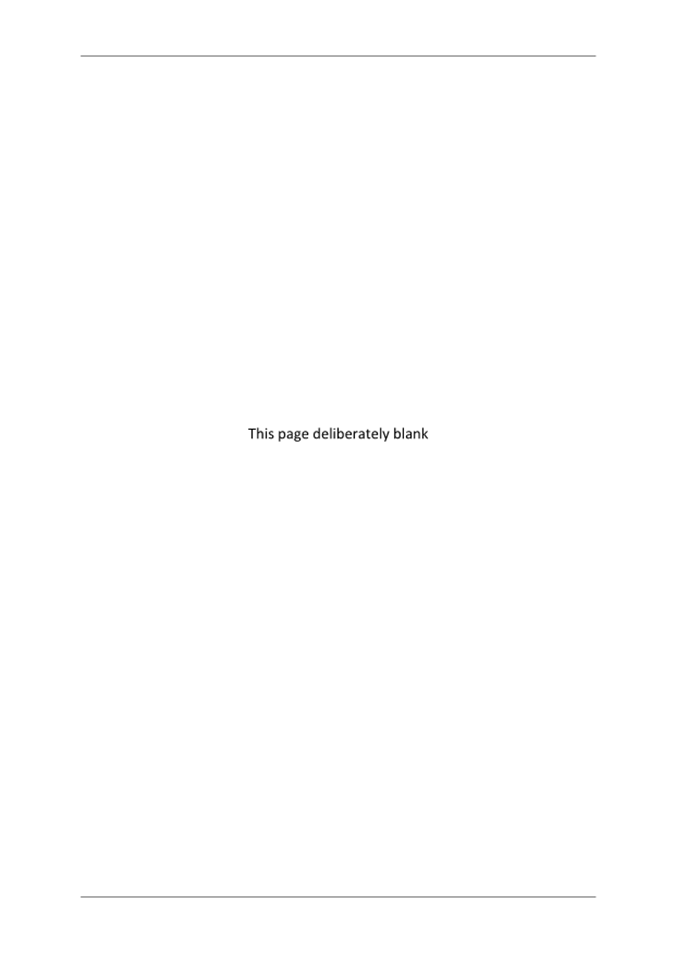
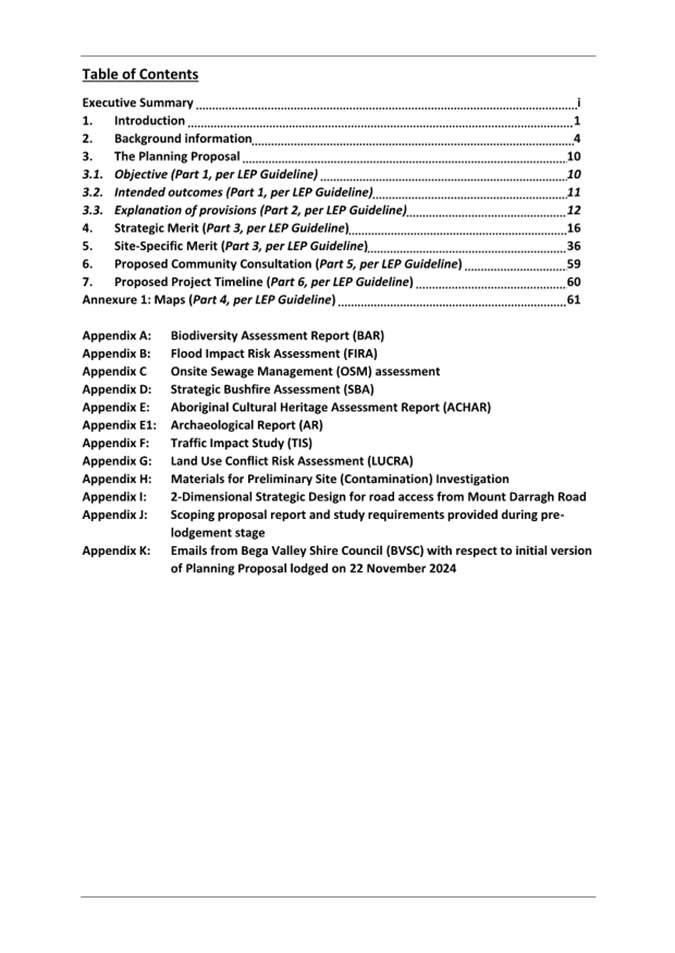

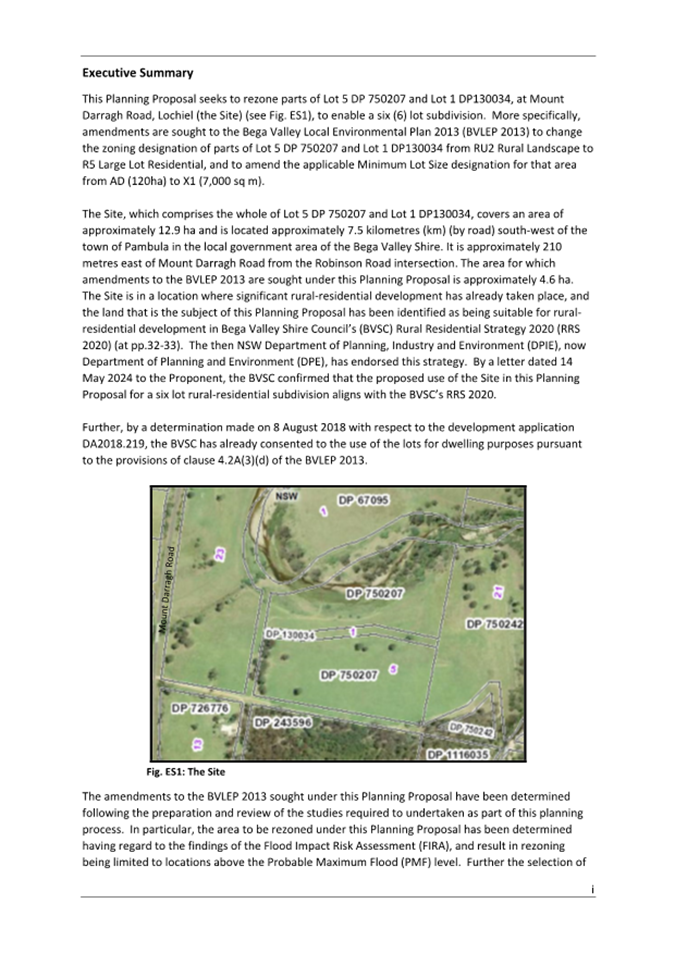
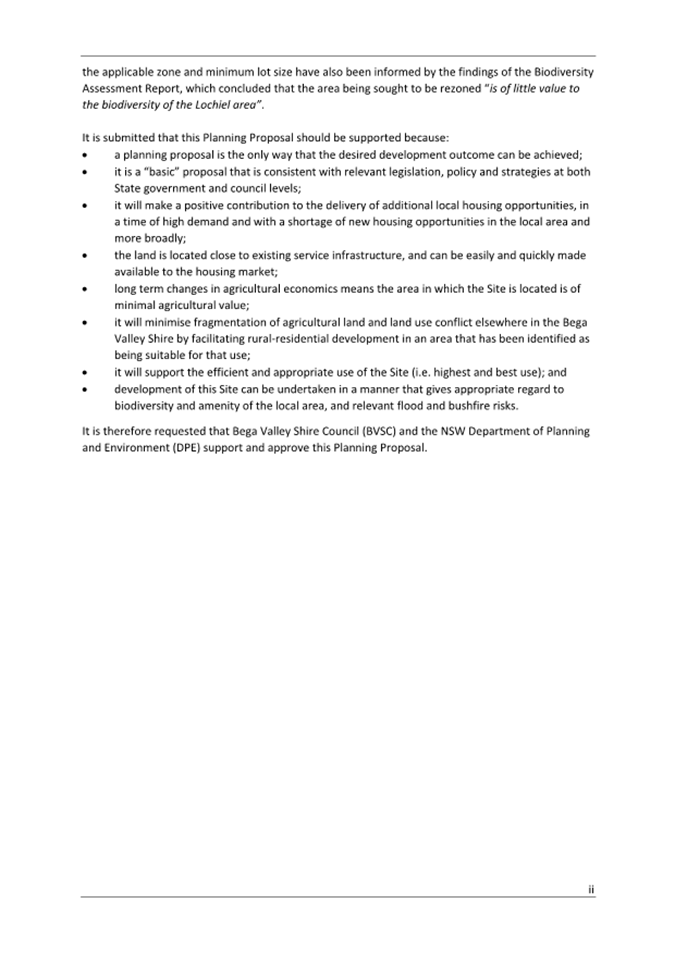
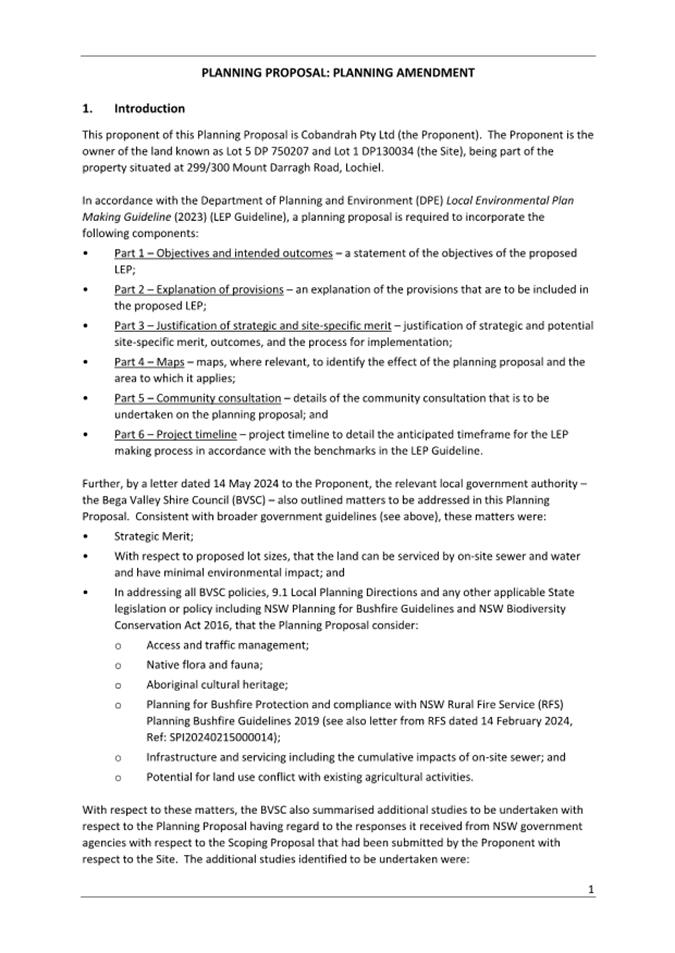
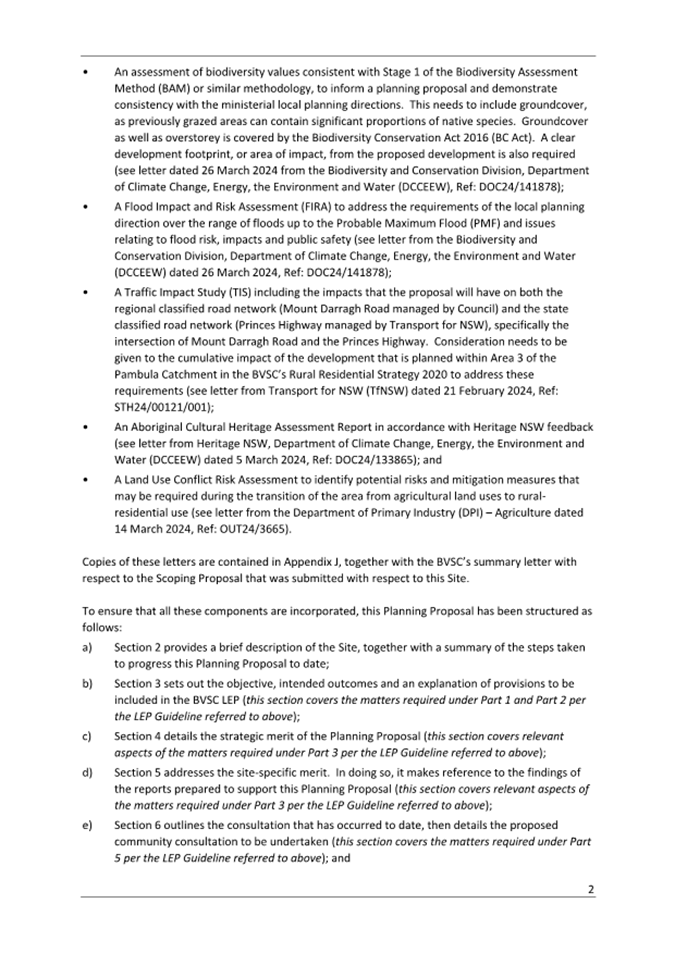
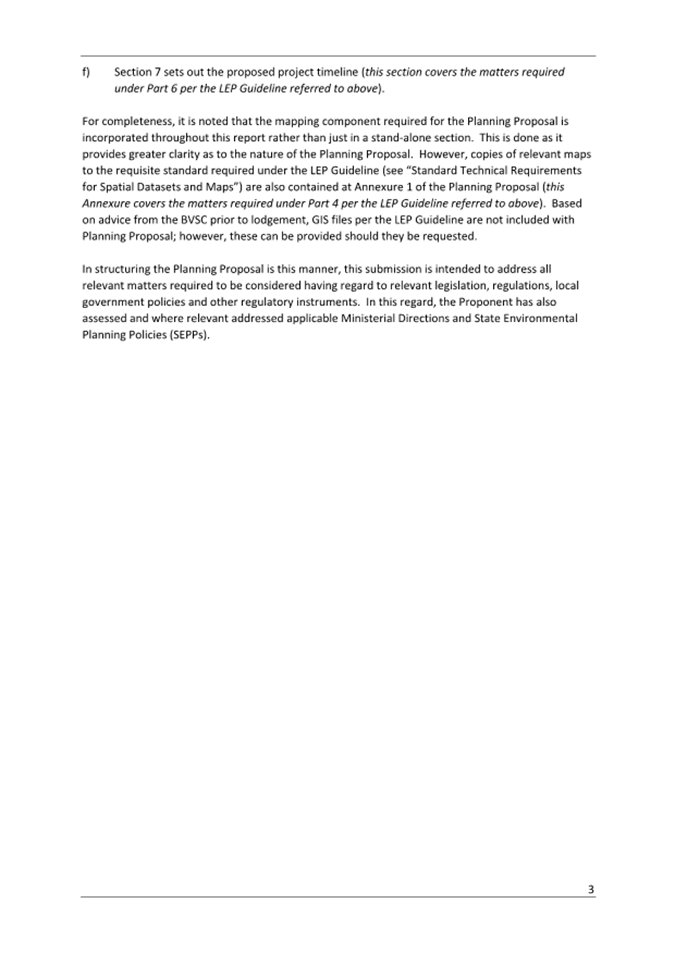
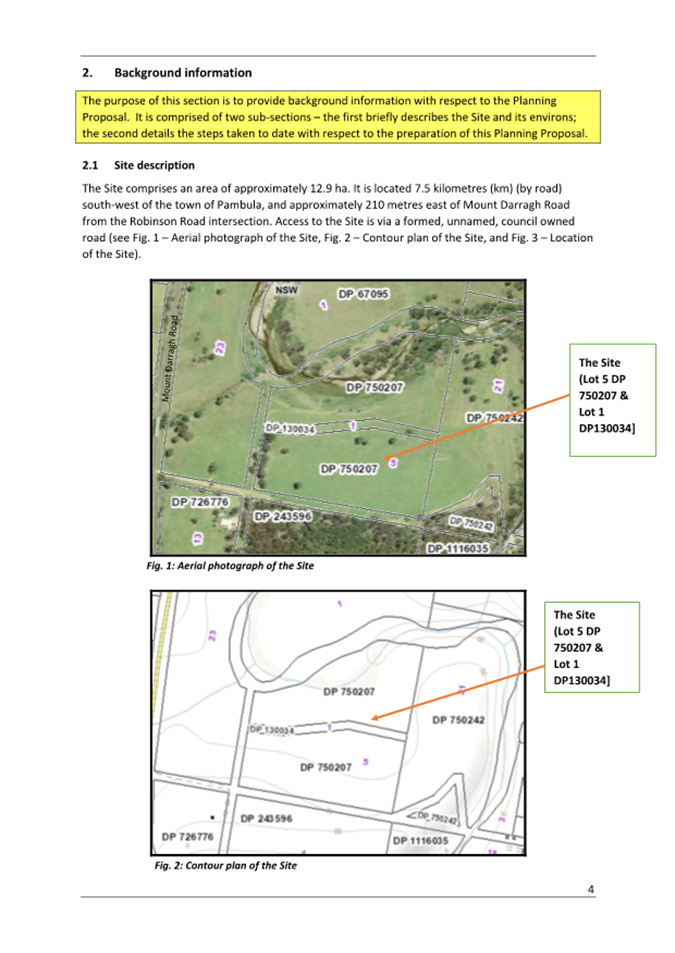
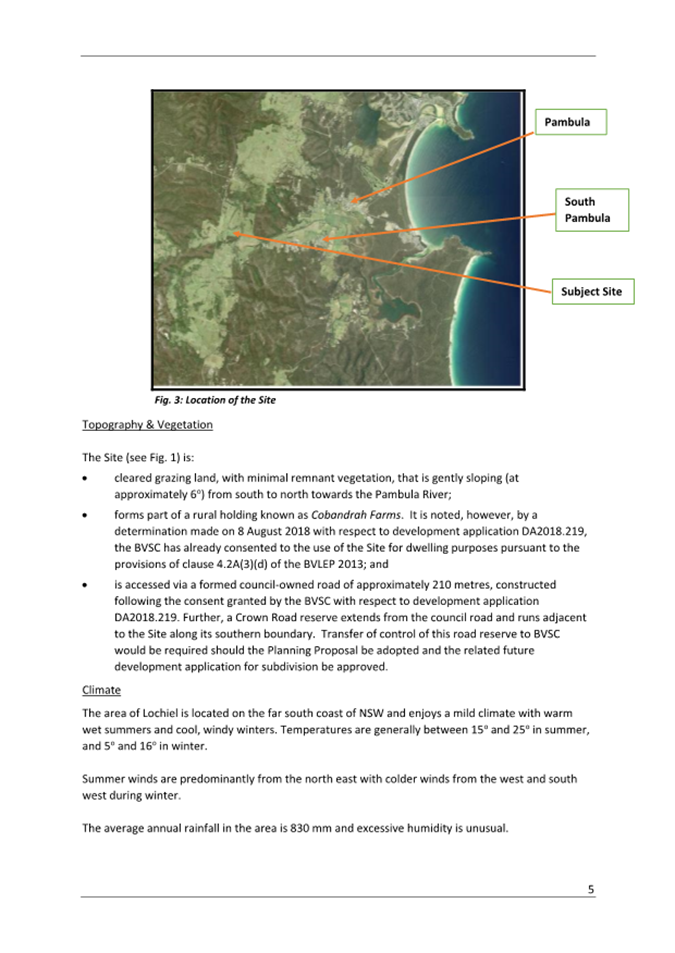
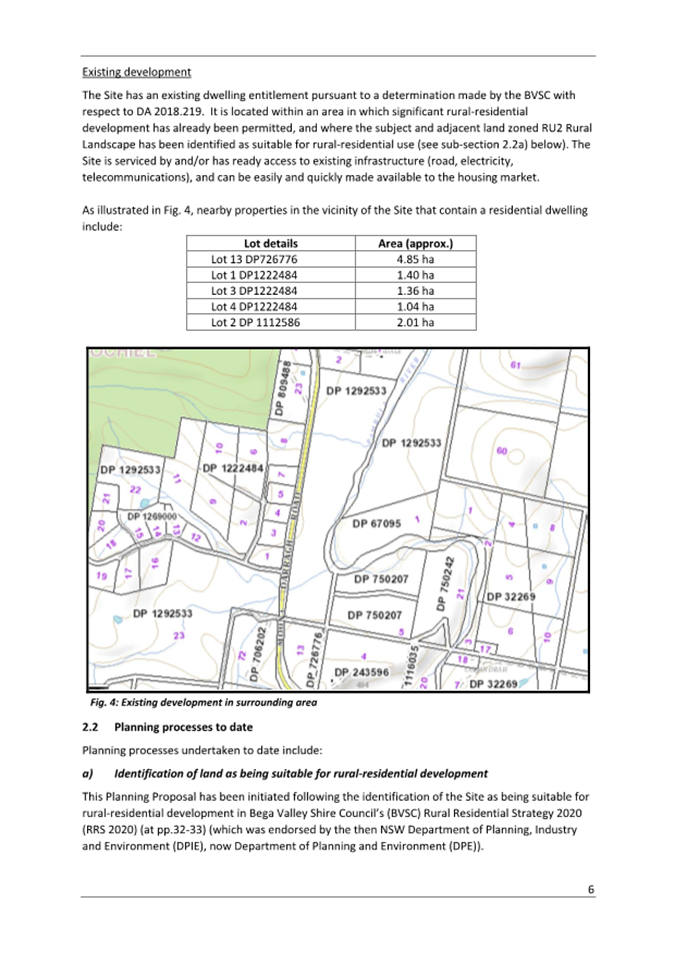
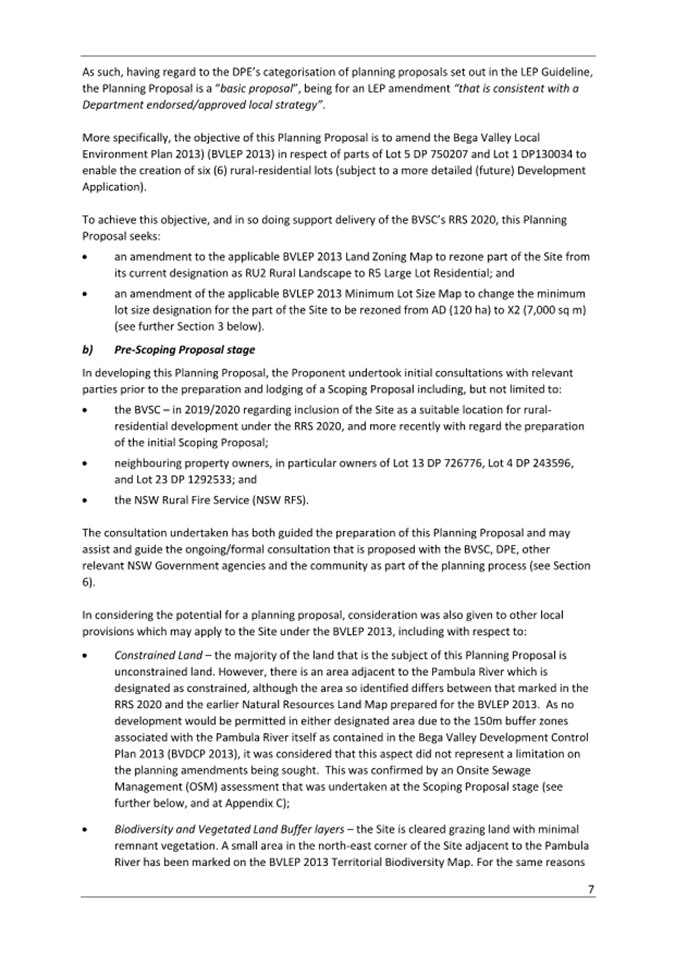
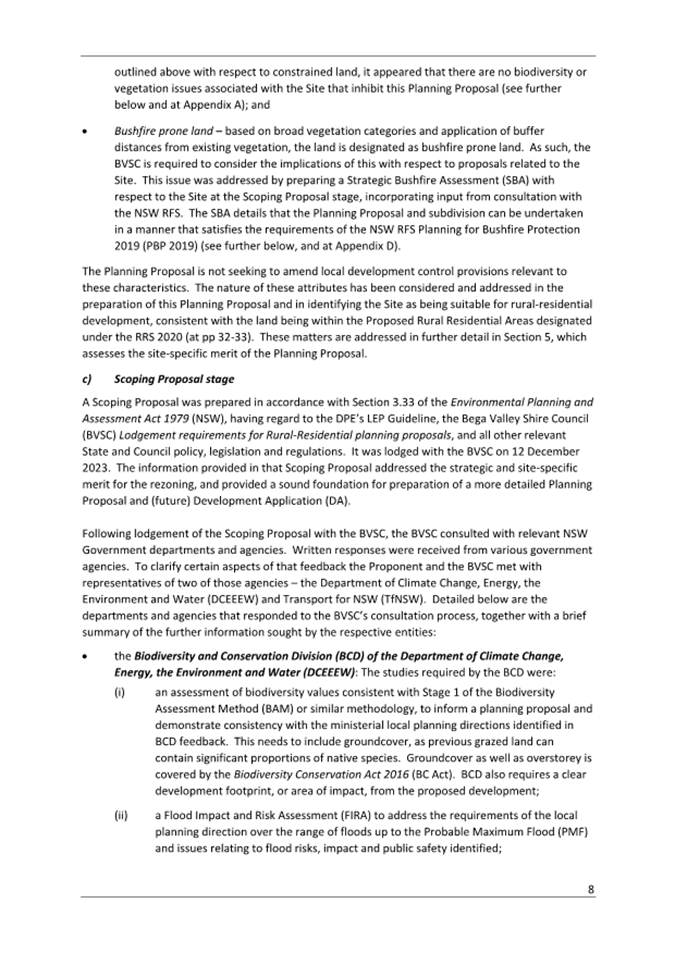
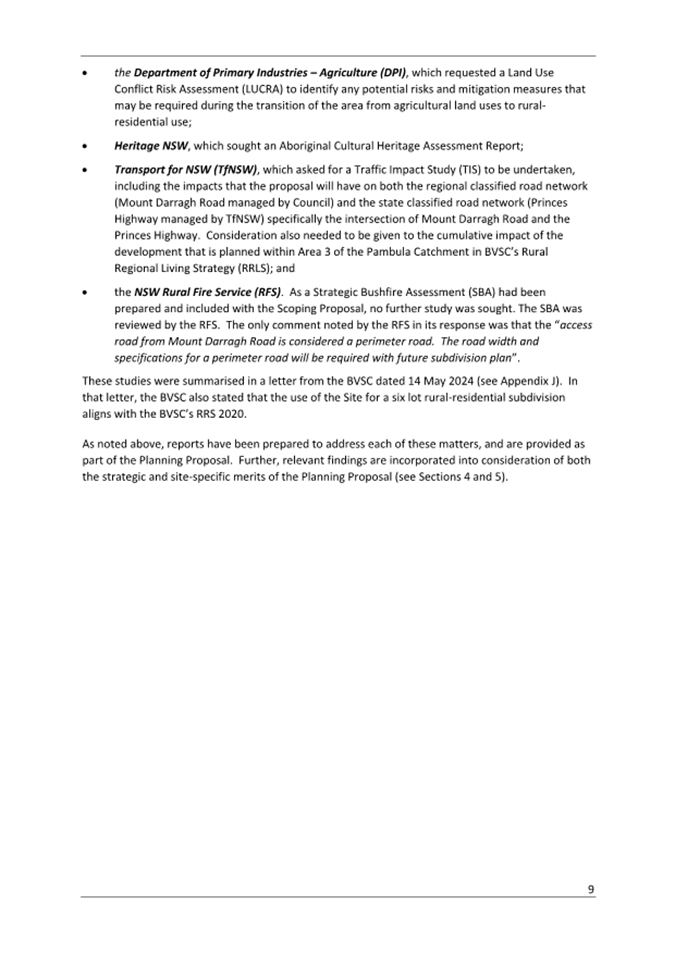
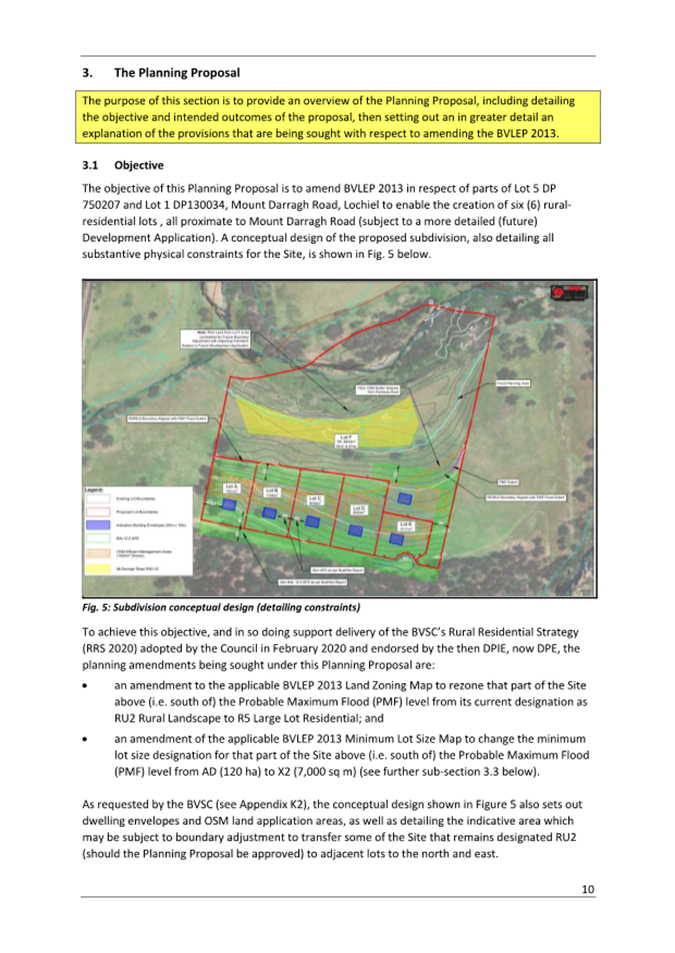
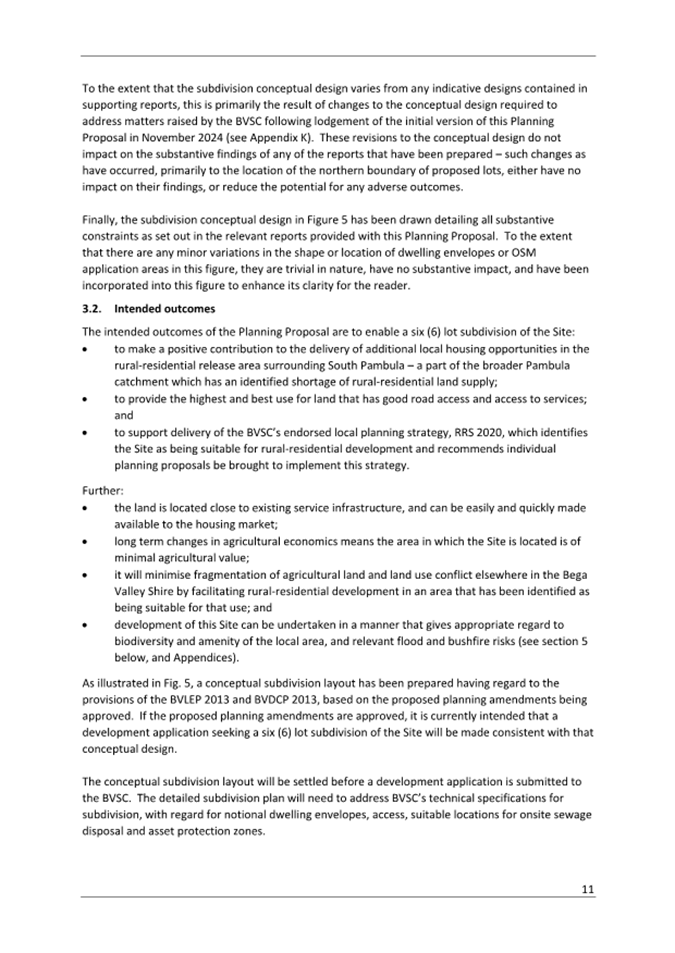
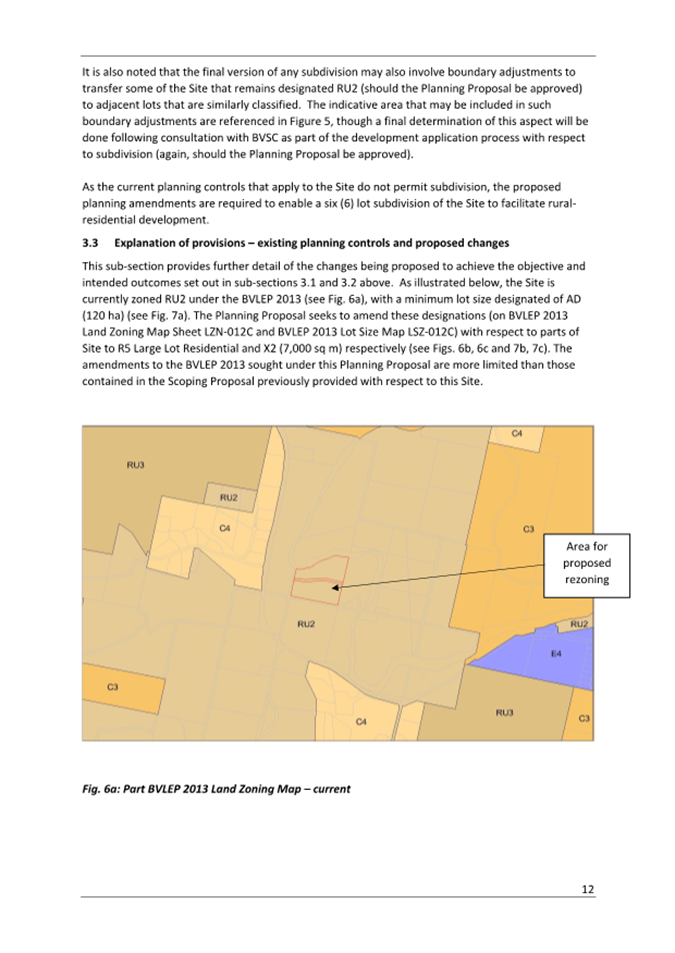
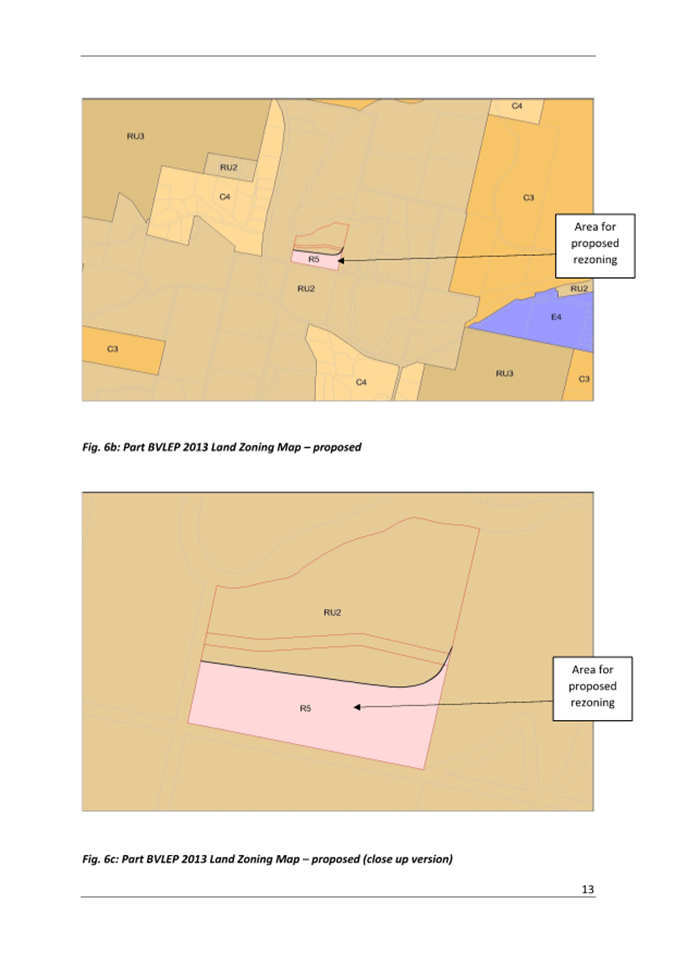
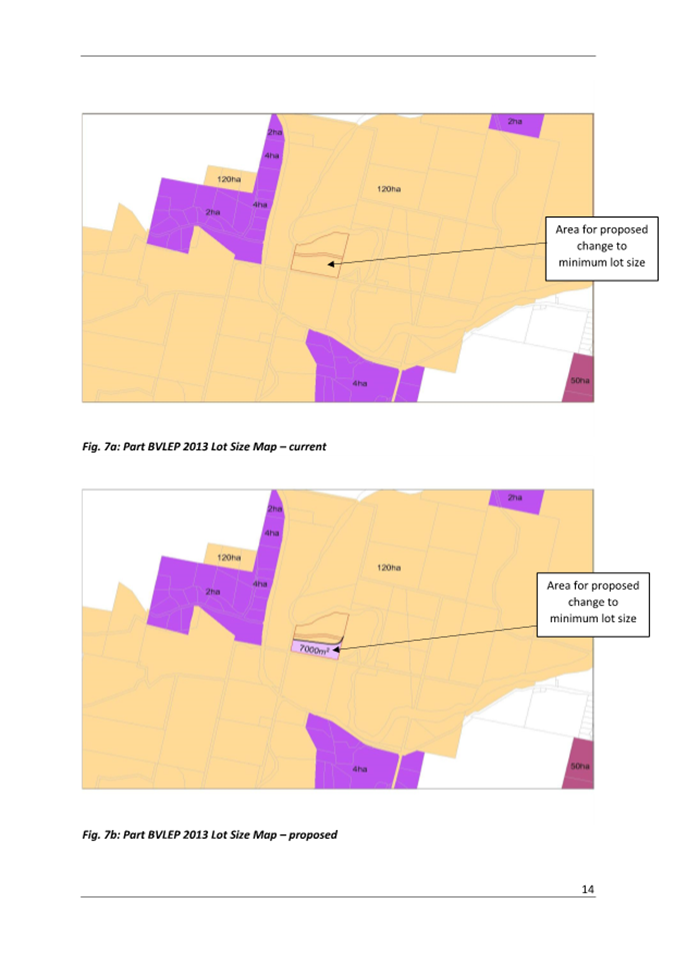
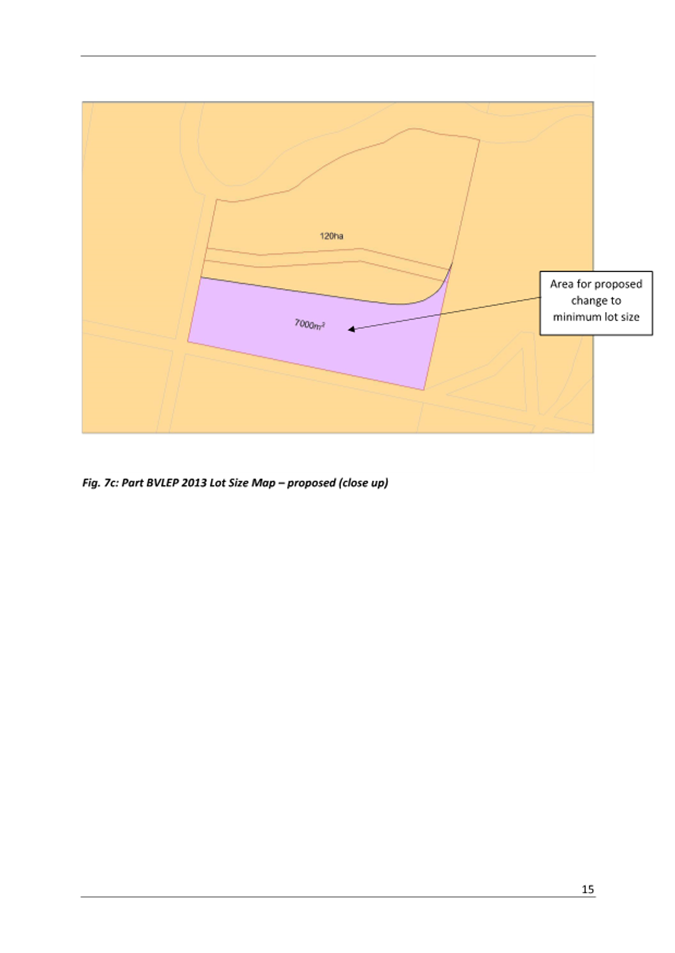
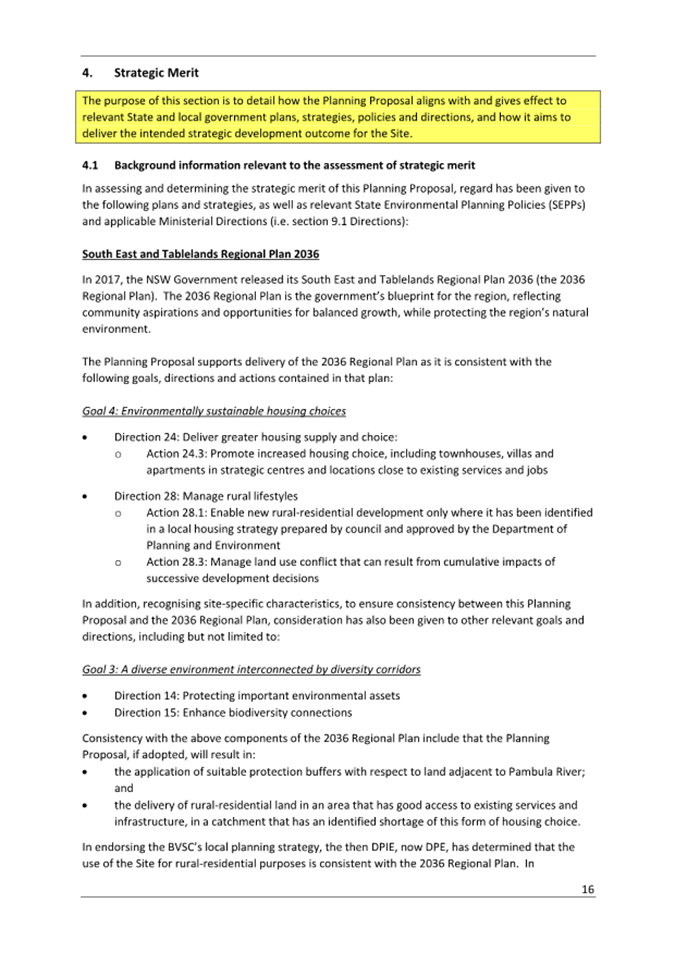
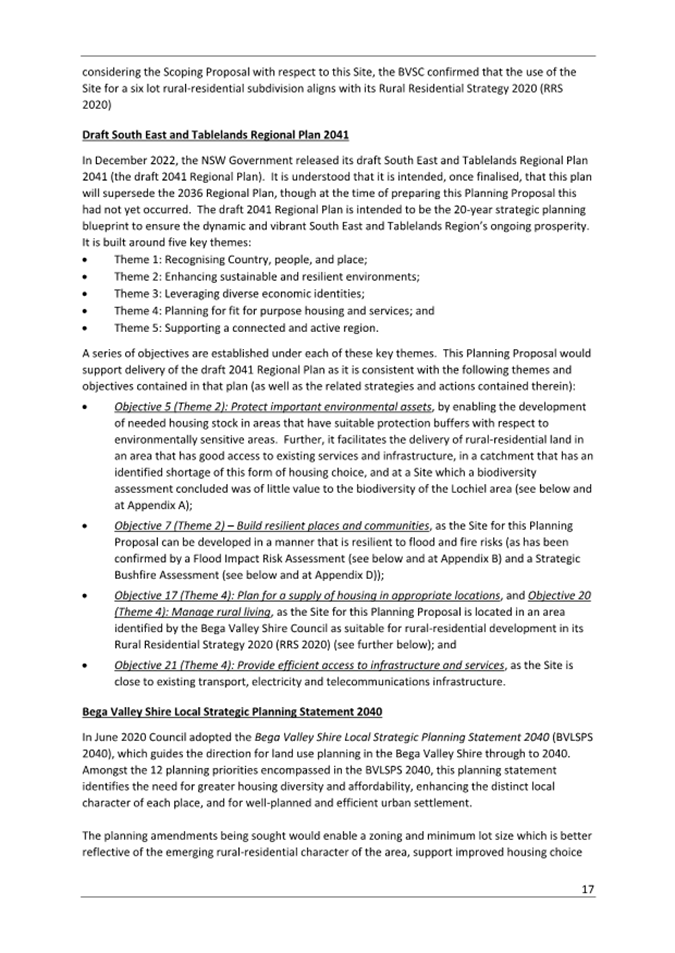
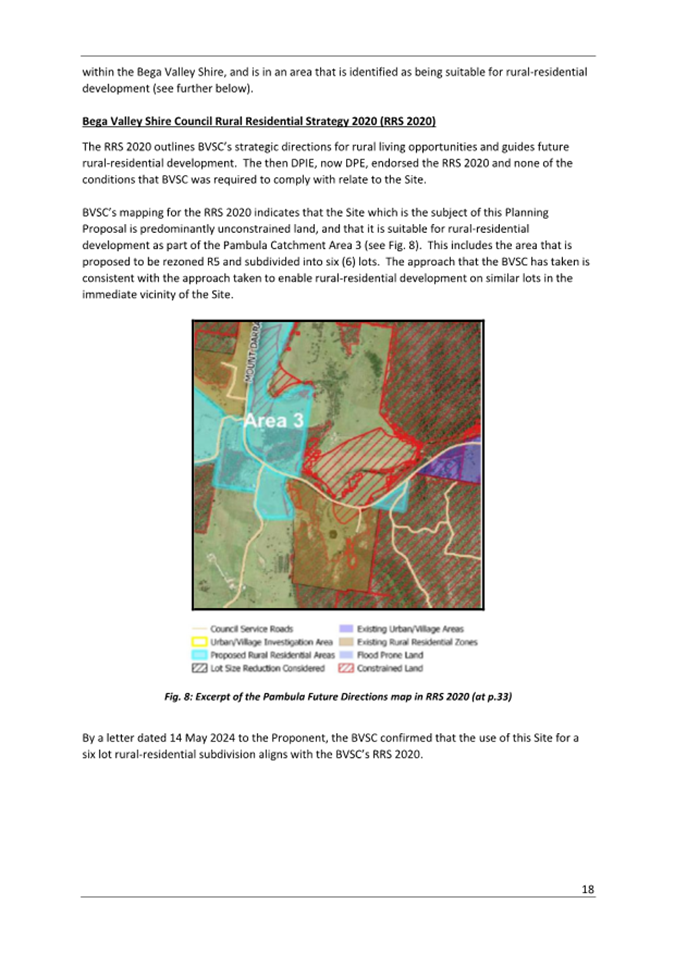
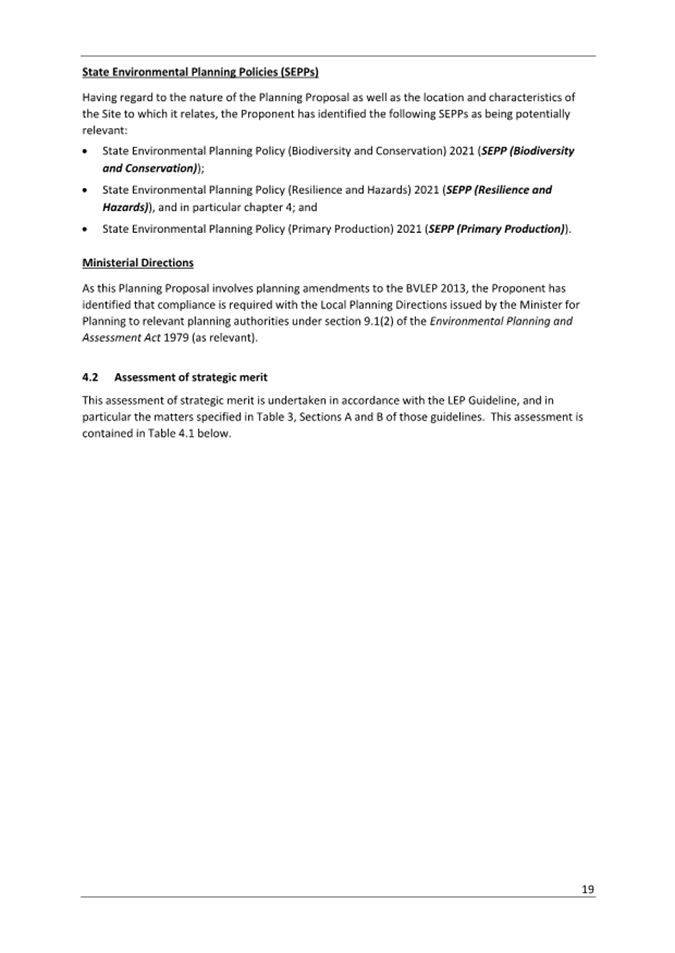
|
Item 8.3 |
8.3. Draft Affordable Housing Contributions Policy
This report presents a draft Affordable Housing Contributions Policy for Council’s consideration.
Director Community Environment and Planning
1. That Council places the draft Affordable Housing Contribution Policy (Attachment 1) on public exhibition for a period of 42 days.
2. That a further report be presented to Council on submissions received following the public exhibition.
Executive Summary
Affordable housing contributions capture a small portion of the value uplift that is gained when land is rezoned and allocate this to the provision of affordable housing. The Bega Affordable Housing Feasibility Analysis demonstrated there is an opportunity for Council to levy affordable housing contributions for certain proponent-led rezonings without adversely affecting development feasibility.
This report presents a draft Affordable Housing Contribution Policy (draft policy) for Council’s consideration and recommends that Council publicly exhibit the document prior to deciding whether to proceed to adopt the draft policy.
Background
Previous Council resolutions
At the Council meeting of 12 June 2024, Council considered a report on the preparation of a draft affordable housing contribution policy and resolved:
1. That Council note the Bega Affordable Housing Feasibility Analysis prepared by Atlas Economics (Attachment 1).
2. That Council resolve to prepare a draft Affordable Housing Contribution Policy.
3. That the draft Affordable Housing Contribution Policy be reported to Council for consideration when completed.
4. That staff seek feedback on the draft Affordable Housing Contribution Policy from the Affordable Housing Implementation Group prior to reporting it to Council ahead of public exhibition.
Planning Framework
A planning proposal is a document and supporting information that explains the intended effect and justification of a proposed Local Environmental Plan (LEP) or amendment to an LEP. In NSW, a planning proposal is the key document used to propose a rezoning or change to development standards.
Under the current NSW planning framework, affordable housing contributions can only be charged in specific circumstances by either a scheme or a policy that meets the legislative requirements of Section 7.32 of the Environmental Planning and Assessment Act 1979 (EP&A Act).
Affordable housing contributions policies apply to proponent-led planning proposals and provide the basis for planning agreement negotiations; their objective is to send a signal to the market of a council’s intention. The alternative mechanism, affordable housing contributions schemes, only apply to specific sites and are incorporated into a clause of the Bega Valley Local Environmental Plan 2013. The two mechanisms are complementary, in that any land included in a scheme is excluded from a policy.
Affordable housing contributions can only be applied when additional residential development capacity is created by rezoning or other amendments to planning controls, such as increased height of buildings limits or floor space ratios, in areas where there is an identified need for affordable housing, and it has been demonstrated that imposing the contribution is feasible. The State Environmental Planning Policy (Housing) 2021 identifies there is a need for affordable housing across all of NSW.
The Bega Affordable Housing Feasibility Analysis prepared by Atlas Economics demonstrates that levying contributions via an affordable housing contributions policy can be undertaken without adversely affecting development feasibility in some situations and locations in the Bega Valley Shire. More specifically, these situations include increasing residential capacity in coastal locations, such as increasing the height of buildings limits or the floor space ratio and decreasing the minimum lot size (allowing for more subdivision potential) in any location.
Policy purpose
The draft policy provides the background for, and sets out, where and how much contributions toward affordable housing are required in circumstances of proponent-led planning proposals.
Council acknowledges the importance of the not-for-profit community housing sector and the part they play in the delivery and management of purpose-designed and built affordable housing. The affordable housing provided through implementation of the Policy will be rented to households on very low to moderate incomes and be located where there is access to public transport, services, shops and facilities.
Affordable housing contributions are required in addition to other statutory fees and charges, including local infrastructure contributions (s7.11 or s7.12), state and regional infrastructure contributions (if applicable) and water and sewerage infrastructure charges.
Application of the Policy
The draft policy applies to planning proposals that seek to amend the Bega Local Environmental Plan 2013 to increase the residential capacity of the land. In these circumstances, Council will seek a proportion of residential floorspace or a proportion of residential land (as is applicable), as a contribution to affordable housing. The contribution may also be provided as an equivalent monetary contribution. Types of amendments to which the draft policy may apply include:
• Change in land use zone
• Increase in residential density (including change to floor space ratio, height of buildings, or minimum lot size controls)
• Insertion of additional permitted use.
The draft policy does not apply to land that is subject to an Affordable Housing Contribution Scheme or where there is a requirement for development to make an affordable housing contribution under other legislation. The draft policy does not apply to some types of residential development that may be enabled by a planning proposal such as social and affordable housing, including boarding houses, group homes or hostels.
Methods of contribution
The draft policy details that Council will accept affordable housing contributions in the form of monetary contributions, completed dwellings or land, depending on the individual circumstances.
The method of contribution must be acceptable to Council and its nominated community housing provider (CHP). Completed dwellings or land dedicated under the Policy must meet specified requirements and is also subject to Council’s discretion and approval in consultation with its nominated CHP.
Contribution rates
A contribution rate (%) is the proportion of a residential development required as affordable housing. For example, if a contribution rate of 2% is required, that would mean a 100-lot residential subdivision would be required to contribute 2 serviced residential lots to affordable housing.
Feasibility modelling (using the Residual Land Value method) was undertaken to test the impact of an affordable housing contributions on project viability in the Bega Valley Shire. The purpose of the testing was to assess whether development was still viable if affordable housing contributions were applied at various rates.
The modelling found that a contribution rate of 2% was feasible for planning proposals to reduce the minimum lot size (allowing more subdivision), and a contribution rate of 1% was feasible for planning proposals to increase residential capacity via other means, such as increasing building height or floor space ratio, but only in coastal areas. These contribution rates are outlined in Table 1 below.
Table 1: Contribution Rate (%) by Location and Development Type on full implementation of the Policy
|
Location |
Reduced Minimum Lot Size |
Increased Residential
Capacity |
|
Coastal |
2% |
1% |
|
Inland |
2% |
Not Applicable |
|
Examples |
Reduced Minimum Lot Size |
Increased Height of Buildings or Floor Space Ratio Limit |
Where the contribution is to be cash instead of land, the payment must equal the cost of the land required. This is called an equivalent contribution rate ($). For example, if 2 residential lots are required, the equivalent monetary contribution is the market value (or sale prices) of those lots.
The equivalent contribution rates ($) shown in Table 2 below are based on the market value of the residential development type that would be enabled by the planning proposal. NDA means Net Developable Area, and GFA means Gross Floor Area. Both terms are commonly used in the development industry and are defined in the draft policy.
Table 2: Equivalent Contribution Rate ($) by Location and Development Type
|
Location |
Reduced Minimum Lot Size (≥3000sqm) |
Reduced Minimum Lot Size (<3000sqm) |
Increased Residential Capacity (Other than Reduced Minimum Lot Size) |
|
Coastal |
$144/Sqm NDA |
$495/Sqm NDA |
$6,800/Sqm GFA |
|
Inland |
$112/Sqm NDA |
$300/Sqm NDA |
Not Applicable |
Phasing-in period
The draft policy implements a phased introduction of contributions over a six-year period.
This approach assists with development feasibility because it allows:
· developers to factor-in the contribution requirement into their feasibility studies and negotiations with landowners, ensuring that an appropriate price is paid for a development site; and
· natural market growth results in a lift to revenue levels, helping to offset the additional cost of the contribution.
Table 3 below outlines the phase-in period of contribution rates (%).
Table 3: Phase-in Period of Contribution Rates (%)
|
Year of Commencement (From Council Adoption) |
Planning Proposal Type |
|
|
Reduced Minimum Lot Size |
Increased
Residential Capacity |
|
|
Year 1 |
Nil |
Nil |
|
Year 2 |
0.5% |
0.5% |
|
Year 3 |
1.0% |
1.0% |
|
Year 4 |
1.0% |
1.0% (Fully Implemented) |
|
Year 5 |
1.5% |
|
|
Year 6 |
2.0% (Fully Implemented) |
|
Making a Contribution
Affordable housing contributions are executed via a planning agreement and are subject to the requirements of Council’s Voluntary Planning Agreements (VPA) Policy. The ordinary process of VPAs would apply, culminating in the planning agreement being registered on the land title. After the LEP amendment is finalised, contributions will be payable at the following stages of development:
• For planning proposals that reduce the minimum lot size – prior to the release of the subdivision certificate.
• For planning proposals that increase residential capacity (other than reducing the minimum lot size) – at the construction certificate stage.
Options
Options available to Council are to:
1. Resolve to exhibit the draft policy. This option would enable Council to seek feedback from the community and development industry on the draft policy.
2. Resolve not to exhibit the draft policy. This option is not recommended because it has been demonstrated that requiring contributions for affordable housing is feasible in some circumstances, and funds collected would be allocated to the provision of affordable housing in the Bega Valley Shire.
Community and Stakeholder Engagement
Engagement undertaken
A Councillor workshop was held on 8 February 2023 to inform Councillors of the legislative framework for local infrastructure funding of developer contributions. A representative of Atlas Economics presented the findings of the Affordable Housing Contributions Feasibility Study at a Councillor workshop on 3 April 2024. The study and Councillor presentation was circulated to Councillors and members of the Affordable Housing Implementation Group via email on 22 May 2024.
As part of preparing the draft policy, Atlas Economics liaised with representatives from Southern Cross Housing, a Tier 1 community housing provider that operates in the Bega Valley Shire, on 3 October and 29 November 2024. Homes NSW (formerly Land and Housing Corporation) was also consulted on 15 October 2024. Both Southern Cross Housing and Homes NSW are also members of the Affordable Housing Implementation Group.
A Councillor workshop on the draft policy was held on 4 December 2024. The draft policy was circulated to the Affordable Housing Implementation Group via email on 13 February 2025.
Engagement planned
Draft policies are required to be publicly exhibited for a minimum of 42 business days in accordance with the provisions of Council’s policy 6.01 Governance and procedure 6.01.1 Policy and procedure creation or amendment. Should the draft policy be endorsed by Council for public exhibition, it is proposed to provide information about the draft policy through Council’s newsletter, website, media release and social media and via email to the Development Professionals Group.
Members of the community will be encouraged to provide feedback through Council’s ‘Have Your Say’ webpage.
If/when the policy is adopted, Council staff will begin the process to enter into an agreement with a community housing provider to maximise the benefits of any contributions received.
Financial and Resource Considerations
The project was funded through local infrastructure contributions plan revenue as part of the $160,000 budget allocation to “develop and deliver a new local infrastructure contributions plan and planning agreement policy, including investigation and development of an affordable housing contributions policy”. Development of the Draft Affordable Housing Contributions Policy was included in the existing budget allocation for this project.
Legal /Policy
Affordable housing contributions are levied under section 7.32 of the Environmental Planning and Assessment Act 1979.
Impacts on Strategic/Operational/Asset Management Plan/Risk
Strategic Alignment
The draft policy aligns with the strategic objective of the Bega Valley Community Strategic Plan 2042: ‘Our local civic leadership is strong, consultative and responsive to our community’s needs’.
The draft policy aligns with Planning Priority 11 Housing: ‘Residential areas provide a range of housing styles, sizes and tenures that suit people of all ages, income levels and household sizes and enable communities to stay connected and healthy as people move through the various stages in life.’
The draft policy will deliver Strategy 12 of the Bega Valley Shire Affordable Housing Strategy: “Council will develop a Planning Agreement Policy under section 7.4 of the Act, whereby Council can capture part of the uplift associated with land value uplift arising from Planning Proposals to amend LEP provisions, and/or proposed variations to planning controls.
The draft policy aligns with the key response area of the Bega Valley Shire Climate Resilience Strategy: Safe, healthy and inclusive community.
Environment and Climate Change
Application of the draft policy will not have an adverse impact on the environment.
Economic
Application of the draft policy will provide a source of funding for affordable housing projects in the shire.
Risk
Risks to Council from the application of the draft policy will be addressed through development of an appropriate governance framework for the collection and expenditure of funds received.
Social / Cultural
Application of the draft policy will provide a source of funding for the provision of affordable housing that will benefit members of the local community.
Attachments
1⇩. Draft Affordable Housing Contributions Policy
|
Item 8.4 |
8.4. Development of a Local Approvals Policy for moveable dwellings
This report responds to a Notice of Motion by Cr Daly regarding the potential for development of a Local Approvals Policy (LAP) under the Local Government Act 1993 for moveable dwellings.
Director Community Environment and Planning
That Council:
1. Note the report regarding development of a Local Approvals Policy for moveable dwellings.
2. Note staff will present a draft Local Approvals Policy to Council for review and consideration at a later date.
Executive Summary
This report responds to the Council resolution for staff to explore options for the development of a Local Approvals Policy in response to a draft policy put forward by Cr Daly through a Notice of Motion at the 18 December 2024 Council meeting.
The Notice of Motion (available at Attachment 1) states it is proposing to use the provisions of the Local Government Act 1993 to develop a Local Approvals Policy to ‘allow moveable dwellings and associated structures being used solely for crisis accommodation to be DA exempt while still meeting acceptable amenity and safety standards for the occupants of such dwellings’.
A Local Approvals Policy is a policy document that enables councils to specify the criteria which the council must take into consideration in determining whether to give or refuse an approval for certain activities as specified under section 68 of the Local Government Act 1993. A Local Approvals Policy may also provide for certain activities to be exempt from needing section 68 approval. A Local Approvals Policy cannot override the provisions of the Environmental Planning and Assessment Act 1979 (EP&A Act). As such, the proposed Local Approvals Policy would not facilitate its intended outcomes in its current form.
Background
At the 18 December 2024 ordinary Council meeting it was resolved:
1. That Council staff provide a report to Council on the benefits, opportunities and risks of developing a Local Approvals Policy to provide exemptions for moveable dwellings being used solely for crisis accommodation. This report should identify any resourcing or budgetary impacts, as well as any other considerations and impacts. The report would be due to be provided at Council’s meeting in March 2025.
2. That Council staff review the attached draft Local Approvals Policy (LAP) and provide feedback to Council as part of the report in point 1.
3. That staff seek feedback from the Affordable Housing Implementation Group on the above two items and report all feedback to Council as part of the report identified in point 1.
The Local Approvals Policy presented by Cr Daly at the 18 December 2024 Council meeting is available at Attachment 2.
Legislative framework
A Local Approvals Policy is an instrument available to councils under the Local Government Act 1993 (LG Act) to regulate certain matters as specified in section 68 of the Act, such as outlining the criteria which the council must take into consideration in determining whether to give or refuse an approval. The policy may also provide for certain activities to be exempt from needing section 68 approval altogether, subject to the consent of the ‘Departmental Chief Executive’ (currently the Secretary of the Department of Planning, Housing and Infrastructure). Matters specified under Section 68 include the installation of a manufactured home, moveable dwelling or associated structure on land.
However, it is important to note that a Local Approvals Policy cannot override the provisions of the EP&A Act. This means that development consent for the use of the land would still be required from Council to satisfy the requirements of the EP&A Act, even if a Local Approvals Policy was in place that made the activity exempt under the LG Act.
The Local Government (Manufactured Home Estates, Caravan Parks, Camping Grounds and Moveable Dwellings) Regulation 2021 (LG Regulation) provides that council approval is not required for installation of a caravan in association with a dwelling, where the caravan is used by members of the same household.
The proposed Local Approvals Policy tabled by Cr Daly is centered on the term ‘moveable dwelling’. Moveable dwelling is defined under the Local Government Act 1993 and means:
“(a) any tent, or any caravan or other van or other portable device (whether on wheels or not), used for human habitation, or (b) a manufactured home.”
While a caravan, campervan or tent could reasonably be considered an ancillary development (being subservient) to the dominant dwelling house land use and would therefore not require a separate consent under the EP&A Act, a manufactured home could not be considered ancillary. Moveable dwellings either may or may not be ancillary to a dwelling house depending on the circumstances including the type of moveable dwellings. Being a substantial and self-contained house that serves its own purpose, it could not reasonably be characterised as a subservient use. A manufactured home would instead be considered an independent use on the same land requiring development consent under the EP&A Act.
Further, as part of its proposed new regulatory framework for prefabricated and manufactured buildings, the NSW Government has signaled its intention to remove manufactured homes from the LG Act (and from the definition of moveable dwelling) and treat them as building works. If this occurs, manufactured homes would be governed by the EP&A Act and Building Code of Australia, which means a local approvals policy could not be used for this type of housing. The latest update from the government suggests further information will be available in mid-2025.
Council could consider exempting moveable dwellings from needing section 68 approvals under the LG Act in certain circumstances, however detailed requirements would need to be developed relating to water and sewer connections, onsite sewage management systems, footings and smoke alarms. Additionally, Council would need to consider which zones it would be appropriate to do this in, as well as consider how to manage hazards such as bushfire, flooding, and land contamination. Without this work, exempting crisis housing from s68 approvals could result in unreasonable risk to health, safety and the environment. As previously stated, this would not turn off the requirement for development consent for the use of the land under the EP&A Act.
The draft Local Approvals Policy provided through the Notice of Motion does not provide adequate parameters to manage these risks, and a significant amount of additional work / staff time would be required to determine the appropriate settings.
Existing exemptions
Clause 77 of the Local Government (Manufactured Home Estates, Caravan Parks, Camping Grounds and Moveable Dwellings) Regulation 2021 provides the following exemptions:
(a) 2 caravans or tents if they are not occupied for—
(i) more than 2 consecutive days, and
(ii) more than 60 days in a 12 month period,
(b) 1 caravan on land occupied by the owner of the caravan in connection with the owner’s dwelling house if the caravan is—
(i) used for habitation only by the owner or members of the owner’s household, and
(ii) maintained in a safe and healthy condition,
(c) a caravan on pastoral or agricultural land if the caravan is merely occupied seasonally by persons employed in pastoral or agricultural operations on the land, or
(d) a moveable dwelling or associated structure on land to accommodate a person who has been displaced as a result of a natural disaster if the moveable dwelling or associated structure is—
(i) maintained in a safe and healthy condition, and
(ii) removed within—
(A) 2 years after it is installed, or
(B) if the relevant local approvals policy for the moveable dwelling or associated structure specifies a longer period—the longer period.
(Source: https://legislation.nsw.gov.au/view/html/inforce/current/sl-2021-0461#sec.77)
It is important to note that this is limited to displacement due to a natural disaster rather than homelessness more broadly.
Construction standards
A separate but noteworthy matter is that both caravans and manufactured homes are subject to construction standards within state and national regulations. A Local Approvals Policy that does not require any council approval will not negate the requirement to comply with these standards.
As Councillors are aware, there is currently no pathway under the Local Government Act 1993 to approve some of the structures being sold as ‘tiny homes’ or ‘caravans’ – see Council report 13 December 2023 for details.
Other opportunities
Council officers have explored other potential avenues to facilitate the installation and habitation of a moveable dwelling for the purposes of crisis accommodation without requiring development consent. This included whether it would be appropriate to amend Schedule 2 ‘Exempt Development’ of the Bega Valley Shire Local Environmental Plan 2013 (BVLEP 2013), which specifies exempt development that may be carried out without the need for development consent under the EP&A Act.
Clause 1.6(2) of the EP&A Act defines exempt development as “development that is declared to be exempt … because of its minor impact”. The types of development typically classified as exempt development include signage, community gardens and murals (although some development relating to existing buildings [such as decks and patios] is classified as exempt development in some circumstances). However, because the likely impacts of installing and occupying moveable dwellings are not generally minor, the land use is not considered suitable for classification as exempt development.
Notwithstanding the above, Council staff are of the view that there is merit in pursuing development of a Local Approvals Policy to expand the range of options for use of certain types of moveable dwellings for accommodation, specifically caravans and campervans. Currently, the provisions of Section 77 (1) (b) of Local Government (Manufactured Home Estates, Caravan Parks, Camping Grounds and Moveable Dwellings) Regulation 2021 already exempt the installation of one caravan or campervan on land occupied by a dwelling used by members of the same household.
Council staff are investigating ways to expand the existing options for temporary housing through a Local Approvals Policy. These options include: expanding the exemption for one caravan in association with a dwelling house to two; permitting temporary accommodation in association with a new build or an existing business; and to extend the provisions for persons displaced by a natural disaster from two years to four.
This work is expected to be completed for presentation to Council in coming months, subject to resourcing. This work differs to that put forward in the draft Local Approvals Policy tabled at the 18 December 2024 Council meeting in that it would apply more broadly than crisis accommodation, however the policy would only seek to apply to caravans and campervans that do not require development consent under the EP&A Act. This work is happening within Council’s approved general fund budget and resourcing.
Options
1. 1.Council could resolve not to proceed with the draft Local Approvals Policy for Moveable Dwellings Providing Crisis Accommodation in the Bega Valley Shire as presented to Council on 18 December 2024, for the reasons outlined in this report. Concurrently, Council can resolve to note that a further report will be provided to Council with a recommended Local Approvals Policy for in the coming months. This is the recommended option for the reasons highlighted in this report.
2. Council could proceed to publicly exhibit the draft Local Approvals Policy for Moveable Dwellings Providing Crisis Accommodation in the Bega Valley Shire as presented to Council on 18 December 2024, prior to considering it for adoption. This option is not recommended as the policy would not have the intended effect as development consent would still be required for the land use consideration as required under the EP&A Act. Additionally, staff would need to seek advice from legal experts and the Department of Planning, Housing and Infrastructure to ensure the policy is lawful and achievable. This would likely result in changes being required to the policy as outlined in this report.
Community and Stakeholder Engagement
Engagement undertaken
The draft Local Approvals Policy as presented to Council on 18 December 2024 was distributed to the Affordable Housing Implementation Group for feedback the following day. Two responses were received in support of the draft policy. One submission recommended that crisis accommodation needs to be available for at least six months. The other response highlighted the need to clearly articulate compliance standards from the relevant legislation in terms of design criteria, provide clarity on applicable fees, the need for compliance certificates, and requesting reconsideration of the need for there to be an existing dwelling on the land. Consideration of these matters will require additional staff time and resources.
Engagement planned
No further engagement is planned on the draft proposed LAP provided as part of the 18 December 2024 Notice of Motion. The draft LAP currently being developed by staff will be exhibited, pending future Councillor endorsement, at a later date.
Financial and Resource Considerations
The Council officer review of the draft policy and preparation of this report was unplanned work that required staff to divert their time and resources from other projects. Reassigning tasks has an impact on service delivery for other projects committed to by Council.
Legal /Policy
Local Approvals Policies are an instrument available to councils under the Local Government Act 1993 to regulate certain matters as outlined in Section 68 of the Act.
A Local Approvals Policy cannot override the provisions of the Environmental Planning and Assessment Act 1979. As such, the proposed Local Approvals Policy is unable to be implemented in its current form.
While it is acknowledged the Bega Valley Shire is experiencing a housing shortage, Council has an obligation to ensure state legislation is complied with.
Impacts on Strategic/Operational/Asset Management Plan/Risk
Strategic Alignment
The draft policy is consistent with Planning Priority 11 of the Bega Valley Shire Local Strategic Planning Statement 2040: Residential areas provide a range of housing styles, sizes and tenures that suit people of all ages, income levels and household sizes and enable communities to stay connected and healthy as people move through the various stages in life.
Environment and Climate Change
The draft policy could result in unacceptable risks to the environment through the unregulated location of dwellings.
Economic
The draft policy could adversely impact Council’s budget should legal proceedings result from the implementation of the policy.
Risk
The draft policy presents significant risks to Council should Council not meet the requirements of the LG Act and EP&A Act to prevent unacceptable impacts to the environment and the community. Council regulates development and activities under these Acts and is accountable for its decisions and actions. The draft policy requires additional work to ensure risks to health, safety and the environment are appropriately mitigated.
Social / Cultural
The draft policy could result in unacceptable risks to the community through the unregulated location of dwellings in hazard prone areas. While it is acknowledged the Bega Valley Shire is experiencing a housing shortage, Council has an obligation to ensure housing is safe and appropriate.
Attachments
1. Notice of Motion from 18 December 2024
2⇩. Draft Local Approvals Policy presented by Cr Daly 18 December 2024
|
Council |
19 March 2025 |
|
Item 8.4 - Attachment 2 |
DRAFT Local Approval Policy presented by Cr Daly 18 December 2024 |
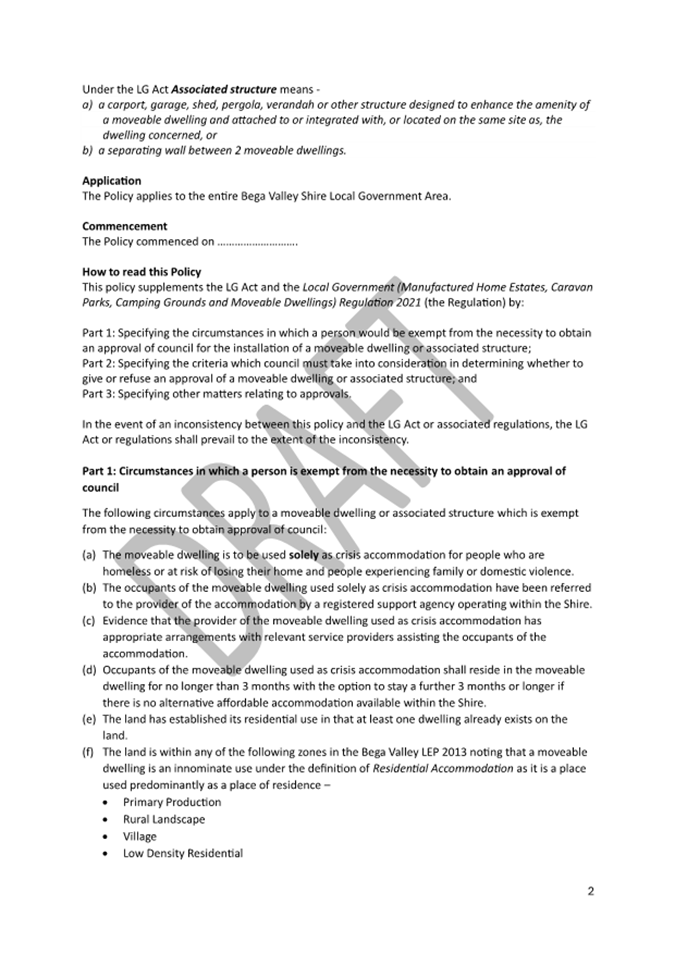
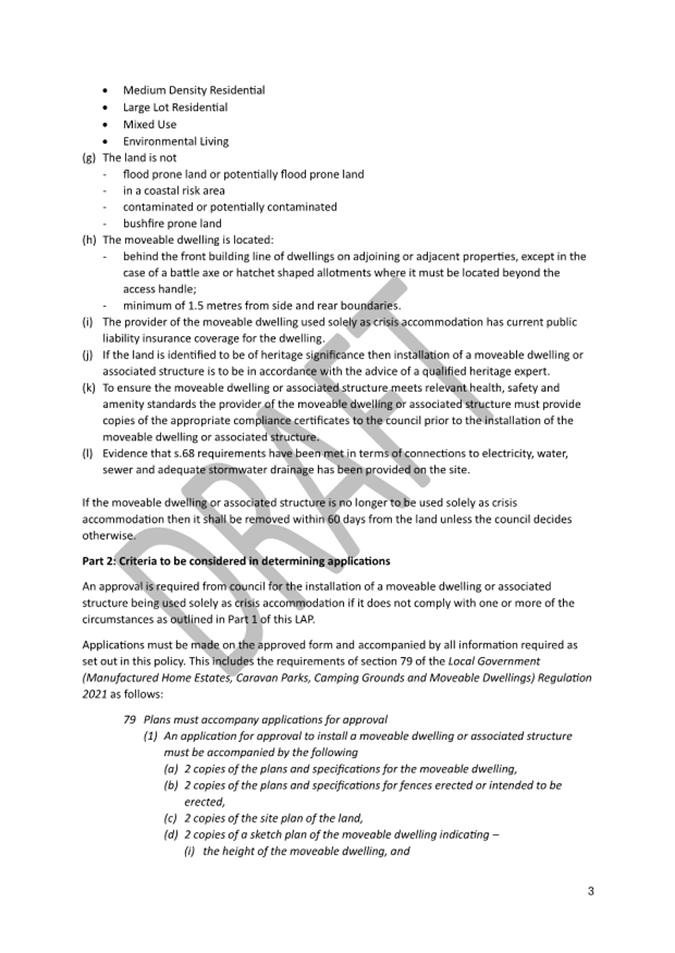
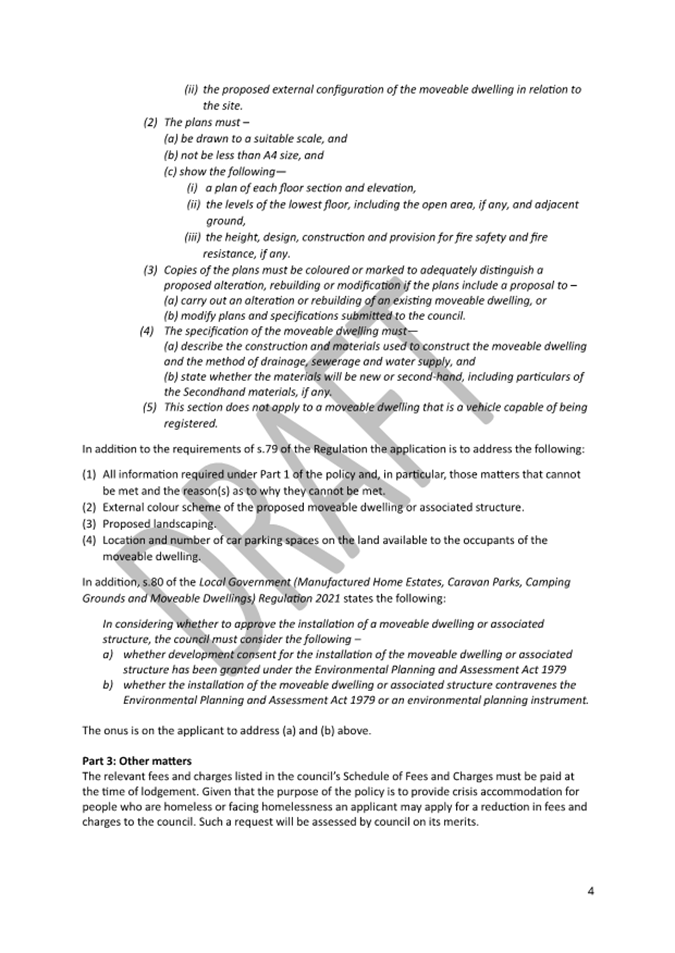
|
Item 8.5 |
8.5. 2022.352 Subdivision of land into 4 allotments - Lot: 21 DP: 843223 - 88 Kerrisons Lane BEGA
Director Community Environment and Planning
|
Applicant |
Caddey Searl & Jarman / TA Projects |
|
Owner |
Paul & Lisa Griffin |
|
Site |
Lot 21 DP 843223 – 88 Kerrisons Lane, Bega |
|
Zone |
R5 Large Lot Residential |
|
Site area |
5.386 hectares |
|
Proposed development |
1 into 4 lot subdivision |
Precis
This report provides Council with an update regarding Development Application 2022.352, after the subject site was inspected by Councillors as per the Council resolution of 19 February 2025.
The Applicant has requested Council defer consideration of the application to allow additional information to be provided for Council’s assessment.
That Council:
1. Defer consideration of Development Application 2022.352 for a 1 into 4 lot subdivision at Lot 21 DP 843223, 88 Kerrisons Lane, Bega to allow the Applicant to provide additional information to support the application, as requested by the Applicant.
2. Receive a further report at a later date, once any additional information has been received and assessed accordingly.
3. Advise the Applicant and Submitter of Council’s decision in relation to this matter.
Background
Development application 2022.352 was reported to the 19 February 2025 meeting of Council in accordance with Council Procedure 3.01.01 as staff recommended a merit-based refusal of the Development Application.
A copy of the previous report is available as Item 8.3 of the 19 February 2025 business paper, via this link: Agenda of Council - Wednesday, 19 February 2025
Deputations were received at the Public Forum on 19 February 2025 from the following persons:
Ms Melinda Wilton – FOR the staff recommendation
Mr Benjamin Mead – on behalf of TA Projects – AGAINST the staff recommendation
Mr Jason Heffernan – AGAINST the staff recommendation
Mr Paul Griffin – AGAINST the staff recommendation
At the Council meeting on the same day, Council resolved as follows:
|
20/25 |
RESOLVED on the motion of Crs Fitzpatrick and Allen That Council defer determination of Development Application 2022.352 for a 1 into 4 lot subdivision at Lot 21 DP 843223, 88 Kerrisons Lane, Bega to enable Councillors to conduct a site inspection prior to the matter being reported back to Council for consideration at the 19 March 2025 Council meeting. In favour: Crs Allen, Daly, Fitzpatrick, Haggar, Mudaliar, Nadin, Noble, O'Neil and Porter Against: Nil |
A site inspection was conducted on the morning of 26 February 2025. Councillors Allen, Daly, Haggar, Fitzpatrick, Mudaliar, Noble, O’Neil and Porter were in attendance and were accompanied by Council staff. Cr Nadin was an apology. Mr Paul Griffin (landowner) and Mr Jason Heffernan (TA Projects/applicant) were also onsite.
On 28 February 2025, Mr Jason Heffernan from TA Projects, on behalf of the landowner, wrote to the Director of Community, Environment and Planning seeking deferral of Council’s consideration of the application to enable the applicant to provide additional supporting information in relation to the proposal.
No objection is raised by staff to the requested deferral.
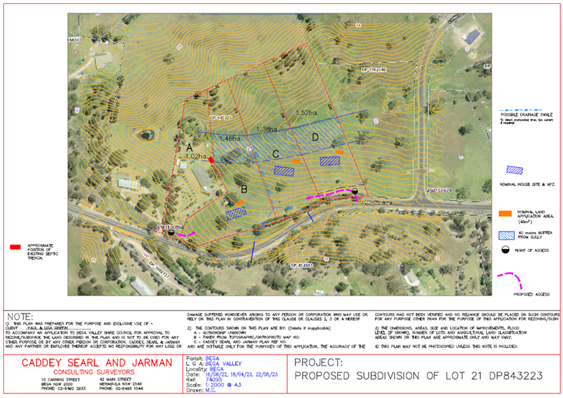
Figure 1 – Current Development Plan Proposal
Options
The following options are available to Council, in its consideration of this matter.
1. Defer consideration of the matter as requested by the applicant. This is the recommended option.
2. Refuse the application for the reasons outlined in the draft Notice of Determination provided as Attachment 3 to Item 8.3 of the 19 February 2025 business paper.
Community and Stakeholder Engagement
The original subdivision layout plan was exhibited in accordance with Council’s Community Participation Plan from the 16 January 2023 until 31 January 2023.
During this engagement process, Council received 1 submission.
The issues raised in that submission have been detailed and addressed in the Section 4.15 Assessment Report, provided as Attachment 2 of Item 8.3 of the 19 February 2025 business paper.
A full copy of the submission has been uploaded to the Councillor portal for information.
Financial and Resource Considerations
Assessing proposals for development is part of the regular business of Council and resourcing to undertake this function is included in Council’s adopted budget.
Legal /Policy
Refusal of the development application could be subject to an appeal in the Land and Environment Court, which would have cost implications to defend Council’s position.
Impacts on Strategic/Operational/Asset Management Plan/Risk
Strategic Alignment
The proposed development is consistent with the Bega Valley Local Strategic Planning Statement Planning Priority 11: Housing, residential land development principle 1 for Rural residential development.
Environment and Climate Change
The impacts of the development on the environment, including impacts on biodiversity and climate change, have been assessed and are detailed in the assessing officer’s Section 4.15 Assessment Report (Attachment 2 of Item 8.3 of the 19 February 2025 business paper).
Economic
The impacts of the development on the economy are considered minor. The subdivision lot layout is consistent with the minimum allotment size for the site and is therefore considered to maximise the lot yield available for the site.
Risk
The assessment of development is a core function of Council. There are no material impacts on Council’s operations associated with deferring determination of the proposed development. Refusal of the development application could be subject to an appeal in the Land and Environment Court, which would have cost implications to defend Council’s position.
Social / Cultural
The proposed subdivision of land is consistent with the Bega Valley Local Strategic Planning Statement by providing additional allotments for rural residential purposes by minimising additional service provision and expansion of the urban/bushland interface. The development would contribute to the availability of allotments that could accommodate for minor addition of housing types and sizes.
Adverse social impacts, in terms of the broader public interest, could be impacted if Council is not able to address the recommendations of a Road Safety Audit.
Attachments
Nil
|
Council |
19 March 2025 |
Staff Reports – Assets and Operations
19 March 2025
9.1 Bega Valley Local Traffic Committee February 2025........................................ 150
9.2 Request for Tender (RFT) 2425-070 Design and Construction of Bridges Project Management Services....................................................................................... 265
9.3 Pambula Showground Crown Reserve Tennis Courts and Sports Facilities - Crown Land Management Proposal...................................................................................... 269
|
Council 19 March 2025 |
Item 9.1 |
9.1. Bega Valley Local Traffic Committee February 2025
This report provides the recommendations of the Local Traffic Committee (LTC) meeting held on 4 February 2025.
Director Assets and Operations
That Council adopt the recommendations of the Bega Valley LTC meeting held on 4 February 2025 as outlined below:
ANZAC Day March and Service – Eden - Friday 25 April 2025
2. That sections of Chandos Street, Imlay Street, Bass Street and Calle Calle Street, Eden be temporarily closed on Friday, 25 April 2025 for both Eden ANZAC Day marches, in accordance with the Traffic Guidance Schemes.
3 That, the proposed arrangement involving road closures with an on-road assembly, the following is to be included in the TGS to physically obstruct access to the closed road.
a. The road closed (T2-4) sign must be used in conjunction with barrier boards at the start of the site to prohibit general road user access.
b. At least 2 Traffic control vehicles to be used to physically obstruct access to closed roads to supplement delineation devices if delineation devices alone are insufficient.
4. Subject to approval of site-specific Traffic Guidance Scheme (TGS) that the above event organises their own accredited Traffic Control Staff to implement and manage the relevant TGS.
5. That the event organiser arranges the pick-up and drop off on any signage used from Council.
6. That after the event, organisers are to clean up any rubbish or waste left behind.
ANZAC Day March and Service – Cobargo - Friday 25 April 2025
1. That the proposed traffic arrangements for the Cobargo ANZAC Day march on Friday, 25 April 2025 be approved and deemed a Class 1 special event.
2. That sections of Cobargo-Bermagui Road and Tarlinton Street, Cobargo be temporarily closed on Friday, 25 April 2025 for the Cobargo ANZAC Day march, in accordance with the TGS.
3. That the temporary closure of the Princes Highway, Cobargo is solely for Transport for NSW (TfNSW) Road Occupancy Licence determination.
4. That, the proposed arrangement involving road closures with an on-road assembly, the following is to be included in the TGS to physically obstruct access to the closed road.
a. The road closed (T2-4) sign must be used in conjunction with barrier boards at the start of the site to prohibit general road user access.
b. At least 2 Traffic control vehicles to be used to physically obstruct access to closed roads to supplement delineation devices if delineation devices alone are insufficient.
5. The event be subject to approval of site specific TGS.
6. That the above event organises their own accredited Traffic Control Staff to implement and manage the relevant TGS.
7. That the event organiser arranges the pick-up and drop off on any signage used through Council.
8. That after the event, organisers are to clean up any rubbish or waste left behind.
ANZAC Day March and Service – Candelo - Friday 25 April 2025
2. That the section of William Street, Candelo between the intersections of Eden Street and Queen Street be temporarily closed on Friday, 25 April 2025 for the Candelo ANZAC Day service, in accordance with the TGS.
3. That, the proposed arrangement involving road closures with an on-road assembly, the following is to be included in the TGS to physically obstruct access to the closed road.
a. The road closed (T2-4) sign must be used in conjunction with barrier boards at the start of the site to prohibit general road user access.
b. At least 2 Traffic control vehicles to be used to physically obstruct access to closed roads to supplement delineation devices if delineation devices alone are insufficient.
4. The event be subject to approval of site specific TGS.
5. That the above event organises their own accredited Traffic Control Staff to implement and manage the relevant TGS.
6. That the event organiser arranges the pick-up and drop off on any signage used through Council.
7. That after the event, organisers are to clean up any rubbish or waste left behind.
ANZAC Day March and Service – Bermagui - Friday 25 April 2025
2. That sections of Lamont Street from Wallaga Street to Pacific Drive, Bermagui be temporarily closed on Friday, 25 April 2025 for the Bermagui ANZAC Day march.
3. That, the proposed arrangement involving road closures with an on-road assembly, the following is to be included in the TGS to physically obstruct access to the closed road.
a. The road closed (T2-4) sign must be used in conjunction with barrier boards at the start of the site to prohibit general road user access.
b. At least 2 Traffic control vehicles to be used to physically obstruct access to closed roads to supplement delineation devices if delineation devices alone are insufficient.
4. The event be subject to approval of a site specific TGS.
5. That the above event organises their own accredited Traffic Control Staff to implement and manage the relevant TGS.
6. That the event organiser arranges the pick-up and drop off on any signage used through Council.
7. That after the event, organisers are to clean up any rubbish or waste left behind
ANZAC Day March and Service – Bega, Bemboka and Tathra - Friday 25 April 2025
2. Those sections of Council roads at Auckland Street and Carp Street in Bega be temporarily closed on Friday, 25 April 2025 for the Bega ANZAC Day proceedings, as per the TGS.
3. Bega Morning: That the proposed traffic arrangements for the Bega ANZAC Day morning march and service be approved and deemed a Class 2 Special Event.
4. Those sections of Council roads at Gipps Street and Carp Street in Bega be temporarily closed on Friday, 25 April 2025 for the Bega ANZAC Day proceedings, as per the TGS.
5. Tathra: That the proposed traffic arrangements for the Tathra ANZAC Day dawn and morning march and service be approved and deemed a Class 2 Special Event.
6. Those sections of Council roads at Bega Street service road in Tathra be temporarily closed on Friday, 25 April 2025 for the Tathra ANZAC Day proceedings, as per the TGS.
7. Bemboka: That the proposed traffic arrangements for the Bemboka ANZAC Day march and service be approved and deemed a Class 1 Special Event.
8. That sections of TfNSW roads at Loftus Street in Bemboka be temporarily closed on Friday, 25 April 2025 for the Bemboka ANZAC Day proceedings, as per the TGS.
9. That the temporary closure of the Snowy Mountains Highway, Bemboka and Road Occupancy Licence is solely for TfNSW determination.
10. That, the proposed arrangement involving road closures with an on-road assembly, the following is to be included in the TGS to physically obstruct access to the closed road.
a. The road closed (T2-4) sign must be used in conjunction with barrier boards at the start of the site to prohibit general road user access.
b. At least 2 Traffic control vehicles to be used to physically obstruct access to closed roads to supplement delineation devices if delineation devices alone are insufficient.
11. That the event is subject to approval of current site specific TGS.
12. That the above event organises their own accredited Traffic Control Staff to implement and manage the relevant TGS.
13. That the event organiser arranges the pick-up and drop off on any signage used through Council.
14. That after the event, organisers are to clean up any rubbish or waste left behind
Executive Summary
The Local Traffic Committee (LTC) is primarily a technical review committee and is not a Committee of Council. LTCs operate under delegation from TfNSW who are responsible for traffic management on all NSW roads. Their role is to advise Council on traffic management matters that relate to prescribed traffic control devices or traffic management facilities for which Council has delegated authority.
It is a requirement for Council to formally adopt the recommendations from this Committee prior to action being taken.
Background
The following submissions for Council action were received at the LTC meeting held 4 February 2025.
ANZAC Day March and Service – Eden - Friday 25 April 2025
Submissions have been received from Eden sub- branch for Eden Dawn and Morning ANZAC Day Services 2025. These have been reviewed by council staff. Eden have never previously submitted an application for the morning service, but council staff have been advised that the routes proposed for both (dawn and morning services) for 2025 are the same.
Eden Dawn Service: The participants will assemble from 5.45am, with the March to proceed 6.00am along Imlay Street to the cenotaph via Bass Street and Calle Calle Street, Eden.
Eden Morning Service: The participants will assemble from 9.30am, with the March to proceed 10.00am along Imlay Street to the cenotaph via Bass Street and Calle Calle Street, Eden.
A copy of the submission is attached and marked ‘ANZAC Day Application Eden 2025.’
ANZAC Day March and Service – Cobargo - Friday 25 April 2025
A copy of the submission is attached and marked ‘ANZAC Day Application Cobargo 2025.’
ANZAC Day March and Service – Candelo - Friday 25tApril 2025
A copy of the submission is attached and marked ‘ANZAC Day Application Candelo 2025’
ANZAC Day March and Service – Bermagui - Friday 25 April 2025
A copy of the submission is attached and marked ‘ANZAC Day Application Bermagui 2025.’
ANZAC Day March and Service – Bega, Bemboka and Tathra - Friday 25 April 2025
Bega Dawn Service: 5.30am Assemble at Mitre 10 Auckland Street Bega – March to Carp Street Bega Memorial.
Bega Morning Service: 10.30am Assemble at Gipps Street Bega – March down Carp Street to Bega Memorial
Bemboka: 10.30am Assemble – Opposite Hobbs Store Loftus Street Bemboka – March to Bemboka Memorial.
Tathra Dawn Service: 6.00am Assemble at Tathra War Memorial for 30-minute Dawn Service (No road closure required).
Tathra Morning Service: 8.30am Assemble at Anglican Church Bega Street, Tathra – March to Tathra Memorial.
Attached: “ANZAC Application Bega Bemboka Tathra 2025.”
ANZAC Day March & Service Friday 25 April 2025 – Merimbula, Pambula and Wolumla
The Committee reviewed TGSs for Merimbula, Pambula and Wolumla based on sub-branches advice that the TGSs provided for 2025 would all be exactly the same as the previous year.
It was agreed that council staff would follow up with the sub-branches to obtain their TGSs for 2025, review those and provide in March 2025 LTC with recommendations.
Options
1. Accept the recommendations provided by the LTC and resolve accordingly.
2. Reject the recommendations provided by the LTC and resolve accordingly.
3. Resolve on alternate or modified options raised by Councillors.
Community and Stakeholder Engagement
Engagement undertaken
All (except 2) RSL sub-branches have been provided with approved TGSs by Council at nil cost. Cobargo and Merimbula, Pambula, and Wolumla have outsourced their TGSs through Wallawa Traffic.
RSL sub-branches have had training provided to implement these schemes. RSL sub-branches can elect in the future to procure their own TGS and not rely on those supplied by staff if they believe they can achieve a better outcome subject to the final approval of LTC.
BVSC staff have been in constant contact with RSL sub-branch members assisting them with their applications.
Reminder emails were sent on18 December 2024, reminding the sub-branches of their pending applications. A second reminder was sent on 14 January 2025 to those applicants still outstanding.
Merimbula, Pambula and Wolumla’s TGSs were not received in time for the February LTC, as they were received at 7.56pm on 4 February 2025.
Engagement planned
The presentation of this report to Council and the notification of outcomes to relevant stakeholders are the remaining engagements planned.
Financial and Resource Considerations
The use of approved traffic control and signage materials from Council may be requested.
Legal /Policy
All works are carried out according to the Roads Transport Act 2013, NSW Road Rules 2014, regulated TfNSW Traffic Signs and Australian Standards AS2890.6.
Impacts on Strategic/Operational/Asset Management Plan/Risk
Strategic Alignment
The recommendations are in line with our road and reserve management policies. The inherent risks associated with the events are mitigated by adherence to the agreed TGSs and the stipulations made by the LTC.
Environment and Climate Change
There are minor environmental impacts as a result of event waste management, and no climate change implications associated with this report.
Economic
There are minor positive economic impacts associated with the approval of the ANZAC Day marches and services through consumption of local goods and services.
Risk
There is a mitigation of traffic and public safety risk by implementing the actions recommended by the LTC.
Social / Cultural
The special events outlined in this report provide important social and economic benefits, by creating opportunities to come together with others and increasing overall well-being for both individuals and communities.
Attachments
1⇩. Memo- Local traffic committee February meeting
2⇩. ANZAC Day application Eden 2025
3⇩. ANZAC Day application Cobargo 2025
4⇩. ANZAC Day application Candelo 2025
5⇩. ANZAC Day application Bermagui 2025
6⇩. ANZAC Day application Bega, Bemboka & Tathra 2025
|
Item 9.2 |
9.2. Request for Tender (RFT) 2425-070 Design and Construction of Bridges Project Management Services
This report outlines reasoning for Council to not accept any submitted tender for RFT 2425-070 Design and Construction of Bridges Project Management Services and to undertake this work with staff resources.
Director Assets and Operations
2. That Council delivers the three remaining bridges funded under the Fixing Country Bridges grant scheme using staff resources and therefore that external consultant project manager services will not be required.
Executive Summary
Council had sought tenders from consultants for the project management of the construction phase for three bridges funded under the Fixing Country Bridges program. External resources were sought due to the very tight delivery timeframe required under the grant funding and lack of immediate availability of qualified and experienced internal staff resources following recent resignations.
While this tender was in the market a suitable resource was identified, and internal works reprioritised to enable these projects to be delivered with Council staff. Despite this change in situation and because the tender was live it was prudent to continue with the process and apply full due diligence to all submissions for absolute transparency. All tenders received were fully assessed for compliance and value and compared to the benefits from internal resourcing. On this occasion it was determined that by undertaking these works with internally contracted staff resources there would be significant savings in both costs and project risks with improved control of these projects.
Pursuant to clause 178 of the Local Government (General) Regulation 2021, Council can decline to accept any of the tenders received for RFT 2425-070.
Background
Council is delivering a series of bridges on local rural roads pursuant to the Fixing Country Bridges (FCB) grants program.
Three bridges at Ritchies Lagoon (Wallagoot Lane), Dignams Creek (Dignams Creek Road), and Murrabrine Creek (Murrabrine Lane) are being delivered under Design and Construct contracts. Council has previously considered tenders and awarded contracts for these three bridges. Works are due to commence on site in mid-March (before the date of this Council meeting) and must be completed before the end of August 2025 to comply with (extended) grant conditions. The funding body has advised that there is no ability to extend the completion date further.
Since allocation of the funding from FCB Councils Projects and Design Services section have lost key staff due to resignation and relocation and struggled to recruit qualified and experienced engineers of the required calibre to deliver these projects. In order to maintain momentum, it was proposed to engage external project management consultants to oversee the construction phase of these bridges, leading to the decision to invite tenders under RFT 2425-070.
A total of eleven tenders were received for provision of these services from consulting firms, some located locally but most located at significant distance from the Bega Valley Shire. While some of these tenders appeared capable of providing the required services, the process for accepting tenders would result in any selected project management consultancy not commencing works until some weeks after works are required to have commenced on site. The external manager could not then contribute to evaluating designs, site management plans, work safety planning or traffic management arrangements, which all must be addressed ahead of construction.
In view of the pressing time constraints and potential financial penalties for not completing within the stipulated time frame it is a safer approach to deliver using internal contract resources, fully funded from the Fixing Country Bridges grant, for the duration of the projects.
Bridge projects require careful management, including timely responses to issues that arise during construction, quality surveillance, assessment of potential variations and processing of contractor progress claims. The management of these functions directly by suitably qualified and experienced Council staff can improve timely performance and reduce the risk profile of these projects.
The management of an external consultant to manage these functions potentially adds delays and costs and reduces the effective control of outcomes.
Options
Ordinarily Council would be presented with a recommendation to accept the preferred tender that appears to offer the best value conforming to the details in the Request for Tender documents in this case due to the pressing time constraints and a better value proposition the following options are proposed:
Option 1 - Decline all tenders and proceed without delay to undertake the project management work with staff resources. (Recommended)
Option 2 – Determine preferred tenderer and proceed with outsourcing the project management (Not recommended)
If Option 1, to not accept any tender, is chosen, it is unnecessary for Councillors to review the tender evaluation contained in the confidential memorandum.
If Option 2 is selected to engage one of the submitted tenders, it should be noted that engaging any of the tenderers would preclude their involvement in the critical pre-construction and early construction phases.
This situation is recognised as exceptional, partly due to the inability to extend the construction program owing to the conclusion of the Fixing Country Bridges program and the short notice availability of an internal contract resource.
Community and Stakeholder Engagement
Engagement undertaken
Landowners and road users have been informed about the planned works, their start date, and how access will be affected during construction. These communications are separate from the direct management of the construction works under RFT 2425-070. There has been no engagement with tenderers regarding potential decisions of Council and tender evaluations and recommendations remain confidential until a decision is made.
Engagement planned
Following this Council meeting, it is proposed to advise each tenderer of the contents of this report and decisions made.
Financial and Resource Considerations
The design and construction work on these three bridges is funded from the Fixing Country Bridges grant. This grant also covers project management costs.
The costs of undertaking the construction phase project management works using staff resources will be claimed from the grant as part of project costs, in the same manner as the costs of engaging an external project manager, so there is no net difference in costs borne by Council.
Managing this work by staff resources avoids the extra tasks that would otherwise be involved in managing the contract for the external project management consultant, which may represent a small saving of costs.
The improved control of the projects that accrues from using experienced internal staff resources minimises the risk of additional costs from construction contractor variations and claims, which may not be recoverable from the grant funding.
Legal /Policy
The request for tender process has been followed in accordance with the Local Government Act and Regulations.
Pursuant to clause 178 of the Local Government (General) Regulation 2021, Council can decline to accept any of the tenders received for RFT 2425-070.
Impacts on Strategic/Operational/Asset Management Plan/Risk
Strategic Alignment
These works are being carried out in line with the Fixing Country Bridges Grant requirements.
Environment and Climate Change
Works are being carried out with the intention of creating more resilient infrastructure which in turn protects the environment and provides improved resilience to severe weather events.
Economic
Maintaining vehicle transport links to rural residents is the key component of these grants which has significant economic benefits.
The economic benefit to Council from not engaging the external project managers for these three bridges projects is primarily in reducing project risks.
Risk
As outlined above, the direct management of the construction phase of these three bridges projects significantly addresses delay and cost risks inherent in engaging external project managers tor this work.
There is a clear risk that if the completion of these bridges these projects is delayed beyond the end of August 2025, that Council would not be reimbursed for costs after that time. The approach outlined in this report is intended to minimise this risk.
Social / Cultural
There are minimal social or cultural impacts associated with the recommendation of this report.
Attachments
1. Confidential memo RFT 2425-070 Tender evalution (Confidential - As this attachment contains commercial information of a confidential nature that would, if disclosed (i) prejudice the commercial position of the person who supplied it; or (ii) confer a commercial advantage on a competitor of the Council; or (iii) reveal a trade secret as per Section 10A(2)(d) of the Local Government Act 1993.
Although the above relates more explicitly to the discussion of closed business, it also forms part of the basis of justification as to why information relied upon in informing the public decisions made by Council are kept confidential. To consider this confidential material in open Council would be, on balance, contrary to the public interest (as defined in Section 14 of Government Information Public Access (GIPA) Act 2009) as it would potentially disclose private business information provided by tenderers in a confidential tender process and would also impact Council’s position in relation to its consideration, therefore impacting the tender process. This meets the requirements of Sect 10 D of the Local Government Act 1993 if Council were to close the meeting to discuss the details of individual tenderers.
|
Council 19 March 2025 |
Item 9.3 |
9.3. Pambula Showground Crown Reserve Tennis Courts and Sports Facilities - Crown Land Management Proposal
This report provides information and a recommendation on a request from the NSW Department of Planning, Housing and Infrastructure enquiring whether Council would consider being appointed as Crown Land Manager of Pambula Showground Crown Reserve.
Director Assets and Operations
That Council advises the NSW Department of Planning, Housing and Infrastructure that Bega Valley Shire Council does not wish to be appointed as Crown Land Manager for sporting assets at the Pambula Showground Crown Reserve.
Executive Summary
Council received correspondence from the NSW Department of Planning, Housing and Infrastructure regarding the potential appointment as Crown Land Manager for the sportsground, tennis courts, and associated sporting assets at the Pambula Showground Crown Reserve. After reviewing the implications, staff determined that, due to existing asset provision in Pambula, the infrastructure depreciation and renewal costs, and annual operational costs, this option is not financially viable and does not align with our asset management principles of maintaining current assets. Furthermore, it could be considered an example of cost shifting on to Local Government.
Background
On 4 February 2025 Council received correspondence from the NSW Department of Planning, Housing and Infrastructure asking if Council would consider being appointed as Crown Land Manager for the sportsground, tennis courts and associated sporting assets at the Pambula Showground Crown Reserve (Jack Martin Oval), Narregol Street, Pambula.
Options
1. Council advises NSW Department of Planning, Housing and Infrastructure that Council is not interested in being appointed as Crown Land Manager for the site. This is the preferred option.
2. Council advises NSW Department of Planning, Housing and Infrastructure that Council is interested in being appointed as Crown Land Manager for the site, understanding the ongoing management and costs that would be required to be met by Council. This is not the preferred option.
Community and Stakeholder Engagement
Engagement undertaken
Council has not undertaken community consultation regarding the proposal received from NSW Department of Planning, Housing and Infrastructure.
Engagement planned
Council is currently not planning on undertaking community consultation regarding the proposal received from the NSW Department of Planning, Housing and Infrastructure.
Financial and Resource Considerations
The site includes typical sporting facility assets: a sports oval with irrigation and floodlights, 6 tennis courts with floodlights, car parking, and 2 pavilion buildings with fencing, seating, scoreboards, cricket wickets, and practice nets.
Asset replacement costs are estimated at $4.8m, with an annual depreciation of $128,000. Council staff are uncertain about the current asset condition and lifecycle for renewal program requirements.
Annual operating expenses are estimated at $55,000, with assumed operating income at 20% of costs ($11,000). Limited NSW Government funding is available for Crown Reserve management. In the 2024/25 financial year, the Crown Reserves Improvement Fund (CRIF) provided $10m across NSW. Given over 400 crown reserves statewide, this is unlikely to cover asset depreciation.
Legal /Policy
Crown land is governed by the Crown Land Management Act 2016 (CLM Act). It provides a framework for local councils to provide care, control and management over Crown reserves. The Crown Land Management Regulation 2018 (Regulation) explains how parts of the CLM Act are carried out.
Crown Land Managers are required to carry out management duties in accordance with CLM Act and Regulation. Different legislative requirements will also apply depending on the use and nature of the land. Specific management requirements may also be contained within a Crown Land Managers appointment instrument.
Council Crown Land Managers are required to have a plan of management for all community land and must manage Crown reserves in accordance with the Council Code of Conduct. All Councils are legislated to report annually on their operations and this includes the management of appointed Crown land.
Additionally, Council Crown Land Managers are responsible for complying with the Native Title Act 1993 (Cth) and Aboriginal Land Rights Act 1983 (NSW) and the Pambula Showground Crown Reserve (Jack Martin Oval), Narregol Street, Pambula has both Native Title and Aboriginal Land Claims registered over it.
Impacts on Strategic/Operational/Asset Management Plan/Risk
Strategic Alignment
Within the context of the entire shire, there is an ample provision of sports ovals, tennis courts, and related recreational assets in the Bega Valley. Currently, the Council lacks the additional funding necessary to assume management and responsibility of the site as the Crown Land Manager. Allocating resources for this purpose would necessitate diverting funds from other BVSC sports facilities, recreation assets, or other assets.
Furthermore, there is no strategic guidance or direction indicating that the Council should increase the number of sporting facility sites it manages. Given these considerations, it is not recommended that the Council pursue the proposal to become the Crown Land Manager of the Pambula Showground Crown Reserve.
Environment and Climate Change
There are no environmental or climate change impacts associated with this report.
Economic
There are no obvious economic benefits with Council assuming the role of CLM however there are clear unfunded costs as described previously that would be shifted from state to council should Council resolve against the staff recommendation.
Risk
Declining the offer may pose a reputational risk, as it could appear that the Council does not support community infrastructure. However, this risk is considered low compared to the financial burden it would impose.
Social / Cultural
Sport and recreation hold significant cultural value in Australia and have been highly regarded in recent surveys of the Bega Valley Shire. Therefore, the effective and appropriate management of these facilities will contribute positively to cultural well-being. Nevertheless, it is also evident that the financial sustainability of the council and the current cost of living crisis are of paramount importance, necessitating the responsible allocation of limited funds.
Attachments
Nil
|
Council |
19 March 2025 |
Staff Reports – Business and Governance
19 March 2025
10.1 Australian Local Government Association (ALGA) 2025 National General Assembly - call for motions.............................................................................................................. 273
10.2 Australian Local Government Association (ALGA) 2025 Federal Election Funding Priorities........................................................................................................................... 308
10.3 Top Class Constructions waste debt recovery.................................................. 312
10.4 Sapphire Coast Vision and Platform for Growth............................................... 315
10.5 Report on Status of Committee Memberships................................................. 333
10.6 Audit, Risk and Improvement Committee Quarterly Report January 2025...... 346
10.7 Delegations from Council to the Mayor, Chief Executive Officer and Committees 350
10.8 Certificate of Investment February 2025.......................................................... 382
|
Council 19 March 2025 |
Item 10.1 |
10.1. Australian Local Government Association (ALGA) 2025 National General Assembly - call for motions
The Australian Local Government Association (ALGA) has called for motions from Councils to be considered at the National General Assembly (NGA) to be held in Canberra on 24-27 June 2025.
Director Business & Governance
1. That the Mayor, Councillors (to be determined) and the Chief Executive Officer, or their delegate attend the Australian Local Government Association National General Assembly 2025 incorporating the Regional Cooperation and Development Forum.
2. That Motions 1-5 presented in the background of this report be forwarded to the Australian Local Government Association for consideration to include them as motions in the Business Paper for the Australian Local Government Association National General Assembly 2025.
3. That Councillors resolve on additional motions as required that meet the listed principles for forwarding to Australian Local Government Association for consideration to include them in the Business Paper for the National General Assembly 2025.
Executive Summary
The 2025 National General Assembly (NGA) of Local Government provides a platform for local government to address national issues and advocate to the federal government on critical issues facing our sector. The NGA incorporates the Regional Cooperation and Development Forum.
Background
The Australian Local Government Association (ALGA) is the peak national body representing local councils across Australia. The 2025 National General Assembly (NGA) of Local Government will be held in Canberra from 24-27 June 2025. The events commence with the Regional Cooperation and Development Forum on 24 June 2025. Information on the NGA and ACLG is available here.
https://conferenceco.eventsair.com/nga-2025
The theme for the 2025 NGA – National Priorities Need Local Solutions – highlights the unique
role Australia’s 537 councils can play delivering local, placed-based solutions that meet the needs of their communities, while addressing broader national priorities.
This year’s call for motion focusses on twelve priority areas:
· Intergovernmental relations
· Financial sustainability
· Roads and infrastructure
· Emergency management
· Housing and homelessness
· Jobs and skills
· Community services
· Closing the Gap and Aboriginal and Torres Strait Islander Reconciliation
· Data, digital technology and cyber security
· Climate change and renewable energy
· Environment
· Circular economy
Councils are encouraged to read the Discussion Paper (Attachment 1) that contains essential information for councils considering submitting motions for debate at the Assembly. ALGA has called for Motions to be considered at the NGA to be forwarded by 31 March 2025.
Council officers reviewed the ALGA resolutions tracker to determine if an existing motion covered the advocacy priorities of Council. The Motions 1-5 were deemed to be appropriate for submission as they expand upon the existing ALGA resolutions.
ALGA, Country Mayors, LGNSW and many Councils across the country have consistently advocated for the Federal Assistance Grants (FAG) to be increased to 1% of Federal Taxation Revenue. This was a prominent theme in the Interim Report from the Inquiry into local government sustainability. Council has included a motion in this report calling for this to occur as increasing the FAG allocation is fundamental to the future financial sustainability of Councils across the country. This is a motion that many Councils put forward each year at ALGA and Bega Valley is keen to reiterate the importance of this motion.
The ALGA 2023 Motions resolutions tracker is outlined below.
https://docs.google.com/spreadsheets/d/1g2DXxoLTw6KEWAhLN6tte0KpIJtJrwaH/edit#gid=96479172&range=A27
The ALGA 2024 Motions resolutions tracker is outlined below.
To be eligible for inclusion in the NGA Business Papers, and then debated on the floor of the NGA, Motions must follow these listed principles:
1. Be relevant to the work of local government nationally.
2. Not be focused on a specific jurisdiction, location or region – unless the project or issue has national implications.
3. Be consistent with the themes of the NGA.
4. Complement or build on the policy objectives of ALGA and your state or territory local government association.
5. Be submitted by a council which is a financial member of their state or territory local government association.
6. Propose a clear action and outcome ie call on the Australian Government to act on something.
7. Not be advanced on behalf of external third parties that may seek to use the NGA to apply pressure to Board members, or to gain national political exposure for positions that are not directly relevant to the work of, or in the national interests of, local government.
8. Address issues that will directly improve the capacity of local government to deliver services and infrastructure for the benefit of all Australian communities.
9. Not seek to advance an outcome that would result in a benefit to one group of councils to the detriment of another.
10. Be supported by sufficient evidence to support the outcome being sought and demonstrate the relevance and significance of the matter to local government nationally.
Council officers Motions 1-5
Motion 1
|
Category |
Financial sustainability |
|
Motion Subject |
Increase the Financial Assistance Grants to 1% of Federal Taxation Revenue |
|
Motion Wording |
This National General Assembly calls on the Australian Government to: a. Restore funding of the Financial Assistance Grant program to at least 1% of Federal taxation revenue. b. Reduce the population factor in the general-purpose component of the Federal Assistance Grant allocation from 30% to 10%. c. Restore the Federal Assistance Grant funding lost in the 2014-15 to 2016-17 indexation freeze. d. Review the Financial Assistance Grant National Principles |
|
National Objective Why is this a national issue and why should this be debated at the NGA? (Max 200 words) |
The Interim Report from the Inquiry into local government sustainability outlined that a significant number of submitters to the inquiry called for a review of the Financial Assistance Grants program, and in particular the distribution formula, quantum of the funding pool, indexation methodology, and the national principles. Increasing the Federal Assistance Grant allocation is fundamental to the future financial sustainability of Councils across the country. |
|
Summary of Key Arguments Background information and supporting arguments (Max 500 words) |
Financial Assistance Grants have been a fixture of local government funding since 1974. The grant is paid to local governments via their state or territory grants commissions according to an agreed formula set by the Federal Government.
In 2023-24, Australian local governments received $3.1 billion in federal Financial Assistance Grants, which is approximately 0.5 percent of Federal taxation revenue. The last time Federal Assistance Grants were equal to one percent of Federal taxation revenue was 1996. Financial Assistance Grants are untied, meaning that local governments can use this federal funding to address local issues and priorities. |
Motion 2
|
Category |
Community services |
|
Motion Subject |
Continuation of the Federal Governments childcare wage subsidy |
|
Motion Wording |
This National General Assembly calls on the Federal Government to permanently support the childcare wage subsidy that it announced in August 2024. |
|
National Objective Why is this a national issue and why should this be debated at the NGA? (Max 200 words) |
On 8 August 2024, the Federal Government announced an increase to the minimum wage for the early education and care workforce from December 2024. This includes a 10% increase in the first year followed by a 5% increase in the second year. The Federal Government will fund this increase for 2 years, after which time Councils who provide this service will be expected to fund the ongoing wage costs themselves or reduce the wages to pre-subsidy levels. The subsidy from the Federal Government is in the form of a grant application which also poses an additional administrative burden on Councils. |
|
Summary of Key Arguments Background information and supporting arguments (Max 500 words) |
All levels of government have recognised a national shortage of early education and care workers, and several reviews were undertaken by the state and federal governments. The increase to the minimum wage, and the associated financial support from the Federal Government is a direct result of these reviews The increase will only be funded by the Federal Government for a 2-year period and is tied to a commitment that childcare centre limit fee increases. After this subsidised 2-year period service providers, including Councils will be required to cover these increased costs. This means in some instances rate payers may be subsidising childcare costs or fees will need to be increased to cover the increased wages costs which may prohibit some families from using the service which is detrimental for early childhood outcomes. |
Motion 3
|
Category |
Circular economy |
|
Motion Subject |
Supporting local government to transition towards a circular economy |
|
Motion Wording |
The National General Assembly calls upon the Federal Government to take decisive action in supporting local governments in the transition towards a circular economy. Recognising the critical importance of local governments in providing place-based solutions to national priorities, we urge the federal government to implement the following measures: 1) Support local government circular economy initiatives Increase federal funding and support for local government initiatives that promote and deliver circular economy outcomes. This would include resourcing local governments to: · investigate and implement circular economy opportunities within their own operations · support local communities to transition to a circular economy. 2) Invest in innovation, skills development, data capture and analysis: Support innovation and skills development by integrating circular economy priorities into government funding programs and providing financial support for material flow analysis to support informed decision-making. 3) Legislate for a circular future: Introduce legislation that provides an overarching, integrated regulatory framework for the circular economy. This legislation should include clear objectives and principles, a framework for setting design rules for products, and a regulatory framework for product stewardship. 4) Empower consumers and communities: Implement measures to empower consumers and communities by building circular economy literacy, improving product labelling for durability and repairability, and supporting initiatives that promote reuse, repair, and recycling. |
|
National Objective Why is this a national issue and why should this be debated at the NGA? (Max 200 words) |
The transition to a circular economy is a national issue because it has significant economic, environmental, and social implications. Economically, it can drive growth by creating new business opportunities, jobs, and industries, while reducing waste and resource extraction. Environmentally, it helps minimise degradation and lower greenhouse gas emissions, contributing to national sustainability goals. Socially, it promotes sustainable consumption, improves public health, and fosters community resilience. Local governments need federal support to implement circular practices effectively. The Federal Government’s Circular Economy Ministerial Advisory Group’s 2024 report, ‘The Circular Advantage’ highlights the importance of this transition. The motion aligns with the report’s recommendations. With increasing interest in circular economy outcomes across all levels of government, it is timely to emphasise the important role that local governments must play in the transition and to advocate for appropriate resources and policy frameworks to support them. |
|
Summary of Key Arguments Background information and supporting arguments (Max 500 words) |
The circular economy is a model of production and consumption that involves sharing, leasing, reusing, repairing, refurbishing, and recycling existing materials and products to optimise their value in the economy for as long as possible. This approach aims to tackle global challenges such as climate change, biodiversity loss, waste, and pollution by designing out waste and pollution, keeping products and materials in use, and regenerating natural systems. Local governments play a crucial role in the transition to a circular economy. They are on the front lines of managing waste and environmental sustainability, making their involvement and support essential for achieving national goals. However, local governments often face challenges such as limited resources, funding, and expertise. A coordinated national approach is necessary to harmonise regulations, standards, and specifications related to the circular economy, ensuring consistency and efficiency across different levels of government and industry. Through this motion, local governments can collectively advocate for the necessary federal support and policy changes to drive the transition to a circular economy. |
Motion 4
|
Category |
Environment |
|
Motion Subject |
Reducing duplication between Federal and State Government Environmental Assessment Requirements with regards to residential development |
|
Motion Wording |
This National General Assembly calls on the Federal Government to work with each State Government to develop Bi-lateral Agreements that allow the EPBC Act to “turn off” requirements of state based environmental legislation, when the same species or ecosystem type requires assessment under both Federal and State Legislation |
|
National Objective Why is this a national issue and why should this be debated at the NGA? (Max 200 words) |
There is increasing pressure on outer metro, rural and coastal Local Government Areas (LGAs) around Australia to accommodate population growth and subsequent housing development to cater for these increases in population. In many LGAs there is inevitable conflict between development pressures and the environmental values of these LGAs that have not yet seen the forms of intense housing growth as metropolitan areas. The EPBC Act has an important role in safeguarding biodiversity across Australia. The Federal EPBC Act is the only biodiversity legislation that is (largely) independent of other legislative constraints and can operate in the present-day. Biodiversity does not have any other powerful legislative safeguards that can act on current environmental circumstances. By allowing the EPBC Act to turn off state based environmental assessment, this will provide a more streamlined and well-defined assessment process for development proponents, provide greater clarity for LGAs charged with assessing the impacts of potential development and have enhanced environmental outcomes, through the removal of potential perverse environmental outcomes that can arise through “zombie developments”.
|
|
Summary of Key Arguments Background information and supporting arguments (Max 500 words) |
The current Federal and State legislative assessment requirements regarding biodiversity assessment has been demonstrated to cause uncertainty for development proponents, particularly with regard to much needed new housing development. Due to the environmental values of many of our outer urban and rural shires, there is an increasing likelihood of the need for development proponents in these areas to be faced with multi-faceted biodiversity assessment and offsetting requirements. This does not provide certainty for our local communities who are looking to preserve high value areas, whilst still encouraging appropriate housing development to be provided in a timely fashion. Discrepancies in the application and impacts of environmental legislation between the federal and state governments can also result in perverse environmental outcomes due to other legislative constraints that impact state based biodiversity legislation. As an example, in certain circumstances such as zombie developments or development approvals that predate current legislation, NSW legislation (EP&A Act and BC Act) allows biodiversity impacts that could cause serious and irreversible impacts (SAIIs) that could result in extinction of a species or of a local population/s. One solution is once a species or ecological community is listed under the EPBC Act that they are removed from State Based listings. This way there is certainty for not only proponents and their professional consultants, but also local Council staff charged with steering applicants through the current process. Alternatively, providing bilateral legislative agreements to allow the EPBC Act the power to turn off State legislation (e.g. BC Act) where there is species / ecological community overlap. In the NSW case this would allow the EPBC Act to facilitate a development modification when an activity is deemed to have a significant impact on a threatened entity under the NSW legislation (and therefore not allowing for a development modification). Within Bega Valley Shire Council there are prominent cases where this approach, could allow a redesign that may strike a balance between the development expectations of the site and the community, whilst still protecting the biodiversity values protected by the EPBC Act.
|
Motion 5
|
Category |
Financial sustainability |
|
Motion Subject |
Ensuring the local government sustainability inquiry delivers real change for the sector |
|
Motion Wording |
This National General Assembly Call on the Australian Government to release the Government response to the Local Government sustainability inquiry and implement funding increases to better support the Local Government sector |
|
National Objective Why is this a national issue and why should this be debated at the NGA? (Max 200 words) |
The interim report from the Federal Parliament’s inquiry into local government sustainability was released in February 2025 and highlights the urgent need for increased funding to Australia’s 537 local governments. The interim report makes no formal policy recommendations to Government which are essential to enacting the change that is needed. |
|
Summary of Key Arguments Background information and supporting arguments (Max 500 words) |
This motion calls on the House of Representatives Standing Committee on Regional Development, Infrastructure and Transport to finalise the report with clear policy recommendations and for the Government to respond to those recommendations with funding increases, not just a reshuffling of the already insufficient allocation provided to Local Government. |
Options
It may be relevant in some reports that we publicly outline the options available to Council and potentially make an officer recommendation on each.
This should outline the pros and cons of each option including the consequence of not following a recommended action.
Council can elect to amend the Motions 1-5 as outlined or not provide motions for the ALGA conference.
Community and Stakeholder Engagement
Engagement undertaken
Internal engagement has been undertaken in development of the motions recommended by Council officers. Council continues to advocate on various matters impacting our community and contributions to advocacy forums like the National General Assembly provide an opportunity to ensure our voice is heard at a national level.
Engagement planned
Council will continue to engage with the community to develop our advocacy priorities. The community can contribute to and support our advocacy efforts with more information available on our website https://begavalley.nsw.gov.au/council/advocacy
Financial and Resource Considerations
Registration, accommodation, and meal expenses will be required for each attendee. Over the past number of ALGA conferences Council attendees have not attended the conference networking dinners noted below and usually only one Councillor has attended the Regional Forum.
Budget allocations have been made in Councils budget to cover the cost of councillor attendance.
|
Item |
$ Excl GST |
|
|
Expenditure Detail- per attendee |
|
|
|
ALGA Conference Registration (3 days) |
$979 Early bird (23 May) - $1099 Late registration |
|
|
Day Registration- Wednesday only |
$529 |
|
|
Day Registration- Thursday only |
$529 |
|
|
Day Registration- Friday only |
$329 |
|
|
Regional Forum Only Registration |
$479 (NGA Delegate $279) |
|
|
General Assembly Dinner |
$179 |
|
|
Exhibition Opening and Welcome Reception |
$55 |
|
|
Accommodation – Canberra 24-27 June |
Approximately $900 |
|
|
Meal Allowance x 4 days |
Councillors B $41.10 L $58.10 D $81.30 CEO B $33.90 L $38.10 D $64.95 |
|
|
Transport cost (kms) |
Clause 18A(i) Vehicle Allowances Int. combustion – 2.5 litres and over Int. combustion – Under 2.5 litres Hybrid vehicle Electric vehicle |
(cents / km) 0.98 p.km. 0.83 p.km. 0.64 p.km. 0.44 p.km. |
|
Total Expenditure |
(TBC) |
|
|
|
|
|
Legal /Policy
The National Assembly is the key national agenda setting forum for local government with hundreds of delegates from across the country connecting to share their united voice to improve outcomes in the sector.
Impacts on Strategic/Operational/Asset Management Plan/Risk
Strategic Alignment
The National Assembly links to Council being committed to advocating to the Federal Government on critical priorities for our community and the local government sector more broadly.
Environment and Climate Change
There will be motions linked to Council’s adopted position presented for consideration.
Economic
There will be motions linked to Council’s adopted position presented for consideration.
Risk
There are no significant risks identified in attending the National Assembly.
Social / Cultural
There will be motions linked to Council’s adopted position presented for consideration.
Attachments
1⇩. 2025-NGA-Discussion-Paper
|
Item 10.2 |
10.2. Australian Local Government Association (ALGA) 2025 Federal Election Funding Priorities
This report is seeking Council support for the Australian Local Government Association (ALGA) 2025 federal election priorities.
Director Business & Governance
It is resolved that Council:
1. Supports the national federal election funding priorities identified by the Australian Local Government Association (ALGA); and
2. Supports and participates in the Put Our Communities First federal election campaign; and
3. Writes to the local federal member(s) of Parliament, all known election candidates in the seat of Eden Monaro and the President of the Australian Local Government Association expressing support for ALGA’s federal election funding priorities.
Executive Summary
The next Federal Election must be held by 17 May 2025.
Working in conjunction with its member state and territory associations, the Australian Local Government Association (ALGA) has developed a framework and resources for a national advocacy campaign that will run in the lead up to this election.
Based around the tagline of “Put Our Communities First”, the goal is to secure additional federal funding that will support every council to play a bigger role delivering local solutions to national priorities.
All Australian councils have been asked to participate in this campaign to ensure a coordinated approach that will deliver the best possible outcomes.
Background
The Put Our Communities First campaign will advocate for new federal funding to be distributed to all councils on a formula-basis, similar to the Commonwealth’s Roads to Recovery Program, or the previous Local Roads and Community Infrastructure Program. This will ensure that every council and community benefits and it supports improved local decision making based on local needs.
ALGA has developed free campaign resources that can be adapted and used by all councils to ensure a consistent and effective approach.
Participating in a national advocacy campaign does not preclude this council from advocating on additional local needs and issues, but it will strengthen the national campaign and support all 537 Australian local governments. A separate report to the March 2025 Council meeting outlines the additional advocacy priorities Council is seeking to have debated at the ALGA conference in July.
The five national funding priorities have been determined by the ALGA Board – comprised of representatives from each of Australia’s state and territory local government associations – and align with key national priorities.
These five funding priorities are:
· $1.1 billion per year for enabling infrastructure to unlock housing supply
· $500 million per year for community infrastructure
· $600 million per year for safer local roads
· $900 million per year for increased local government emergency management capability and capacity, and
· $400 million per year for climate change adaptation.
Further information on each of these priorities is listed below.
Housing enabling infrastructure
A lack of funding for enabling infrastructure – including roads, and water and sewerage treatment connections and facilities – is a significant barrier to increasing housing supply across the country.
Research from Equity Economics found that 40 per cent of local governments have cut back on new infrastructure developments because of inadequate enabling infrastructure funding.
This research also shows that achieving the National Housing Accord’s housing targets would incur an additional $5.7 billion funding shortfall on top of infrastructure funding gaps already being felt by councils and their communities.
A five year, $1.1 billion per annum program would fund the infrastructure that is essential to new housing developments, and Australia reaching its housing targets.
Community Infrastructure
ALGA’s 2024 National State of the Assets report indicates that $8.3 billion worth of local government buildings and $2.9 billion worth of parks and recreation facilities are in poor condition and need attention.
Introduced in 2020, the Local Roads and Community Infrastructure Program supported all councils to build, maintain and upgrade local facilities, with $3.25 billion allocated on a formula basis.
This program had a significant impact, driving an almost $1 billion improvement in the condition of local government buildings and facilities; and a $500 million per year replacement fund would support all councils to build, upgrade and revitalise the community infrastructure all Australians rely on.
Safer Roads
Councils manage more than 75% of Australia’s roads by length, and tragically more than half of all fatal road crashes in Australia occur on these roads.
In 2023 the Australian Government announced that it would double Roads to Recovery funding over the forward estimates, providing councils with an additional $500 million per year.
However, recent independent research by the Grattan Institute highlighted a $1 billion local government road maintenance funding shortfall, meaning there is still a significant funding gap.
Providing local government with $600 million per year tied to road safety programs and infrastructure upgrades would support all councils to play a more effective role addressing Australia’s unacceptable road toll.
Climate adaptation
Local governments are at the forefront of grappling with climate impacts as both asset managers and land use decision makers.
However, funding and support from other levels of government has failed to keep pace, placing an inequitable burden on councils and communities to fund this work locally.
A $400 million per year local government climate adaptation fund would enable all councils to implement place-based approaches to adaptation, delivering local solutions to this national challenge.
Emergency management
Fires, floods and cyclones currently cost Australia $38 billion per year, and this is predicted to rise to $73 billion by 2060.
Australian councils play a key role preparing for, responding to and recovering from natural disasters, but aren’t effectively funded to carry out these duties.
The Government’s $200 million per year Disaster Ready Fund is significantly oversubscribed, especially considering the scale and cost of disaster mitigation projects.
Numerous national reviews – including the Colvin Review and Royal Commission into Natural Disaster Arrangements – have identified the need for a significant uplift in local government emergency management capability and capacity.
A $900 million per year fund would support all councils to better prepare their communities before natural disasters, and more effectively carry out the emergency management responsibilities that have been delegated to them.
Options
1. Support the recommendations as outlined
2. Not support the ALGA national campaign
3. Provide alternations to the recommendations
Community and Stakeholder Engagement
Engagement undertaken
ALGA regularly consults with its members and the broader location government sector and other levels of government to determine its advocacy priorities. The Federal election presents an opportunity for key priorities to be articulated and consider by the incumbent and the potential candidates.
Engagement planned
ALGA has drafted a range of supporting materials to assist with the promotion of the ‘Put our Communities first’ election campaign that can be used if the proposed recommendations are supported.
Financial and Resource Considerations
There are no financial or resource considerations in supporting the ALGA election priorities.
Legal /Policy
There are no legal implications in supporting the ALGA campaign. Councils endorsed advocacy approach outlines that we will support Federal and State campaigns of this nature to ensure that the voice of Councils is cohesively represented.
Impacts on Strategic/Operational/Asset Management Plan/Risk
Strategic Alignment
Supporting the ALGA federal election campaign aligns with the following Community Strategic Plan action:
E.7: Council builds strong relationships with other organisations and levels of government to advocate for our communities
Environment and Climate Change
There are no direct environment or climate change impacts in resolving to support this campaign. Of the 5 priorities that ALGA is calling for in this campaign two of them relate directly to environment and climate change, highlighting the importance and need that Councils across Australia have in this space.
· $900 million per year for increased local government emergency management capability and capacity, and
· $400 million per year for climate change adaptation.
Economic
There are no direct economic impacts in resolving to support the ALGA campaign. Should ALGA be successful in advocating for this increased ongoing, allocation- based funding to the Local Government sector it could have positive financial and economic outcomes for Council.
Risk
There is limited risk in resolving to support this campaign, inversely there is great opportunity for Council to continue to support advocacy from our industries peak body.
Social / Cultural
There are no direct social/cultural impacts in resolving to support the ALGA campaign.
Attachments
Nil
|
Council 19 March 2025 |
Item 10.3 |
10.3. Top Class Constructions waste debt recovery
Private contractor Top Class Constructions have accrued a substantial debt owing to Council through waste disposal fees. An update is provided on the outstanding debt and a course of action for recovery.
Director Business & Governance
1. That Council notes the value of outstanding debt owed by Top Class Constructions.
2. That Council delegates authority to the Chief Executive Officer to write off the debt should it be deemed not recoverable following the recommended course of action detailed in this report.
Executive Summary
In December 2023, in accordance with standard procedures, Council issued a waste account to Top Class Constructions for the demolition of the Eden Fisherman’s Club. The demolition involved disposing of asbestos-contaminated waste at Council’s Central Waste Facility in Wolumla, with fees as advertised.
The contractor began depositing waste on 13 December 2023, making over 150 deposits, and accruing $481,298 in fees. Despite staff efforts, none of this debt has been recovered. This report outlines the actions taken and options for proceeding.
Background
In December 2023, Council provided a waste account to private contractor Top Class Constructions, as part of their planned demolition of the Eden Fisherman’s Club. The account was granted in accordance with standard operating procedures. The demolition included disposal of asbestos contaminated waste to Council’s Central Waste Facility at Wolumla at the advertised fees and charges.
The contractor commenced waste deposits on 13 December 2023 and over the following weeks, over 150 deposits were made. Overall, $481,298 in waste disposal fees were accrued by Top Class Constructions.
Council issued the first invoice on 4 January 2024 for $189,249.00, accounting for disposal costs accrued through December 2023. A second invoice was issued on 6 February 2024 to the value of $291,878.17, for waste disposal costs accrued through January 2024. Further smaller invoices have also been issued.
As per Council’s debt recovery procedure, all debtor accounts are strictly 30 days from the date of invoice, and outstanding amounts of more than 30 days are to be regarded as overdue. By the time the first invoice was deemed overdue, Top Class Constructions had accrued over $480,000 in debt attributed to waste disposal fees. Despite the best efforts of staff, none of this debt has been recovered to-date. The account belonging to Top Class Constructions has since been suspended.
Council have engaged external debt collection agency Recoveries and Reconstruction Legal to assist with the debt recovery process. It has been identified that Council may be unlikely to recover the debt from Top Class Constructions for various reasons, including:
The company does not own any real property in NSW, and it is likely that if a judgment is obtained, the company would go into liquidation. There would likely be minimal assets to satisfy Council’s debt, if there are assets.
The former director and primary shareholder of the former member of the company could be made bankrupt soon.
It has been recommended that Council proceed against Top Class Construction NSW Pty Ltd by issuing a Statement of Claim against them in the district court (cost to Council of $2,876). If there is no defence filed, Council could then obtain default judgment which would cost Council the sum of $1,225. Once a default judgment is obtained, Council may then choose to proceed with winding up action. The cost to proceed with winding up the company would be between $7,000 to $8,500.
If a defence is filed, then the matter would proceed to a hearing, with further costs to Council in the order of $20,000 -$50,000. It is noted that it is highly unlikely a defence will be filed in this matter.
Meanwhile, an after-action review process conducted by key internal stakeholders has identified several improvements to be made to Council’s systems to prevent matters such as these arising again. Many of these improvements have already been implemented.
Options
Council has been working with Recoveries and Reconstruction Legal to understand the options for proceeding with debt recovery, and the associated risks (including financial risks to Council).
The options available to council for this matter are as follows:
1. As detailed in the background section of this report, Council may choose to proceed against Top Class Construction NSW Pty Ltd by issuing a Statement of Claim against them in the district court. This is the recommended option.
2. Continue to contact Top Class Constructions as per standard practice, by way of letters and overdue notices, to recover the debt owing. To-date, this has proved to be ineffective.
3. Write off the debt owing and no longer proceed with the debt recovery process.
Community and Stakeholder Engagement
Engagement undertaken
In accordance with Council’s adopted debt recovery procedure, staff have made various unsuccessful attempts to contact Top Class Constructions.
Meanwhile, staff have discussed the matter with the Audit, Risk and Improvement Committee, and the matter has also been workshopped with Councillors in February 2025.
Council have engaged external debt collection agency Recoveries and Reconstruction to assist with the debt recovery process. Recoveries and Reconstruction sought legal advice, which was provided to Council on 14 October 2024.
Engagement planned
Should Council resolve to write off the debt, Council officers will advise the Council’s debt recovery agency.
Financial and Resource Considerations
|
Item |
$ Excl GST |
|
Expenditure Detail |
|
|
Write off Debt |
$481,298.01 |
|
Potential Legal Costs |
Up to $90,000 |
|
Total Value of Debt |
$481,298.01 |
Legal /Policy
Local Government (General) Regulation 2021 - regulation 131 Procedures for writing off rates and charges
Local Government (General) Regulation 2021 - regulation 213 Restrictions on writing off debts to a council
Office of Local Government Debt Management and Hardship Guidelines November 2018
Impacts on Strategic/Operational/Asset Management Plan/Risk
Strategic Alignment
CSP Strategy E.4 - Council has robust financial management processes to ensure ongoing viability and value for money.
Delivery Program E.4.1 – Improve the provision of corporate financial services
Environment and Climate Change
There are no environment or climate change impacts associated with the recommendations of this report. The waste from the demolition project has been lawfully disposed at an approved waste management facility.
Economic
There are no direct economic impacts associated with the recommendation.
Risk
Council’s systems and processes have been reviewed to ensure that they are improved to ensure future enforcement under legislation meets the requirements and ensures Council is reimbursed of expenses incurred. An internal after-action review process with key stakeholders has identified a number of improvements that can be made to Council’s systems, many of which have already been implemented.
Social / Cultural
There are no social or cultural impacts associated with the recommendations of this report.
Attachments
Nil
|
Council 19 March 2025 |
Item 10.4 |
10.4. Sapphire Coast Vision and Platform for Growth
Seeking Council endorsement of the Sapphire Coast Vision and Platform for Growth developed under Council’s tourism marketing contract.
Director Business & Governance
That Council endorse the draft Sapphire Coast Vision and Platform for Growth, attachment 1 this report.
Executive Summary
A key component of Sapphire Coast Destination Marketing’s (SCDM) tourism marketing contract with the Council, which commenced in July 2024, was to update the Sapphire Coast Vision and Platform for Growth (VPG). The development and publication of this document offer tourism stakeholders a clear understanding of the region’s key attributes, target markets, visitor profiles, current destination positioning, and focus areas for growth and investment.
The VPG has been developed in alignment with the Destination Southern NSW Destination Management Plan, the NSW Visitor Economy Strategy, and various Council plans and strategies.
Background
The first Vision and Platform for Growth (VPG) was developed in 2019 with extensive industry input and was refreshed in 2022. When tendering for the tourism marketing contract in 2024, Sapphire Coast Destination Marketing (SCDM) committed to updating the VPG. The new contract commenced in July 2024, and since then, SCDM has developed the updated draft VPG after consulting with the tourism industry.
The VPG provides a focused framework for the shire’s tourism industry to enhance experience development, investment, marketing, and promotion. Built on insights from tourism industry consultation and the NSW Visitor Economy Strategy 2030 Review, the VPG supports government, local tourism organizations, and stakeholders in aligning with a shared Sapphire Coast vision. Contributions from industry, government agencies, and community members have informed the strategic directions, opportunities, and actions identified.
Developed by SCDM under contract by the Council, the VPG is not intended to be an SCDM or Council plan or strategy. Instead, it articulates a vision and platform for the shire’s tourism industry. Under the tourism marketing contract, SCDM also prepares a detailed annual activity plan, which is reviewed and monitored by Council staff.
Options
The options available to Council are:
1. Endorse the attached draft VPG. This is the recommended option, as it would allow the VPG to be published on the Sapphire Coast and Council websites and shared with industry and other key stakeholders.
2. Resolve not endorse the draft VPG. This option would leave SCDM and the tourism industry without this guiding document.
Community and Stakeholder Engagement
Engagement undertaken
During the 2025 review and update of the VPG, an industry-wide survey was conducted via the SCDM industry mailing list, which includes 1,486 subscribers. This survey focused on gathering industry feedback, confidence, values, and identifying the Sapphire Coast's strengths and areas for opportunity.
The consultation process also included meetings with visitor information centres and tourism boards to invite feedback on the original document. Feedback was sought from key industry leaders and broader stakeholders, including Destination Southern NSW.
A dedicated workshop was scheduled with visitor information centres, tourism boards, and industry leaders. Unfortunately, this workshop did not proceed due to limited availability or interest from the invited parties.
Feedback was gathered through the industry survey, draft document reviews from industry leaders, and a submission from Merimbula Tourism Inc.
Engagement planned
If endorsed, the VPG will be published on the Council and Sapphire Coast websites and shared with the local tourism industry and other key stakeholders.
In support of the vision and ambition outlined in the VPG, SCDM’s contract and activity plan includes ongoing engagement with, and support for, the tourism industry through:
· Destination marketing via the Sapphire Coast website, social media channels, and media relationships.
· Monthly industry newsletters.
· Tourism industry briefings.
· Industry development, supporting local product and experience development.
· A tourism office with an open door for the tourism industry.
· Quarterly meetings with the shire’s visitor information centres.
· Collaboration with neighbouring councils.
· Regular engagement with key regional stakeholders such as Destination Southern NSW, Destination NSW, Visit Canberra, Cruise Eden, and NSW National Parks and Wildlife Service.
· Representation at key regional and national tourism events.
Financial and Resource Considerations
The development and publication of the VPG has been funded under the existing tourism marketing contract. Endorsing the VPG involves no additional financial commitments.
Legal /Policy
No legal or policy issues.
Impacts on Strategic/Operational/Asset Management Plan/Risk
Strategic Alignment
The VPG supports the following Council plans and strategies.
Community Strategic Plan
B.5 Collaborate with stakeholders to develop and enhance the economic opportunities provided by the Port of Eden, Merimbula Airport, East-West freight corridor, tourism services and facilities.
B.6 Explore with partners the potential for industry diversification and expansion including agritourism, cultural tourism, adventure and eco-tourism, manufacturing, agroforestry, agriculture, aquaculture, value-added food and timber processing, and First Nations’ enterprises.
Delivery Program
B6.2- Leverage and support tourism networks to expand and value-add to the broader community and ensure alignment with the directions of the Destination Southern NSW Destination Management Plan.
Operational Plan
B6.2.1 Oversee development and implementation of Tourism Services Provider’s activity plan, embedding collaboration with Visitor Information Centres and other industry stakeholders.
The Sapphire Coast VPG also aligns with the Destination Southern NSW Destination Management Plan 2022 - 2030, and the NSW Visitor Economy Strategy 2030 Review, which sets ambitious targets for the state’s tourism growth. Since 2018, SCDM has prioritised experience development as the key to unlocking growth in our region. This approach aligns with last year’s NSW Visitor Economy Strategy 2030 Review, which emphasises experience tourism as fundamental to visitor economy growth.
Environment and Climate Change
The VPG recognises the importance of the shire’s pristine natural environment to the visitor economy and the importance of balancing increased visitation with protection of the environment.
Economic
In the 2023 calendar year, the Sapphire Coast attracted an estimated 1,240,000 visitors, spending $515 million, employing 4,120 local residents (Tourism Research Australia, 2023).
The VPG provides a vision and framework for collaboration to support growth and sustainability of our visitor economy. To this end, the VPG focuses on distinctive positioning, experience development and transitioning to a year-round destination.
Risk
No notable risks have been identified in Council endorsing the VPG.
Social / Cultural
The VPG recognises the importance of heritage and culture to the local visitor economy. It highlights the significance of the shire’s:
· Rich local Aboriginal culture, stories and experiences
· Arts, culture and events
· Historic trails, heritage sites and collections.
The following cultural tourism priorities are specifically prioritised:
· Signature event development and sustainability of existing events.
· The development and promotion of Aboriginal tourism products and experiences on the Sapphire Coast with particular focus on leveraging the Bundian Way and Jigamy campground projects.
Attachments
1⇩. Sapphire Coast Vision and Platform for Growth 2025
|
Council 19 March 2025 |
Item 10.5 |
10.5. Report on Status of Committee Memberships
This report outlines the current membership status for each Council committees and additional volunteer nominations that have been received for endorsement.
Director Business & Governance
That Council receive and note the status of membership for each of the committees established by Council detailed in the report.
Executive Summary
Council has established committees to support its decision making and has advertised for volunteers to participate in these committees. This report provides a status update on the membership of each committee of Council.
Additional nominations for site committees and s355 committees will be reported to council for endorsement as they are received through committee minutes.
Advice from the Office of Local Government (OLG) confirms that former Councillors are permitted to be members of committees of Council if there is no remuneration offered. Former Councillors will need to submit a Conflict of Interest declaration to the chair of the committee if any issues or discussions are raised regarding an item that the individual was involved in making a decision on during their time as a Councillor.
Background
Information on each committee is contained in the background of this report for the information of council.
It should also be noted that various Council staff provide administrative and advisory support to committees in addition to where certain staff are listed as members.
Access and Inclusion Advisory Committee
Council has over many years supported an Access and Inclusion Advisory Committee as a mechanism to engage with people from diverse backgrounds and abilities to provide advice and guidance into accessibility issues across the Bega Valley Shire.
The committee assists Council to reduce barriers and improve access and inclusion to Council premises, public buildings and services for residents and visitors, including people with a disability, older and frail people, parents with prams and other community members.
The committee has up 14 members. It is recommended to include 12 members representing a range of interests across the Shire, a Councillor delegate appointed by Council and the Director Community, Environment and Planning or their delegate. The committee currently has 14 members including 12 community representatives as follows:
|
Access and Inclusion Advisory Committee |
Cr Clair Mudaliar Emily Harrison (BVSC) Lisa Barbour (Tulgeen) Rosemary Oates Graham Carmody Amy Whiter Cheryl Robinson Emma Goward Jake Bartholomew Jo Huxley Jenny Robb Ronnie Williams Tim Fitzgerald Tracy Fleming |
Affordable Housing Implementation Group
Council adopted the Bega Valley Shire Affordable Housing Strategy on 18 May 2022, which provides a framework to respond to housing needs in the Bega Valley Shire to 2040.
An Affordable Housing Implementation Group was subsequently established to help implement and monitor progress of the strategy.
The Affordable Housing Implementation Group is chaired by the Director Community, Environment and Planning. Membership comprises Council elected representatives and representatives from the community, relevant agencies and community groups with relevant experience in, for example (but not limited to), affordable or social housing development, crisis accommodation, strategic land use planning, governance, advocacy, Aboriginal housing, or other similar areas. Council’s CEO often participates in this committee.
The committee currently has 14 members, including 2 Councillors and representatives from 11 organisations, agencies or community members. While there is no maximum number of volunteers prescribed in the terms of reference, the current committee provides a broad range of expertise and input. No further members are required at this time.
|
Affordable Housing Implementation Group |
Cr Helen O’Neil Cr Peter Haggar Emily Harrison (BVSC) Alex Pontello (Southern Cross Housing) Eric Coulter (Southern Cross Housing) Michael Brosnan (Social Justice Advocates of the South Coast Inc) Caroline Long (South East Women and Children’s Services Inc) Donna Davis (Mission Australia) Peter Brackenreg (Homes NSW) Department of Communities and Justice representative Katungal representative Roslynne Hansen Cathy Griff Leanne Atkinson |
Audit, Risk and Improvement Committee
The Audit, Risk and Improvement Committee (ARIC) provide independent advice to the Chief Executive Officer and the Council to carry out their responsibilities in the areas of audit, risk and organisational improvement. The objective of the Committee is to provide independent assurance by monitoring, reviewing and providing advice about Council`s governance processes, compliance, risk management and control frameworks, external accountability obligations and overall performance.
The primary responsibility for financial and other reporting, internal controls, compliance with laws, ethical behaviour, and risk management rests with the Chief Executive Officer. The elected Council has the responsibility for oversight of the functions of the Chief Executive Officer in relation to these activities. The Chief Executive Officer will ensure adequate resources are available to allow for the proper functioning of the Committee, including provision of a Committee Support Officer for administrative support. Council’s Executive team regularly attend ARIC meetings along with various Managers on an as needs basis.
The committee has full membership.
|
Audit, Risk and Improvement Committee |
Cr Helen O’Neil Cr Simon Daly (alternate) Martin Booth Michael Pryke Nick Derera
|
Bega, Eden, Merrimans Aboriginal Liaison Committee
Council has entered into a Memorandum of Understanding with the Bega, Eden and Merrimans Local Aboriginal Land Councils, which establishes the BEM Liaison Committee to advance the cultural, environmental and economic interests of local Aboriginal people.
The Committee is a formal advisory body of Council for the purposes of considering, discussing and advising on the implementation of the Memorandum of Understanding between Council and the Local Aboriginal Land Councils.
The Committee has up to nine members consisting of two representatives from each Local Aboriginal Land Council (the CEO and Chair or their delegate), the Mayor or their delegate, and two members of Council staff, usually the CEO and Director Community, Environment and Planning or their delegate.
The committee has full membership.
|
Bega, Eden, Merrimans Aboriginal Liaison Committee |
Cr Russell Fitzpatrick Anthony McMahon (BVSC) Emily Harrison (BVSC) Marcus Mundy (Chair Bega LALC) Leanne Atkinson (CEO Bega LALC) BJ Cruse (Chair Eden LALC) Dean Muscat (CEO Eden LALC) Ken Campbell (Chair Merrimans LALC) Blaan Davies (CEO Merrimans LALC) |
Bega Valley Community Disaster Relief Fund
Council in partnership with Social Justice Advocates of the Sapphire Coast have established the Bega Valley Community Disaster Relief Fund. The fund accepts donations to assist residents who have been affected by natural disasters that have significant community impact. This is a perpetual fund, and the Committee is responsible for promoting the fund, encouraging donations and corporate sponsorship. The Committee is also responsible for establishing eligibility criteria, assessing applications and determining payments subject to the Public Fund Rules.
There is currently 1 vacancy for a community member, however no new nominations have been received for the Bega Valley Community Disaster Relief Fund however the current committee has enough volunteers to continue.
|
Bega Valley Community Disaster Relief Fund |
Mayor Russell Fitzpatrick Cr Peter Haggar Iliada Bolton (BVSC) Mick Brosnan Colin Dunn Jan Midena Naomi White |
Bega Valley Museum Advisory Group
The Bega Valley Shire Museum Advisory Group is chaired by Council. The Committee provides a forum for engagement, consultation, and communication with the museum sector. The group advises on the effective long-term operation, maintenance, renewal and upgrade of the buildings tenanted by museums.
|
Bega Valley Museum Advisory Group |
Manager Community and Cultural Services (or their delegate) Representatives of museum and historical societies in the Bega Valley BVSC Museum Advisor |
Bega Valley Shire Awards Committee
The Bega Valley Shire Awards Committee is delegated to make decisions about awards offered by Council. In making its determination the Committee will consider the Terms of Reference associated with the relevant award.
Application forms and criteria for the award categories are developed by staff and provided to the community with appropriate timeframes to allow nominations to be submitted for consideration by the Committee.
|
Bega Valley Shire Awards Committee |
Mayor Russell Fitzpatrick Cr Simon Daly Cr Tony Allen Emily Harrison (BVSC) Lori Hammerton Karen Wright Marcella Joy Robin |
Central Waster Facility Community Consultation Committee
The Committee members will be the Mayor as Chairperson, two Councillors, two community members and the Manager Waste Services or their delegate.
|
Central Waste Facility Community Consultation Committee |
Mayor Russell Fitzpatrick (alternate Cr Mitchell Nadin) Currently advertising for new committee to be appointed at next scheduled meeting in April 2025. |
Coast and Flood Management Planning Committee (CFMC)
Bega Valley Shire has the longest coastline of any local government area in NSW, incorporating 101 ocean beaches, 29 estuaries and 400 km of estuarine foreshore. The effective management of our expansive coastal and flood risk zones is critical to ensuring its environmental, economic and social values are protected for local residents, industry and for the many visitors who visit our coastal areas.
The committee provides a high-level planning and management forum to advise Council on coastal and flooding issues. The terms of reference advise that the committee will compromise of 5 community representatives selected by public expression of interest.
The committee currently includes 20 members including 11 agency representatives and 6 community members. Eurobodalla Shire Council staff also attend meetings as relevant. No further members are required at this time.
|
Coast and Flood Management Committee |
Cr Russell Fitzpatrick Cr Helen O’Neil (alternate Cr Mudaliar) Emily Harrison (BVSC) Aimee Beardsmore, NSW Environment and Heritage Chris Darlington, National Parks and Wildlife Services Kristian Kumbier, NSW Environment and Heritage Doug Reckord, Bournda Environmental Education Centre Dylan Whitelaw, SES Emily Messer, NSW Department of Primary Industries Frank Inglese, Transport NSW Helen Wheeler, Crown Land NSW Norm Lenehan, Batemans Marine Park Raymond Laine, NSW Environment and Heritage Rob Scott, Local Land Services Barbara Jones Garry Hunter Jenifer James Ken Robinson Paul Menke Anna Simonds (Relevant Eurobodalla Shire Council staff attend as required) |
General Cemeteries Advisory Committee
The Section 355 Cemetery Advisory Committee works in partnership with Council to bring about improvements to the management of Council’s cemeteries. The operation of the cemeteries is governed by a range of legislative, policy and procedural requirements.
The Council delegate appointed is Mayor Fitzpatrick and Council seeks to appoint a diverse membership from across the shire including people that can demonstrate a knowledge of, and commitment to, Council’s cemeteries and experience in an area that adds value to the Committee (this can include, but is not limited to, experience in the area of local history, genealogy, tourism, cemetery management or horticulture/landscape architecture).
The committee currently has 7 members. A further volunteer drive will be undertaken in the coming months and any new nominations reported to Council for endorsement.
|
General Cemetery Advisory Committee |
Cr Russell Fitzpatrick Barbara Grant Nancy Grant Fiona Firth Jackie Miles Michael Pryke Darryl Massey |
General Community Halls committees
Council has 18 community halls located across the shire, each with a unique character. They are active places where people come together to create connections and to build stronger communities.
Community volunteers play an important role in the management, maintenance and development of Council’s Community Halls through membership of individual Community Hall Committees and/or by being actively involved in halls as volunteers.
The s355 committee currently has 17 members and 5 alternate members.
The majority of general halls committees have the minimum requirement of 5 members, other than Pambula and Tathra which have no members so are currently managed by Council, and Tarraganda and Towamba which have 3-4 members. A further volunteer drive will be undertaken in the coming months and any new nominations reported to Council for endorsement.
|
General Community Halls Committee |
Cr Simon Daly Frances Sainsbury, Bemboka Hall Sharon Pearce, Brogo Hall Sam Martin, Candelo Hall Donald Green, Cobargo Hall Carina Severs, Eden Hall Clare McMahon, Kiah Hall Howard Stanley, Murrah Hall Colin Bates, Nethercote Hall Veronica Abbott, Quaama Hall Ian Baker, Rocky Hall, Hall Darren Milhouse, Tanja Hall Robert Kingston, Tarraganda Hall Ian Lindsay, Towamba Hall Grant Robertson, Wandella Hall Keith Frew, Wolumla Hall Bob Hunt, Wyndham Hall Alternative reps: Kevin Maddern, Bemboka Hall Sharon Martin, Candelo Hall Wendy Whitby, Rocky Hall Graeme Enders, Tanja Hall June Tarlinton, Wandella Hall |
Sportsground site committees and Section 355 General Sportsground Committee
Sportsgrounds and other buildings available for use by the community are important places for our community to engage in social, artistic, cultural, educational and recreational activities. Council’s sportsgrounds provide opportunities across the Shire for our community to come together, create connections between people and build stronger communities.
The Sportsground Committees management structure is based on two levels. The S355 General Sportsground Committee and the Community Sportsground Committee (site committees) for individual sportsgrounds managed by the community on behalf of Council.
There are eleven Community Sportsground Committees and delegates are nominated to represent on the General Sportsground Committee. The General Sportsground Committee is chaired by a Councillor, with membership consisting of two representatives from each Regional and District Sportsground Committee and one representative from the Local Sportsground Committees.
14 nominations received for the Community Sportsground Committees, and 12 nominations from the Community Sportsground Committees were received for the S355 General Sportsground Committee.
2 nominations were received for Dickinson Oval Bermagui, Pambula Sporting Complex, Wolumla Recreation Ground and Berrambool Sporting Complex Community Sportsground Committees to represent their site on the S355 General Sportsground Committee and 1 nomination received from Candelo John Gordon Recreation Reserve, Bega Sporting Complex, Eden George Brown Oval and Ford Park Courts Community Sportsground Committees to represent their sites on the S355 General Sportsground Committee.
|
General Sportsground Committee |
Cr Mitchel Nadin (Cr Penny Noble alternate) Kylie Scott, Dickinson Oval Naomi Day, Dickinson Oval Glen Baker, Pambula sporting complex Ian McAlpin, Pambula sporting complex Blake Rosseland, Wolumla recreation ground Venke Manes, Wolumla recreation ground Andrew Purcell, Berrambool sporting complex Matthew Collins, Merimbula Ford Park Pauline Beuzeville, Berrambool sporting complex Alice Moffitt, Candelo John Gordon recreational reserve Imogen Champayne, Bega sporting complex Phil Dummett, Bega sporting complex Rosemary Burgess, Bega sporting complex John Lloyd, Bemboka Colombo Park Melinda Gleeson, Eden George Brown Oval Donald Wilson, Eden George Brown Oval Deb Heron, Eden Barclay Street sports complex |
|
Sportsground site committees- Bega Sports complex |
Phil Dummett Luke Green Ashley Ahkin Steve James Allan Wilton Rodney McDonald Peter Turner Imogen Champayne Jayde Green Rosemary Burgess Nikki Edmunds |
|
Sportsground site committees- Bemboka Colombo Park |
Matt O'Reilly No Representation Jody Lloyd |
|
Sportsground site committees- Bermagui Dickinson Oval |
Naomi Day Kylie Scott Phillip Summerfield Kirsty Sunderland Sian Hine Daniel Bakker |
|
Sportsground site committees- Bermagui Indoor Stadium |
Kate Talbott Christopher McKechnie Andrew Forbes Jenine Forbes Shelley Rowlands |
|
Sportsground site committees- Candelo John Gordon Recreation Reserve |
Patrick McMahon Gerry Gill Michael Sandefur Alice Moffitt |
|
Sportsground site committees- Merimbula Berrambool sporting complex |
Peter Rees Patrick Palmer Jody Burkinshaw Andrew Purcell Robert Beuzeville Pauline Beuzeville |
|
Sportsground site committees- Merimbula Ford Park |
Matt Collins Amy Rigoni Peta Lehoczky
|
|
Sportsground site committees- Eden George Brown oval |
Rochelle Sykes Mark Gleeson James Chenhall |
|
Sportsground site committees- Eden Barclay street sports complex |
Peter Russell Drew Mudaliar Genevieve McGuinness Michelle Bond Chelsie Cassie Lockky Scott Deb Heron |
|
Sportsground site committees- Pambula sporting complex |
Gail Cummins Glen Baker Andrew Holt Simonne Greer Ian McAlpin Jake Taylor Mark Thompson Emma Bolton Sarah Nolan Bree O'Brien Simon Daley Sarah Linszen |
|
Sportsground site committees- Tathra Lawrence Park |
Cymmon Parker Sarah McMahon |
|
Sportsground site committees- Wolumla Recreation ground |
Blake Rosseland Ross Oldham Lachlan Hawkins Venke Mannes Kellie Rosseland |
|
Sportsground site committees-Wyndham recreation ground |
Debra Moodie Robert Hunt Sue Liddington Stacey Asplin |
Local Traffic Committee
Transport for NSW (TfNSW) is legislated as the organisation responsible for the control of traffic on all roads in NSW under the Roads Transport (Safety and Traffic Management) Act 1999. To deal with the large number and range of traffic related matters effectively TfNSW has delegated certain aspects of the control of traffic on local roads to councils via the Local Traffic Committee (LTC). TfNSW has retained both the control of traffic on the State’s classified road network and the control of traffic signals and speed zones on all roads.
The LTC is primarily a technical review committee. It advises Council on traffic control matters that relate to prescribed traffic control devices or traffic control facilities and measures for which Council has delegated authority. Recommendations of the committee need to be adopted by Council before they can be actioned.
The LTC is comprised of four formal members. These members are representatives from NSW Police, TfNSW and the Local State Member of Parliament or their nominee and either an elected member of Council or a senior staff member. Council staff provide subject matter expertise and a secretariat function to support the operation of the Committee.
This Committee is guided by the “Guide to the delegation to councils for the regulation of traffic” (attached).
|
Local Traffic Committee |
Cr Peter Haggar (Cr David Porter alternate) 1 representative from Transport for NSW (TfNSW) 1 representative from the NSW Police Local State Member of Parliament or their nominee |
Montreal Goldfield Committee
The Montreal Goldfield Committee is responsible for the care and management of the Montreal Goldfields site.
The Committee is chaired by the Councillor representative, with membership consisting of a group of volunteers that play a key role in conserving the environmental and cultural heritage of the site.
The committee currently has 10 members noting Judi and Bob Hearn have recently moved interstate so will no longer be active members of the committee.
No new nominations from community volunteers were received for the Montreal Goldfield Committee. While the current committee has enough volunteers to continue, it would benefit from a broader volunteer base. A further volunteer drive will be undertaken and any new nominations reported to Council for endorsement in the coming months.
|
Montreal Goldfields Committee |
Cr Clair Mudaliar Chris Franks Carolyn Banados Bill Southwood Peter Baxter Peter Baldwin Gerry Hammerton Lori Hammerton Zoe Burke Rose Brooks |
Police Liaison Committee
Over many years Council has supported a Police Liaison Committee as a mechanism to engage with NSW Police about public land use and public safety across the Bega Valley Shire.
The Police Liaison Committee is a formal advisory body of Council for the purposes of considering, discussing and advising on public safety matters.
The Committee will be comprised of up to seven members consisting of up to two NSW Police representatives, the Mayor or their delegate, and four Council staff (Director Community, Environment and Planning, Manager Certification and Compliance, Manager Parks, Aquatics and Recreation, and Manager Works and Assets). Meeting agendas and minutes are not publicly available due to the sensitive nature of the information discussed.
The committee has full membership.
|
Police Liaison Committee |
Chief Inspector Shane Jessep Cr Russell Fitzpatrick Emily Harrison (BVSC) Tony Payne (BVSC) John Grady (BVSC) Gary Louie (BVSC) |
Saleyards Advisory Group
Agriculture is one of the largest industries in the Bega Valley Shire. The Bega Valley Saleyards is a vital infrastructure facility that enables transaction of livestock on behalf of livestock producers in the South East region. The saleyards are an important component in marketing cattle from the region and enables livestock to be sold in a quality facility, located close to the supply of stock.
The Saleyards Advisory Group meet bi-annually with the group comprising of the lessee, stock agents selling at the yards, a Council staff member, a local industry representative and one Councillor.
|
Saleyards Advisory Group |
Cr Allen Iliada Bolton (BVSC) Gary Louie (BVSC) Gemma Gill (BVSC) Rickee Marshall (BVSC) Nikki Edwards (BVSC) David Boag Grant Robertson Matthew Maddern Pell Rixon |
Options
It is recommended that Council endorse the current membership status of each committee provided in the Executive Summary and endorse the additional nominations received.
Community and Stakeholder Engagement
Engagement undertaken
Nominations for Council’s committees were sought in line with Council’s adopted Community Engagement Strategy and Community Engagement Toolkit. The opportunity to participate in the committees was advertised via local newspapers, Council’s website, Council News and Facebook page.
Nominations were reviewed in accordance with the criteria outlined in the guidelines for each committee. All nominees met the relevant criteria.
Where specified in the committee guidelines the nominations were considered by the panel for each committee.
Engagement planned
Further volunteer drives may be undertaken for some committees, noting any new nominations will be reported to Council for endorsement as required.
Should any of these committees seek to recruit members to fill casual vacancies, they will be advertised in accordance with the requirements of Council’s Community Engagement Strategy.
Financial and Resource Considerations
The cost associated with establishing the committees, through media advertisements, has been met within existing budgets. Council officer time will be required to provide Secretariat support to the committees as has occurred in the past and is a part of the annual activities of Council.
Legal /Policy
Establishment of a flood committee is a requirement of the NSW Floodplain Development Manual.
Advice was sought from Office of Local Government regarding former Councillors being permitted to be appointed as members on committees of Council.
It was advised that a former councillor is permitted to be appointed as a volunteer on a council committee on the conditions that there is no remuneration offered to the person and the member is required to declare any conflict of interest to the chair of the committee if any issues or discussions are raised where the individual was formerly involved as a decision maker during their time as a Councillor.
Impacts on Strategic/Operational/Asset Management Plan/Risk
Strategic Alignment
6. Strong, Consultative Leadership
6.11 We are an informed and engaged community with a transparent, consultative and responsive Council
6.11.1 Improve communication about Council activities, decisions and achievements
Environment and Climate Change
Economic
There are no direct economic implications associated with the recommendation of this report.
Risk
The establishment, operation and appointment of members to committees of Council are part of the regular business of Council. The recommendation of this report does not introduce any new risks to Council.
Social / Cultural
These committees seek to provide a mechanism for interested community members to play an active role in advocating for change at a local level. Committees of Council are an instrument for facilitating open and transparent discussion about decisions proposed and made by Council.
Attachments
Nil
|
Council 19 March 2025 |
Item 10.6 |
10.6. Audit, Risk and Improvement Committee Quarterly Report January 2025
The purpose of this report is to provide an update on the activities of the Audit, Risk and Improvement Committee (ARIC) and present the quarterly report for the January 2025 meeting.
Director Business & Governance
That Council receive and note the Audit, Risk and Improvement Committee (ARIC) quarterly report from the January 2025 meeting.
Executive Summary
The quarterly report provides an update on the activities of the ARIC to support accountability and highlight issues or emerging risks identified by the ARIC that may influence the strategic direction of Council.
Background
Ongoing reporting by the ARIC to the governing body is a requirement of the Guidelines for Risk Management and Internal Audit Framework for Local Councils in NSW. Specifically, the ARIC must provide an update to the governing body of Council of its activities and opinions after every committee meeting. A copy of the ARIC January 2025 meeting quarterly report is included as an attachment in this business paper for the information of councillors.
Quarterly reporting to Council is essential for accountability to ensure issues or emerging risks identified by the ARIC that may influence the strategic direction of Council are considered.
Options
No options included.
Community and Stakeholder Engagement
ARIC is an independent advisory committee consisting of independent community members that help our elected officials meet their responsibilities to oversee Council. In this sense ARIC is a form of consultation with independent members who conduct their service to Council in accordance with the requirements of the Local Government Act 1993 (LG Act).
Engagement undertaken
ARIC meets at least four times a year, with one of these meetings including review and endorsement of the annual audited financial reports and external audit opinion as well as review and endorsement of the annual Internal Audit Plan.
Engagement planned
The existing meeting arrangements will continue with the ARIC meetings scheduled to be held in March 2025, June 2025, September 2025 and November 2025.
Financial and Resource Considerations
Membership to ARIC is a volunteer position under the adopted terms of reference of council. Minimal budget is provided for hosting quarterly meetings.
All other administration expenses are covered within general fund operational salaries and wages budget for staff to provide support to the function and reporting to the committee.
Legal /Policy
ARIC complies with the provisions of Part 4A of the LG Act in all its dealings.
A key component of ARIC’s mandate is to review compliance measures taken by council. Specifically, ARIC aims to determine if appropriate mechanisms are in place for managing legal and compliance risks as part of risk assessment and management arrangements. This includes ensuring systems for monitoring compliance with relevant laws, regulations and associated government policies are effective.
Ongoing reporting by the ARIC to the governing body is a requirement of the Guidelines for Risk Management and Internal Audit Framework for Local Councils in NSW. Specifically, the ARIC must provide an update to the governing body of council of its activities and observations after every committee meeting.
Impacts on Strategic/Operational/Asset Management Plan/Risk
Strategic Alignment
CSP Strategy: E.6 Council decision making seeks to optimise environmental, social and economic outcomes for our community, while mitigating financial, legal, environmental, reputational and safety risk
Delivery Program: E6.1 - Deliver enterprise risk management and audit control programs
Core Business: Support the function of Council’s Audit, Risk and Improvement Committee (ARIC)
Environment and Climate Change
ARIC provides assurance through monitoring and evaluation of council’s risk management and audit functions, including assessment that strategic and operational environment risks are managed and climate change impacts considered in governance frameworks.
Economic
The diversity of ARIC member’s skills and experience contribute to the value of advice and probity in financial management and the contribution of council to the local economy.
Risk
Risk management is a key focus area of the committee terms of reference, and therefore a core set of skills that add value to the operation and advice provided by the committee to councillors and management.
Social / Cultural
Council as a key contributor to social and cultural infrastructure and services to the Bega Valley community. The function and benefit of independent members on the committee provide assurance that Council’s governance frameworks and decision making consider social impacts.
Attachments
1⇩. Audit Risk and Improvement Committee ARIC Quarterly Report - January 2025
|
Council |
19 March 2025 |
|
Item 10.6 - Attachment 1 |
Audit Risk and Improvement Committee ARIC Quarterly Report - January 2025 |
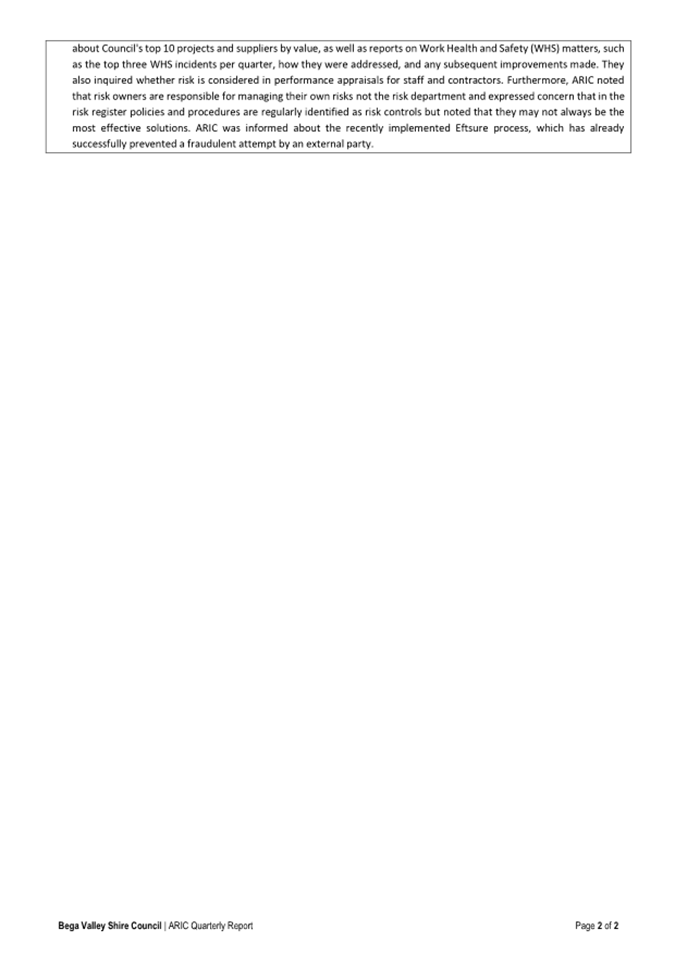
|
Item 10.7 |
10.7. Delegations from Council to the Mayor, Chief Executive Officer and Committees
This report seeks Council’s approval to support the proposed delegation policy, endorse the revised delegation manual and adopt instrument of delegation to the Chief Executive Officer (CEO).
Director Business & Governance
1. That Council place the new draft policy ‘6.28 delegations’ on public exhibition for period of 28 days and accept submissions from the community for a 42-day period.
2. That a further report be presented to Council on any submissions received, or if no submissions are received, the exhibited document be adopted and published on Council’s website.
3. That Council adopt the revised manual for delegations from Council to the Mayor, CEO, and Committees.
4. That Council adopt the proposed instrument of delegation for the CEO.
Executive Summary
Council is required to review its delegations within the first 12-months of a local government election. Council’s current delegations are recorded in 2 parts: the first in a register for the Mayor, CEO, and Committees. The second in a register of sub-delegations from the CEO to other council officers. Both parts of the delegation register are currently available to the public on Council’s website.
As part of the review, a new delegation framework is being proposed that consists of a delegation policy, procedure, delegation manual, register, and instrument of delegation. The draft policy is attached to this report along with copies of the revised delegation manual and a copy of the instrument of delegation to the CEO. The procedures are not attached to this report because they are not changing.
Implementation of the proposed framework will ensure compliance with Section 380 of the Local Government Act 1993, improve management of delegations, and contribute to transparent decision-making and accountability across the organisation. It will also contribute to more efficient and effective services to the community by informing council officers of their roles and responsibilities.
Background
Local government delegations are crucial for demonstrating a transparent decision-making process that shows how decisions are made and who is involved. Delegations provide clear accountability, contribute to robust performance management, communicate clear roles and responsibilities, and support legal and financial compliance.
The current model consists of a delegations register that is presented in 2 parts. The first is for delegation for the Mayor, CEO, and Committees, which sets out the general powers of the Council to delegate in accordance with the Act. The second part is for sub-delegations made by the CEO to other council officers. It sets out delegation to staff from the CEO.
To meet the requirements of Section 377 of the Local Government Act 1993 (the “Act”), it is proposed to establish a delegation framework that consists of:
· policy 6.28 delegations
· procedure 6.01.05 delegations to Mayor, Chief Executive Officer (CEO), and staff
· a delegation manual
· a delegation register, and
· an instrument of delegation for relevant council officers.
In accordance with Section 380 of the Act, Council must review all its delegations during the first 12-months of each term of office. A review has been completed and the amended delegations to the Mayor, CEO and Committees is presented with this report. As part of the review, it is also being proposed to adopt a delegation policy and an instrument of delegation for the CEO. Once considered and adopted by Council, the policy, delegation manual, instrument of delegation, and delegation register will be made available on Council’s website.
The review of delegations aligns with information provided through Council’s legal delegations subscription. The subscription commenced in July 2021 and provides Council with bi-annual updates to any legislative amendments that affect delegations.
Options
Council resolve to place the draft policy on public exhibition, and adopt the delegation manual, and instrument of delegation as attached to this report. Recommended.
Council could update or amend the proposed policy 6.28, delegation manual, and instrument of delegation attached to this report before resolving on the delegations to the Chief Executive Officer.
Community and Stakeholder Engagement
Once adopted by Council, the delegation manual, register of delegations, and instrument of delegations will be publicly available. Draft policy 6.28 delegations will need to be placed on public exhibition for period of 28 days. Submissions will be received for a period of 42 days. Once adopted, the policy will be published on Council’s website.
Engagement undertaken
When preparing this report and the documents presented, council officers consulted with various internal and external stakeholders. The Local Government NSW Governance Network was engaged for the purpose of resource and information sharing. Other councils within the network were asked to share their delegation framework and management processes.
Council has a legal delegation subscription with Kell Moore, who are an approved legal delegation provider in local government. Council officers engaged and consulted with representatives from Kell Moore to develop and review the delegation manual and instrument of delegation attached to this report.
Engagement planned
It is proposed to place the draft policy 6.28 delegations on public exhibition.
If the policy, delegation manual, and instrument of delegations are adopted, further internal engagement will be undertaken to implement the framework. Council officers will receive training in how to administer their delegations.
Council officers will also continue to engage with external stakeholders through the legal delegation subscription. This continued engagement will support the organisation to update and manage delegation to the Mayor, CEO, Committees, and staff on a bi-annual basis.
Financial and Resource Considerations
Management of Council’s delegation framework is included in the adopted budget and forms part of the core services of Council’s People and Governance section, senior staff, and managers.
Legal /Policy
As part of this report, it is being proposed to adopt a delegation framework which consists of:
· policy 6.28 delegation
· procedure 6.01.05 delegation to the Mayor, CEO, and Committees
· the delegation register
· the delegation manual
· instruments of delegation
Parts 1 and 2 of the register of delegations has been reviewed by lawyer Kell Moore, who provided recommendations that have informed the updates made to the delegation manual attached to this report.
The implementation and review of the delegation framework is a requirement of Section 380 of the Local Government Act 1993.
To help ensure compliance with the Act, the Director of Business and Governance will lead the internal review of the delegation framework within the first 12 months of a council election. The delegation manual and instrument of delegation to the CEO will also be reviewed within the first 12-months of a council election or as required.
To facilitate the maintenance and review of the delegations, the delegation manual, register of delegations, and instrument of delegations are included in Council’s document control register.
If adopted the delegation policy will be reviewed in accordance with Council policy review schedule. This will be reviewed and updated within the first 12-months of a council election or as required.
The register of delegation will be reviewed on a bi-annual basis on the advice of Kell Moore, Council’s legal delegation provider.
Impacts on Strategic/Operational/Asset Management Plan/Risk
Strategic Alignment
Review of Council’s delegations aligns with the following operational plan and delivery program items:
· Community Strategy
Plan (CSP) Strategy
Council has a governance framework that promotes and guides accountability and
transparency.
· Delivery Program
Develop and implement good governance systems
· Operational Plan
Activity
Review council procedures in accordance with adopted policy and procedure
review schedule.
Environment and Climate Change
There are no environment and climate change considerations associated with the recommendations of this report.
Economic
There are no economic considerations associated with the recommendations of this report.
Risk
There are several risks that must be considered with this report. Reputational risk is one consideration. Implementing the proposed delegation framework will help improve transparency and accountability concerning our decision-making. Not having the framework will increase legal risks associated with non-compliance of the Local Government Act 1993. Through the regular review and monitoring of delegations, legal risks associated with non-compliance to other pieces of legislation is also mitigated.
Social / Cultural
There are social and cultural considerations relating to the recommendations of this report. If the proposed delegation framework is adopted, it will have an impact on the internal operations of council. The impacts will be minimal and will be mitigated through various training and development activities that will be delivered by the People and Governance Section. General awareness of delegations will be included in the employee onboarding and induction processes. Training will also be provided to staff through Council’s Learning Management System (LMS). The delivery of training will support the implementation of the improved framework.
Attachments
1⇩. DRAFT Policy 6.28 Delegations
2⇩. Delegations to the CEO, Mayor and Committees version 18_Draft
3⇩. 03/03/2025 instrument of delegation to the CEO unsigned
|
19 March 2025 |
|
|
Item 10.7 - Attachment 2 |
Delegations to the CEO, Mayor and Committees version 18_Draft |
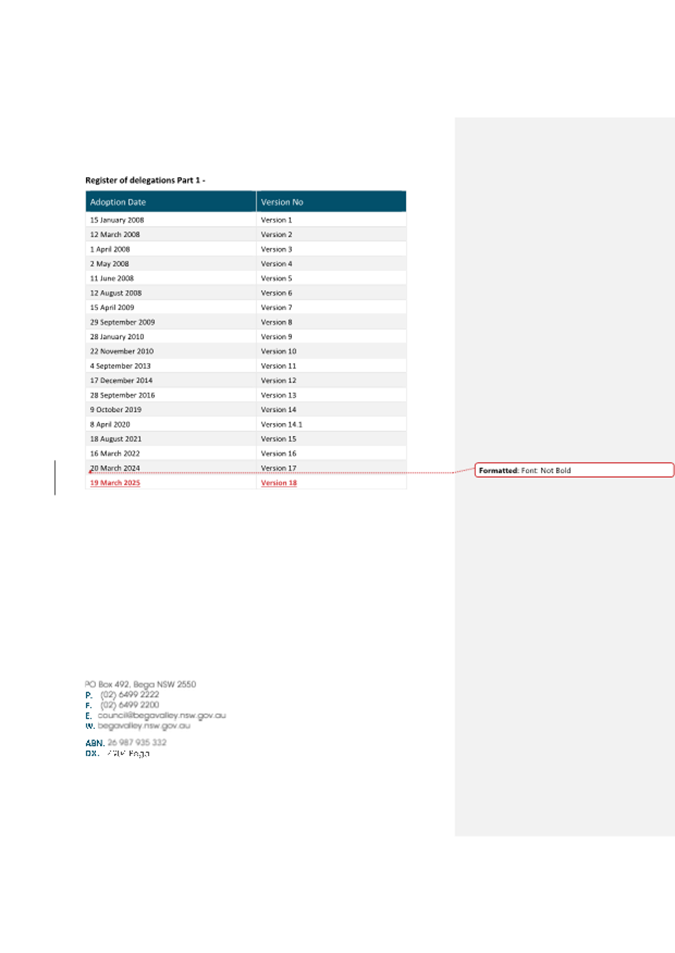
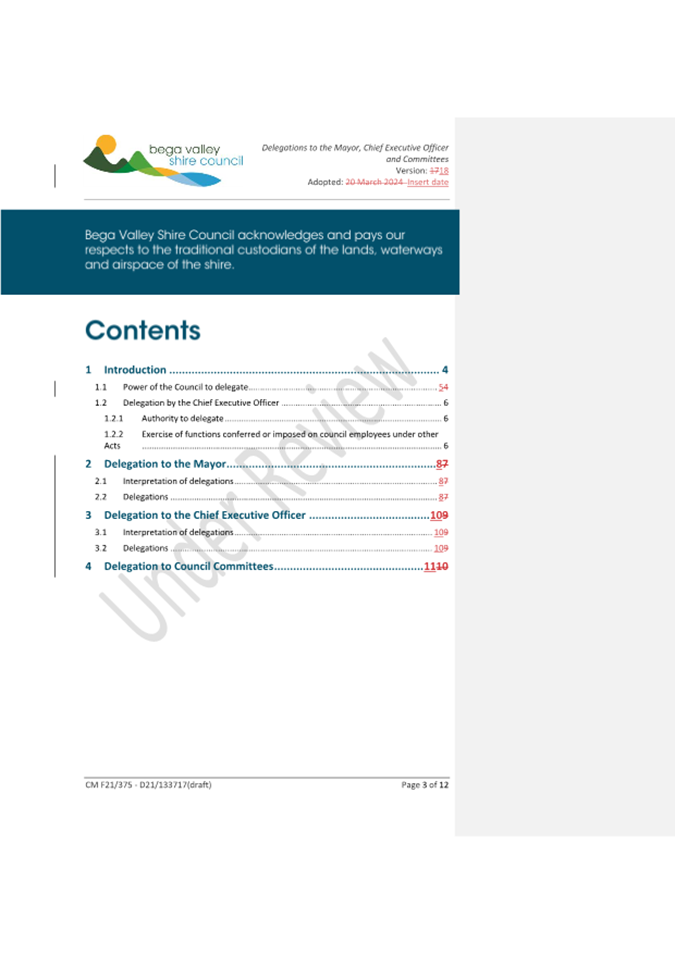
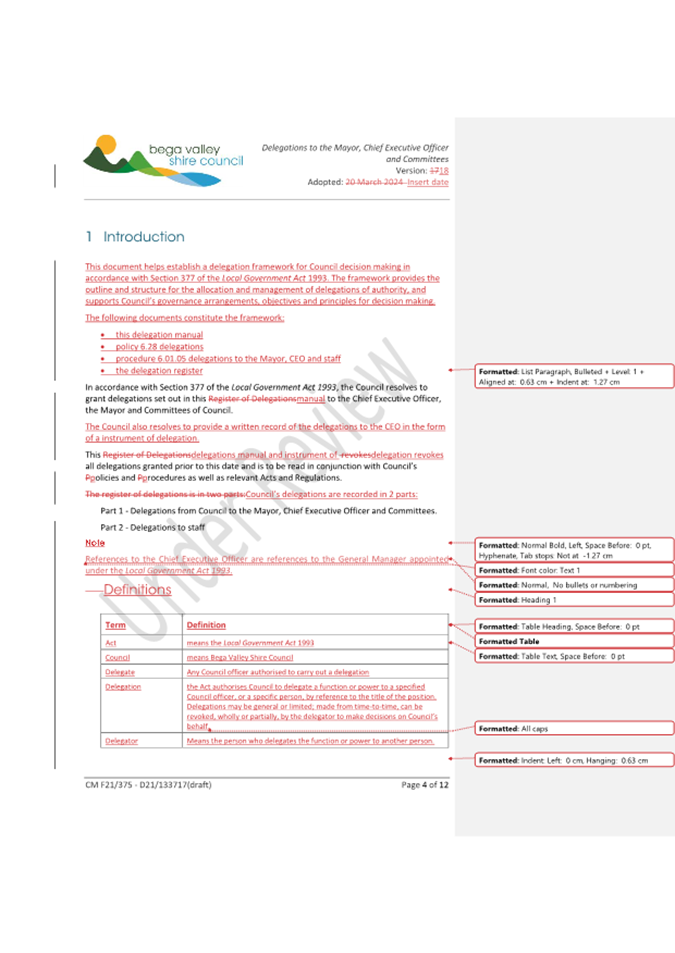
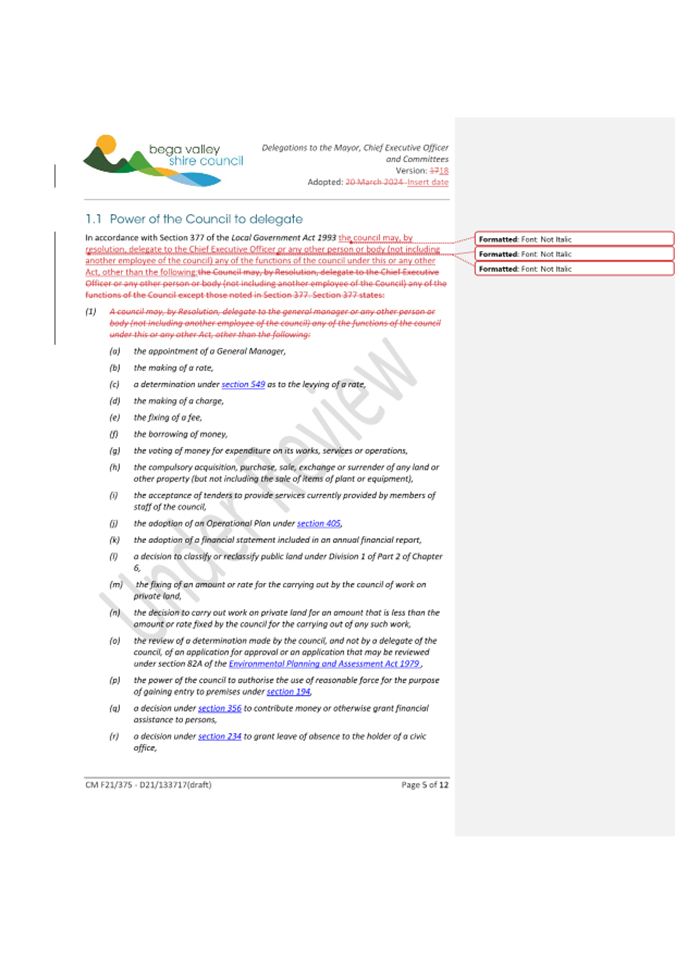
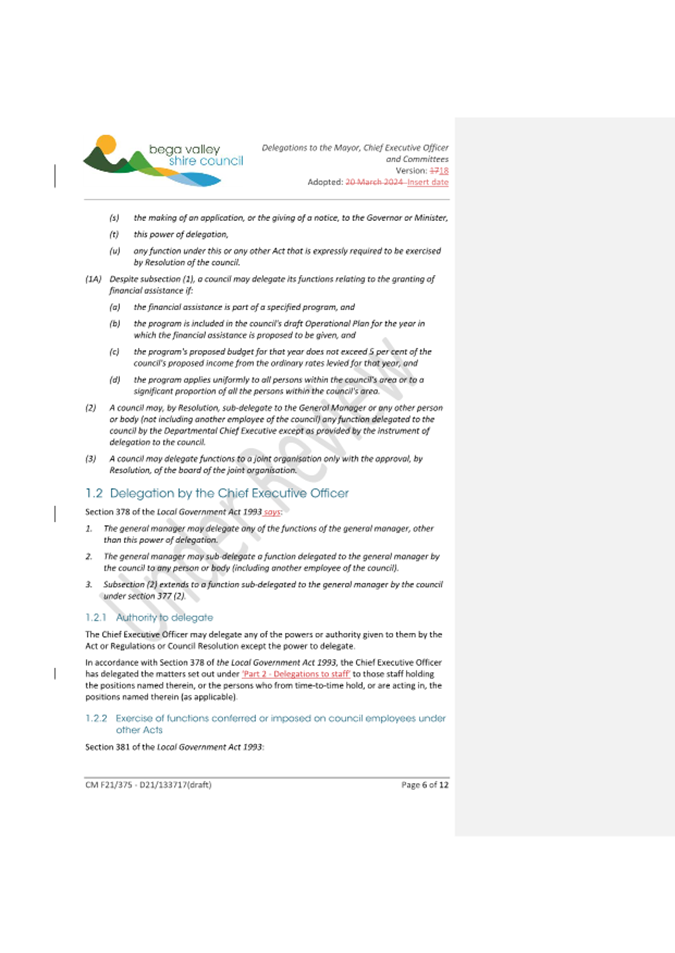
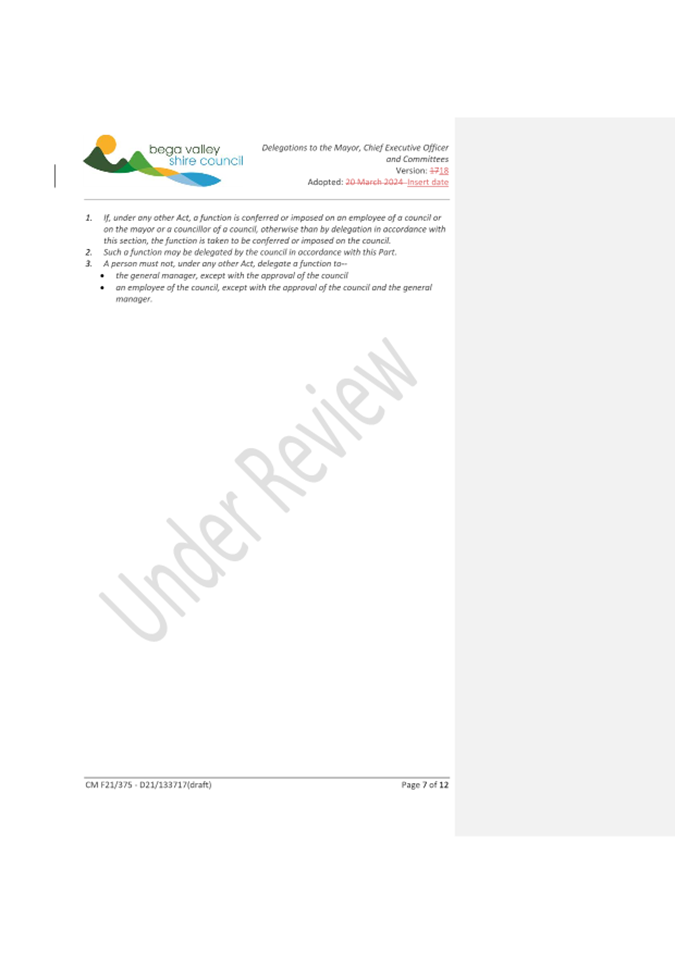
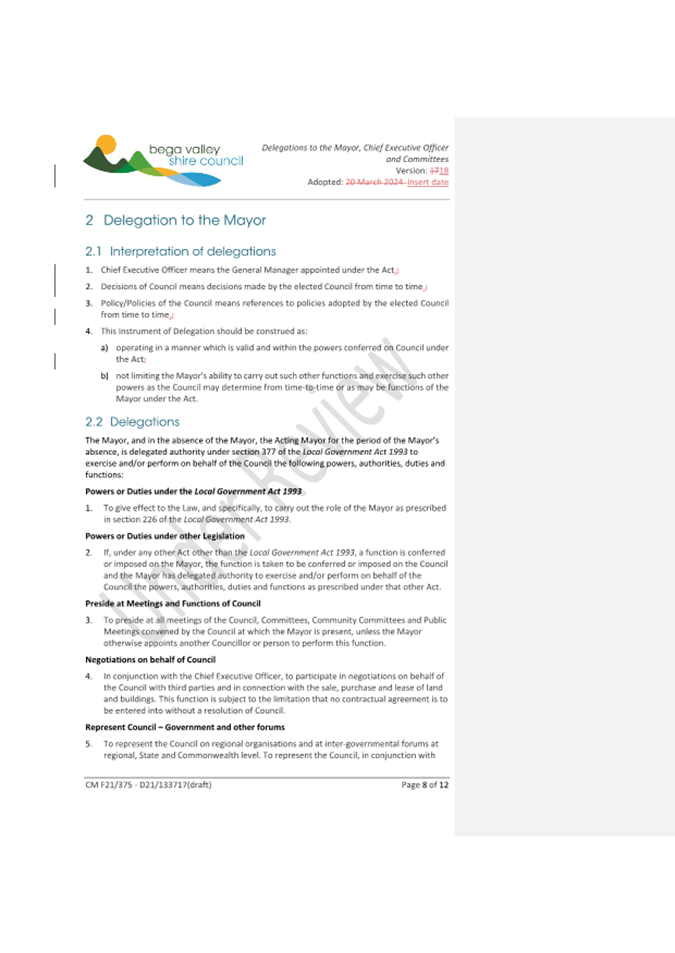
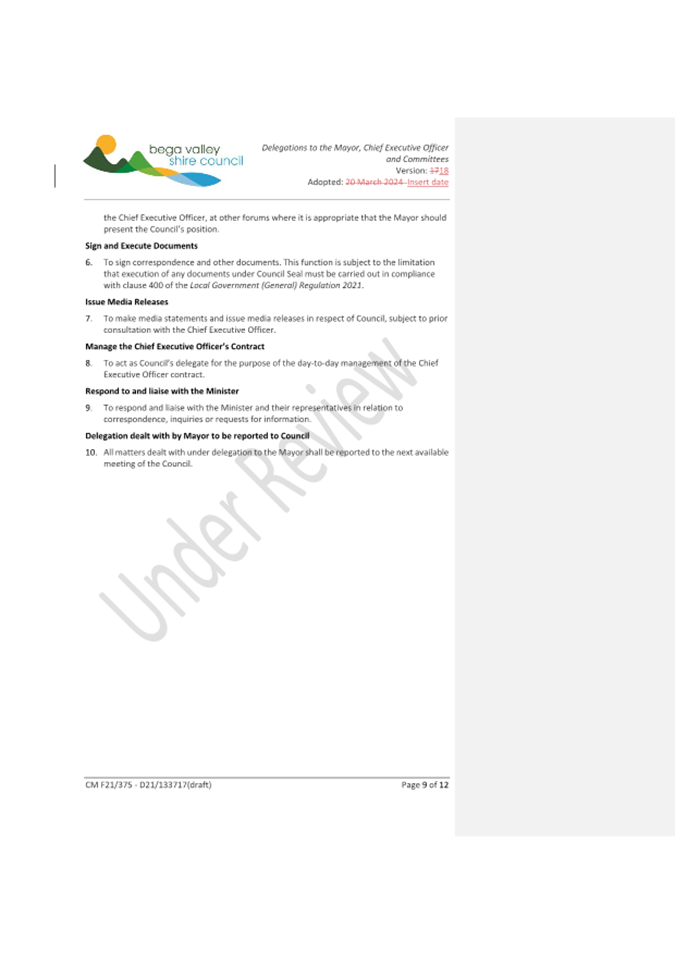
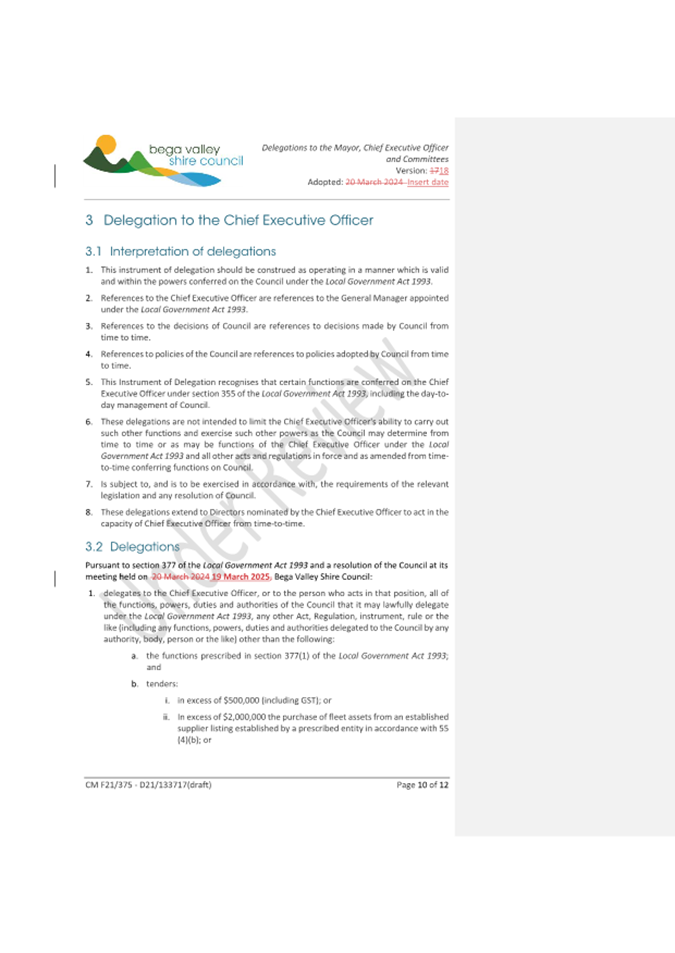
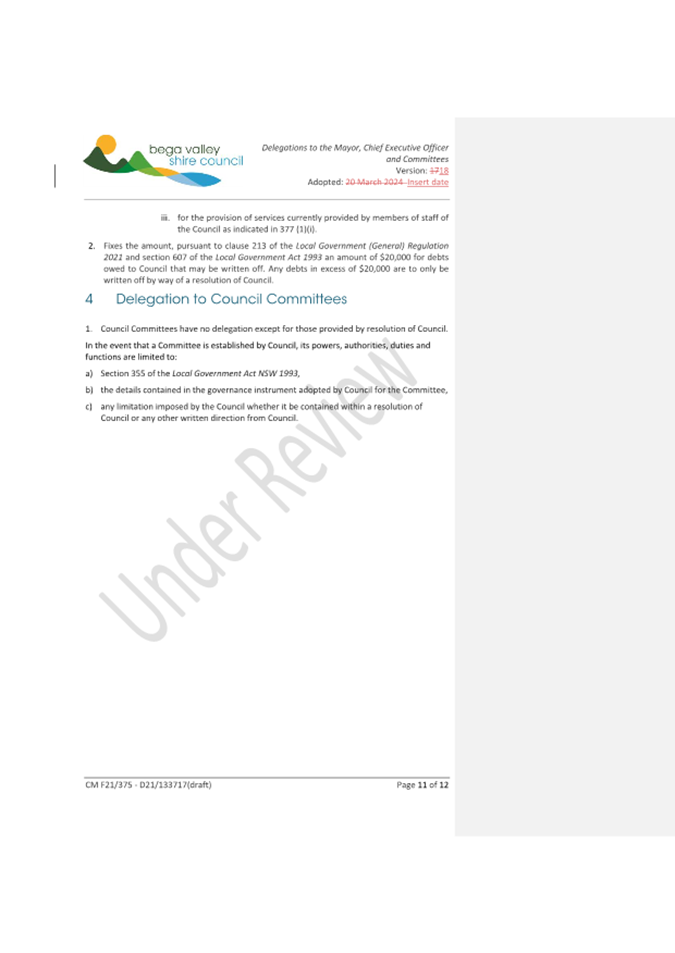

|
19 March 2025 |
|
|
Item 10.7 - Attachment 3 |
03/03/2025 instrument of delegation to the CEO unsigned |

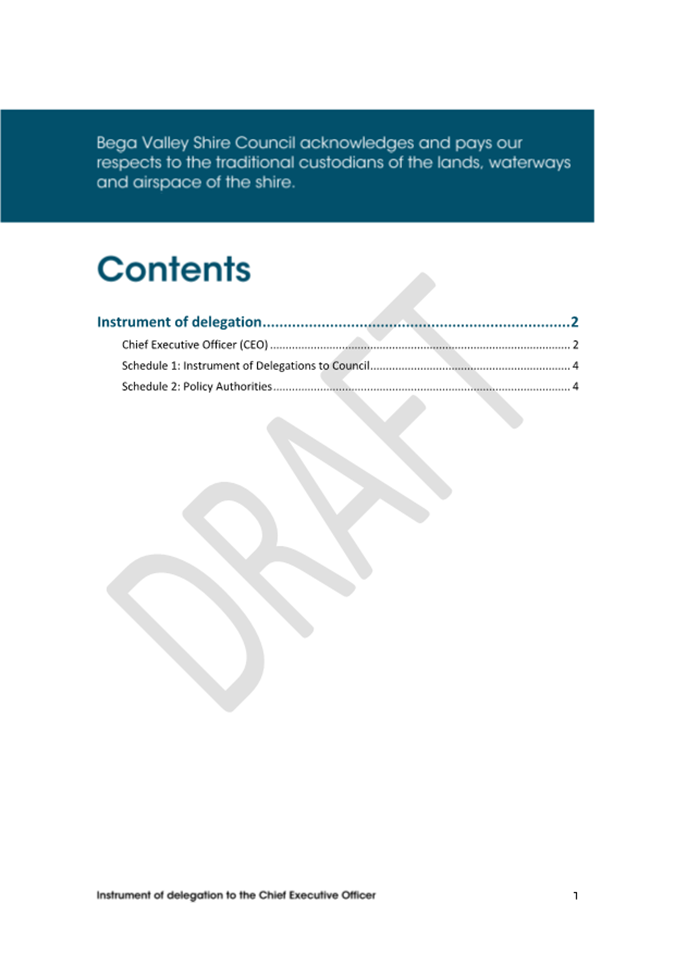
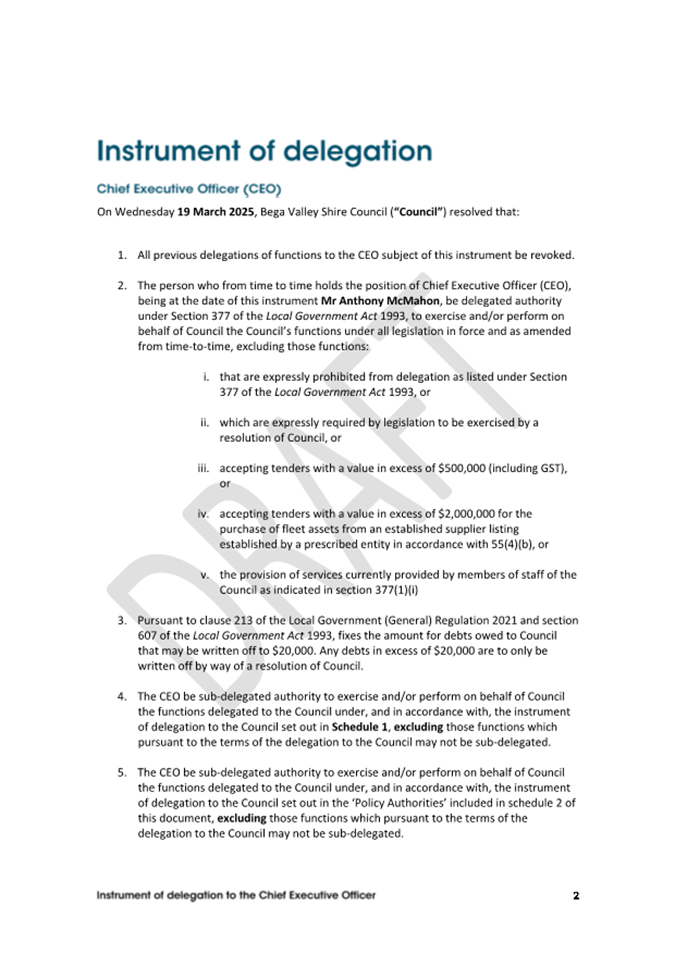
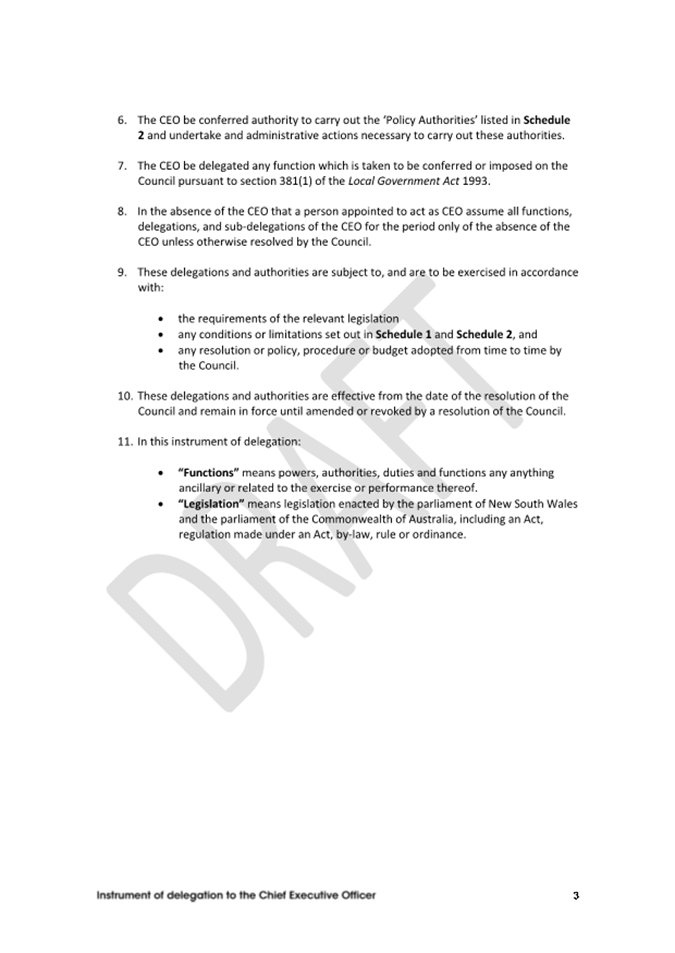
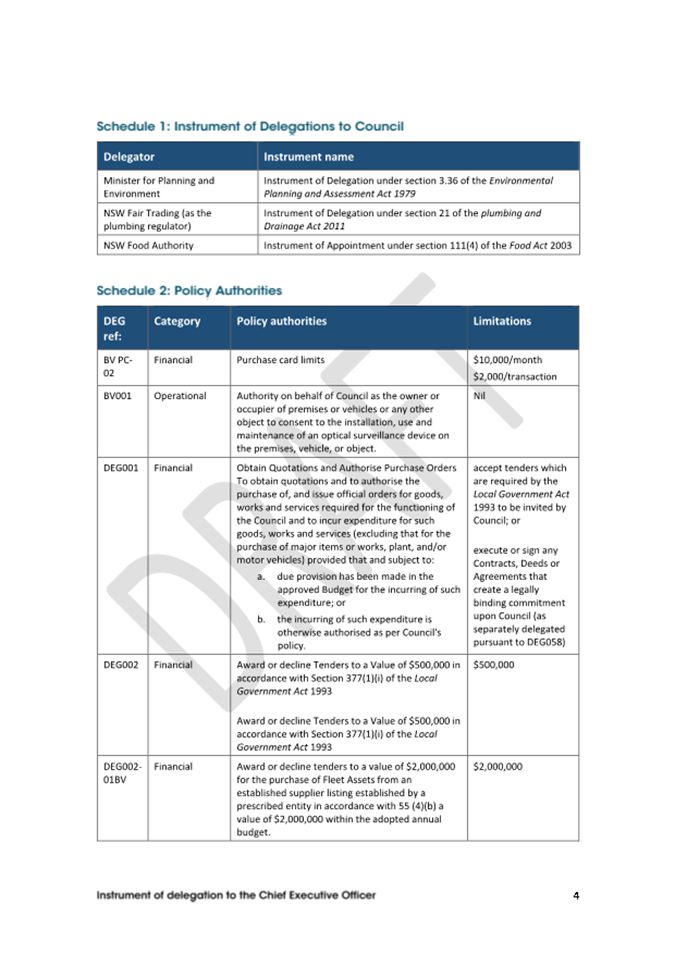
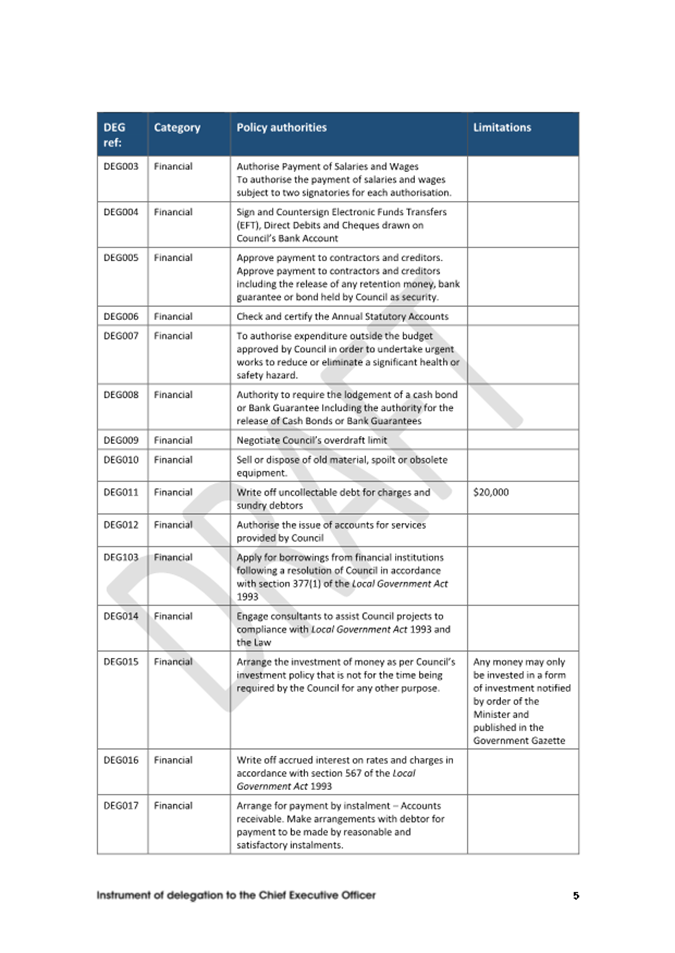
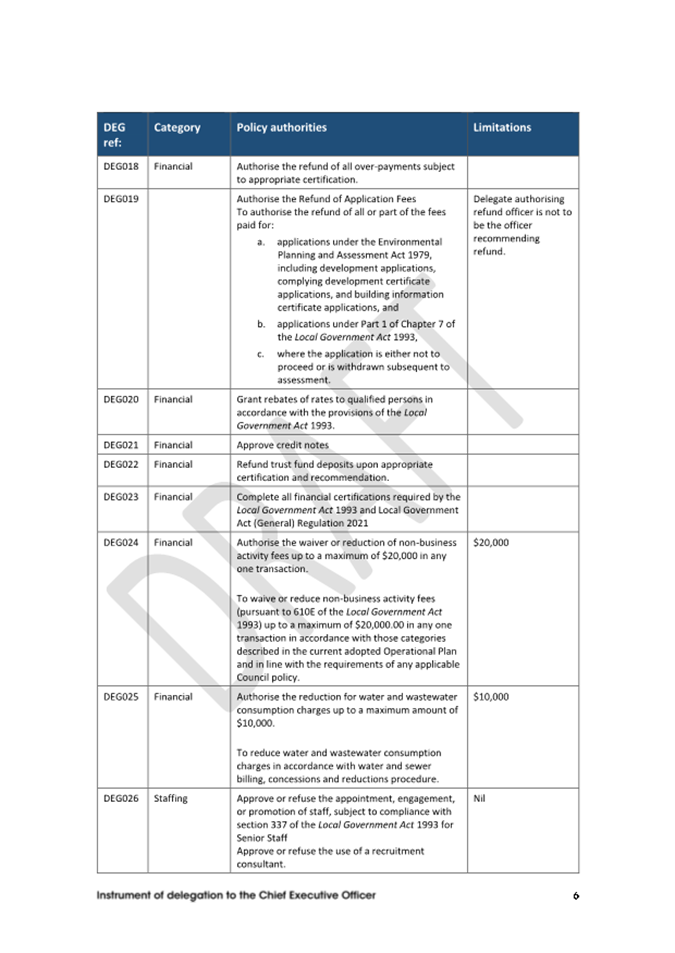
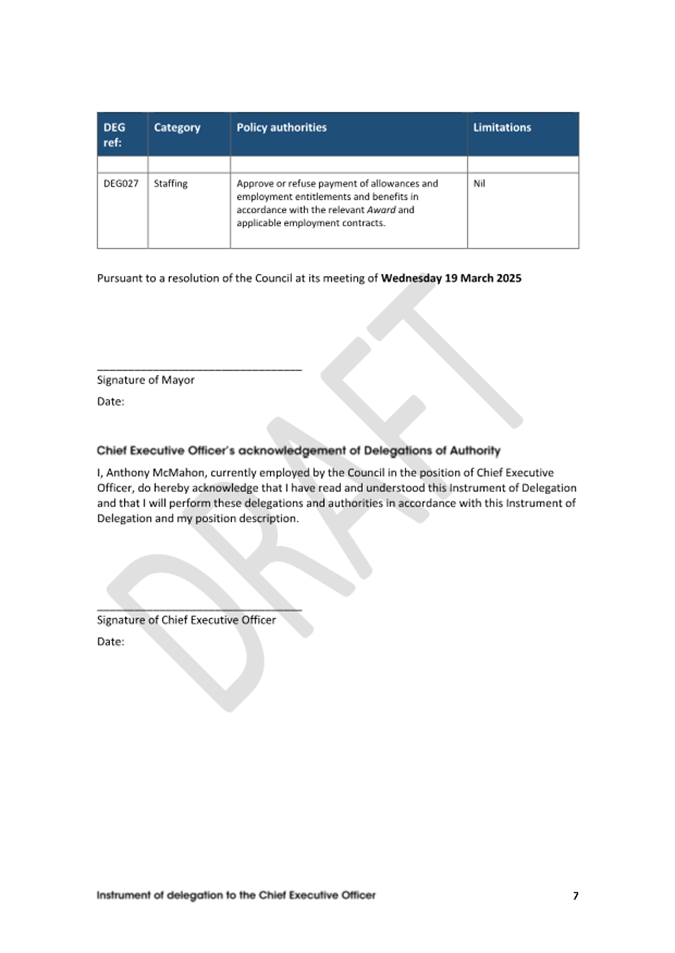

|
Item 10.8 |
10.8. Certificate of Investment February 2025
This report details Council’s cash and investments at 28 February 2025.
Director Business & Governance
1. That Council receive and note the report on Council’s investment position at 28 February 2025.
2. That Council notes the certification of the Responsible Accounting Officer.
Executive Summary
I, Judy Jordan, as the Responsible Accounting Officer of Bega Valley Shire Council, hereby certify the investments listed in the attached reports have been made in accordance with Section 625 of the Local Government Act 1993 (the LG Act), clause 212 of the Local Government (General) Regulation 2021.
On 28 February 2025 the total capital value of cash and investments was $154,337,828.71 with 88% of Council’s investment portfolio directed to term deposits and the remainder held in cash deposit accounts. The following is investment information by fund:
|
Fund |
February-2025 ($’000) |
|
General Fund |
59,313 |
|
Water Fund |
27,846 |
|
Sewer Fund |
67,179 |
|
TOTAL |
154,338 |
All investments have been appropriately recorded in Council’s financial records, reconciled monthly.
Background
The Local Government Act 1993 and Local Government Regulation 2021 require that the Responsible Accounting Officer must present to Council monthly, the status of the investments held by Council. The Responsible Accounting Officer must detail the investments held, and their compliance with both internal policy and external regulation under the Ministerial Order of Investments.
Options
This is a receive and note report and does not require consideration of options for decision.
Community and Stakeholder Engagement
Engagement undertaken
There is no community or stakeholder engagement associated with the recommendation of this report.
Engagement planned
The investment details of Council are published in Council business papers and are publicly available at Council offices and on Council’s website.
Financial and Resource Considerations
A list of Council’s cash and investments held at 28 February 2025 is detailed below:
|
Table 1: Cash and Investments listing |
||||||
|
Issuer |
Rating |
Type |
Purchase |
Maturity |
Interest Rate (%) |
Capital Value ($) |
|
Commonwealth Bank (Operating cash account) |
AA- |
CASH |
- |
- |
4.10 |
8,195,309.40 |
|
Commonwealth Bank (At Call cash account) |
AA- |
CASH |
- |
- |
4.15 |
10,000,000.00 |
|
NSW Treasury Corporation (Strategic Cash Fund) |
AA- |
CASH |
- |
- |
- |
142,519.31 |
|
Suncorp Bank |
AA- |
TD |
30/11/2023 |
11/03/2025 |
5.40 |
2,000,000.00 |
|
NAB |
AA- |
TD |
11/03/2024 |
11/03/2025 |
5.07 |
5,000,000.00 |
|
ING Bank (Australia) Ltd |
A |
TD |
15/04/2024 |
15/04/2025 |
5.19 |
5,000,000.00 |
|
Australian Military Bank |
BBB+ |
TD |
31/03/2023 |
16/04/2025 |
4.50 |
3,000,000.00 |
|
Suncorp Bank |
AA- |
TD |
30/11/2023 |
13/05/2025 |
5.40 |
3,000,000.00 |
|
ING Bank (Australia) Ltd |
A |
TD |
28/05/2024 |
28/05/2025 |
5.27 |
3,000,000.00 |
|
ING Bank (Australia) Ltd |
A |
TD |
31/05/2024 |
30/05/2025 |
5.31 |
1,000,000.00 |
|
BankVic |
BBB+ |
TD |
28/06/2023 |
17/06/2025 |
5.65 |
2,000,000.00 |
|
BOQ |
A- |
TD |
18/12/2024 |
18/06/2025 |
5.20 |
3,000,000.00 |
|
NAB |
AA- |
TD |
29/07/2024 |
29/07/2025 |
5.30 |
2,000,000.00 |
|
Suncorp Bank |
AA- |
TD |
31/07/2023 |
31/07/2025 |
5.18 |
3,000,000.00 |
|
NAB |
AA- |
TD |
31/01/2024 |
26/08/2025 |
4.95 |
3,000,000.00 |
|
BankVic |
BBB+ |
TD |
05/06/2024 |
05/09/2025 |
5.33 |
1,000,000.00 |
|
Westpac |
AA- |
TD |
11/09/2023 |
11/09/2025 |
4.99 |
2,000,000.00 |
|
BankVic |
BBB+ |
TD |
29/07/2024 |
25/09/2025 |
5.30 |
2,000,000.00 |
|
Suncorp Bank |
AA- |
TD |
18/12/2024 |
15/10/2025 |
5.05 |
3,000,000.00 |
|
Westpac |
AA- |
TD |
31/10/2023 |
31/10/2025 |
5.41 |
2,000,000.00 |
|
Westpac |
AA- |
TD |
29/06/2023 |
25/11/2025 |
5.10 |
2,000,000.00 |
|
Suncorp Bank |
AA- |
TD |
28/11/2023 |
28/11/2025 |
5.38 |
3,000,000.00 |
|
Westpac |
AA- |
TD (G) |
29/02/2024 |
16/12/2025 |
4.88 |
5,000,000.00 |
|
BOQ |
A- |
TD |
11/01/2024 |
12/01/2026 |
4.85 |
2,000,000.00 |
|
NAB |
AA- |
TD |
18/12/2024 |
14/01/2026 |
4.97 |
5,000,000.00 |
|
NAB |
AA- |
TD |
28/01/2025 |
28/01/2026 |
4.90 |
2,500,000.00 |
|
Westpac |
AA- |
TD (G) |
08/02/2024 |
09/02/2026 |
4.84 |
5,000,000.00 |
|
ING Bank (Australia) Ltd |
A |
TD |
11/03/2024 |
11/03/2026 |
4.85 |
5,000,000.00 |
|
NAB |
AA- |
TD |
18/12/2024 |
15/04/2026 |
4.89 |
2,000,000.00 |
|
Westpac |
AA- |
TD |
28/06/2024 |
28/04/2026 |
5.20 |
2,500,000.00 |
|
ING Bank (Australia) Ltd |
A |
TD |
25/09/2024 |
25/05/2026 |
4.53 |
5,000,000.00 |
|
BOQ |
A- |
TD |
31/01/2024 |
26/05/2026 |
4.80 |
2,000,000.00 |
|
Westpac |
AA- |
TD |
25/02/2025 |
15/06/2026 |
4.62 |
5,000,000.00 |
|
BOQ |
A- |
TD |
28/05/2024 |
28/07/2026 |
5.00 |
5,000,000.00 |
|
ING Bank (Australia) Ltd |
A |
TD |
26/08/2024 |
18/08/2026 |
4.62 |
3,000,000.00 |
|
Westpac |
AA- |
TD |
06/09/2023 |
07/09/2026 |
4.88 |
3,000,000.00 |
|
NAB |
AA- |
TD |
26/11/2024 |
05/11/2026 |
4.80 |
3,000,000.00 |
|
BOQ |
A- |
TD |
28/05/2024 |
26/11/2026 |
4.95 |
5,000,000.00 |
|
Hume Bank |
BBB+ |
TD |
26/08/2024 |
08/12/2026 |
4.55 |
5,000,000.00 |
|
Suncorp Bank |
AA- |
TD |
11/01/2024 |
11/01/2027 |
4.88 |
2,000,000.00 |
|
NAB |
AA- |
TD |
25/02/2025 |
25/02/2027 |
4.55 |
5,000,000.00 |
|
ING Bank (Australia) Ltd |
A |
TD |
25/09/2024 |
25/03/2027 |
4.50 |
2,000,000.00 |
|
NAB |
AA- |
TD |
26/02/2025 |
05/04/2027 |
4.50 |
5,000,000.00 |
|
Westpac |
AA- |
TD |
28/02/2025 |
16/06/2027 |
4.50 |
3,000,000.00 |
|
BOQ |
A- |
TD |
28/02/2025 |
13/10/2027 |
4.50 |
2,000,000.00 |
|
ING Bank (Australia) Ltd |
A |
TD |
28/02/2025 |
28/02/2029 |
4.70 |
2,000,000.00 |
|
Total cash and investments |
$154,337,828.71 |
|||||
|
Table 2: Interest from Cash and Investments |
|
|
Interest earned for February 2025 |
$498,495 |
|
Financial year to date interest earned |
$4,274,541 |
|
Revised Budgeted interest for 2024/2025 financial year (QBRS Q2) |
$4,000,000 |
|
Percentage of the 2024/2025 budget earned by Council |
107% |
Council’s investment portfolio is largely directed towards term deposits (88%). The remainder of the portfolio is held in cash deposit accounts with CBA and TCorp (12%).
The investments held by Council remain sufficiently liquid with 57% of investments maturing within the next 12 months.
Council’s cash and investment portfolio has a weighted average maturity of 350 days.
For the month of February, the investments held by Council provided a return of 5.11% p.a. This annualised performance exceeded the monthly RBA cash rate of 4.10% and the AusBond Bank Bill index of 4.51%. The below table represents the annualised performance of council’s investment portfolio.

With the potential for additional interest rate cuts in the future and the maturing of higher yielding term deposits over the next 9 months Council has been attempting to lock in rates across 1–5-year tenors. This aims to provide some protection against potential lowering rates.
Council’s total cash and investment balance has increased by $13m during February 2025. This has been the impact of the rates instalment period and receiving outstanding government grants.
Council continues to utilise the platform Imperium Markets, to assist in conducting, managing, and reporting on Council’s investments. This provides an automated process of sourcing quotes and investing monies which is allowing Council to better address investment risks. Additional to the platform, Arlo Advisory provide investment advice on the surrounding market conditions and how Council can maximise returns within the Ministerial Order and Council’s investment policy.
|
Table 3: Investments by Fund $’000 |
|||
|
December-2024 |
January-2025 |
February-2025 |
|
|
General Fund |
51,728 |
49,665 |
59,313 |
|
Water Fund |
27,140 |
27,259 |
27,846 |
|
Sewer Fund |
64,308 |
64,558 |
67,179 |
|
TOTAL |
143,176 |
141,482 |
154,338 |
Each Fund’s allocation can only be utilised for its specific operations. For example, Water Fund cannot use its financial resources on General Fund projects.
Included in the General Fund investments are amounts that are externally restricted for specific purposes, i.e. contributions and unspent grants. In addition, there are amounts that are internally restricted by Council.
The value of outstanding government grant debtors on 28 February 2025 is $1,970,790 with $494,142 aged 4+ months. Council continues to work with our funding partners to reduce these debts.
Legal /Policy
Section 625 of the Local Government Act 1993 (LG Act) determines money may only be invested in a type of investment authorised by Order of the Minister for Local Government and published in the Local Government Gazette. The current Ministerial Order of Investment was published 17 February 2011.
Clause 212 of the Local Government (General) Regulation 2021 (LG Regulations) determines the Responsible Accounting Officer must provide Council with a written report setting out details of all money Council has invested under Section 625 of the LG Act.
The report must also include a Certificate as to whether the investments have been made in accordance with the LG Act, LG Regulations and Council’s Investment Policy.
Council has an Investment Policy (policy number 6.07) adopted on 27 November 2024. The policy is reviewed every four years by Council and annually by Council officers.
Impacts on Strategic/Operational/Asset Management Plan/Risk
Strategic Alignment
This report is provided in accordance with Council’s Community Strategic Plan (CSP), Delivery Program (DP) and Operational Plan (OP).
CSP Strategy: E.4 Council has robust financial management processes to ensure ongoing viability and value for money.
Delivery Program: E4.2 - Ensure Council’s revenue streams are maximised.
Operational Plan: Finance - core business: Manage Council’s borrowings and investments in accordance with council’s financial strategy.
Environment and Climate Change
Council considers the importance of environmental, social and governance factors in investment decision making.
As at 28 February 2025, Council’s investment portfolio included $10 million of green certified investments.
Economic
Council’s investment policy objective is to maximise returns by investing with the most favourable rate of return. Performance of investments are reported monthly, quarterly and annually.
Risk
Council policies have strict guidelines to reduce Council’s risk to capital. The following graphs provide representation of Council’s compliance to these measures.
Risk management means our investments are made giving regard to key criteria of counterparty, credit quality and maturity compliance.
At 28 February 2025, all cash and investments held are within the counterparty, credit quality and maturity policy limits.
Other legal instruments, such as the Ministerial Order referenced above, are also being used to mitigate financial risk.
Legend: Compliant Non-compliant
Counterparty Compliance
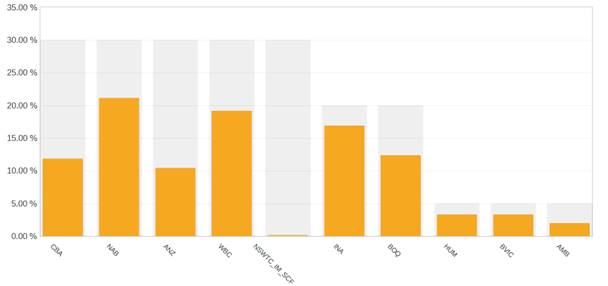
Credit Quality Compliance

Maturity Compliance

Social / Cultural
Maximising performance of returns enables the organisation to leverage additional funding received as a result of investment performance and use these towards community projects, programs and services.
Attachments
Nil
|
Council |
19 March 2025 |
Notices of Motion
19 March 2025
13.1 Fluoridation of the Shires Water Supply........................................................... 389
13.2 Cattle Crossing Safety........................................................................................ 391
13.3 Merimbula Central Business District (CBD) playground................................... 392
|
Council 19 March 2025 |
Item 13.1 |
13.1. Cr David Porter - Fluoridation of the Shires Water Supply
That Council write to the NSW Secretary for Health, Susan Pearce and request the following information:
a. An updated position of the State Government with regards to the safety and long term health effects of mass Fluoridation in water supplies.
b. That the State Government provide facts based evidence that can debunk the finding of the US courts, specifically the case of Food and Water Watch et al. v. United States Environmental Protection Agency et al. 17-cv-02162-EMC
c. Given the new information related to the potential dangers of fluoride, at what level of fluoridation (mg per litre) in water supplies does the NSW Government guarantee is completely safe from any negative effects to consumers, especially children and pregnant women.
d. That the response is reported back to council.
Background
Council approved the expansion of fluoridation the Cobargo/Bermagui water supply back in 2018, this was to be done upon upgrading the water supply and installation of a filtration system. Public funding was sourced through the State Government for these upgrades, and now 7 years on with the filtration system and upgrades completed and operational the addition of fluoridation commenced on the 3 March 2025.
During this seven-year timeframe there has been a significant shift in public knowledge and awareness on fluoridation and its benefits/ harms.
Notwithstanding evidence fluoride is recognised to be of benefit to reduction in tooth decay, evidence has been produced to show it is a neurotoxin and can cause brain damage and reduction of IQs in children. Most vulnerable to the effects of fluoride are infants and pregnant mothers.
A landmark Federal court case in the US has determined that substantive evidence shows.
"The issue before this Court is whether the Plaintiffs have established by a preponderance of the evidence that the fluoridation of drinking water at levels typical in the United States poses an unreasonable risk of injury to health of the public within the meaning of Amended TSCA. For the reasons set forth below, the Court so finds. Specifically, the Court finds that fluoridation of water at 0.7 milligrams per liter (“mg/L”) – the level presently considered “optimal” in the United States – poses an unreasonable risk of reduced IQ in children. The Court finds there is an unreasonable risk of such injury, a risk sufficient to require the EPA to engage with a regulatory response…One thing the EPA cannot do, however, in the face of this Court’s finding, is to ignore that risk.”
The Court case went for 7 years, and the EPA had every opportunity to refute the evidence and did not. They have not appealed.
The recently appointed US Secretary of Health & Human Services (HHS) has publicly stated his desire and ambition to remove fluoride from the drinking water.
Currently only 5% of the world today is fluoridated and reducing quickly.
Our fluoridation levels are higher than in the US of .7 mg per litre
Here in NSW 1-1.5mg per litre (near double)
Given these findings of the US Federal court and the public awareness and consciousness shift from 7 years ago, it is appropriate to ensure our community gain irrefutable evidence and reassurance of no harm associated with the consumption of fluoride.
Cr David Porter
Attachments
Nil
|
Council 19 March 2025 |
Item 13.2 |
13.2. Cr David Porter - Cattle Crossing Safety
That staff report back to Council on options for grant funded improvements to the electronic signage, crossing underpass, or any other way to improve the safety of motorists at the cattle crossing on Tathra- Bega Road west of Dacy Lane, Jellat Jellat.
Background
There is a Cattle Crossing on Tathra Road at Jellat Jellat, just west of the Jellat flats that has been in use multiple times a day for several generations. The Cattle Crossing is on a small straight stretch between two crests and have old signs that are opened/closed manually by the farmer before and after the cattle cross.
With major housing releases such as Kalaru to Tura Beach the volume of traffic on Tathra Road has increased significantly resulting in ques of traffic now frequently extending back to the crest.
The recent speed zone reduction on Jellat flats (below the natural flow) has a bunching effect that results in cars coming over the crest with a reduced distance between the cars as well as a raised level of frustration which reduces the ability to react to stationary vehicles just over the crest.
Last year a motorcycle rider was seriously injured when he came over the crest of the hill and ran into the back of the vehicles queued at this cattle crossing.
All other cattle crossings on Tathra Road have been converted to underpasses and the cattle crossing on Coolagalite Road which has a lower potential risk to the Tathra Road crossing has remote control flashing lights.
Leaving this crossing with old manual signs under increased traffic volumes represents a significant risk to road safety and is likely to result in casualties or fatalities.
Cr David Porter
Attachments
Nil
|
Council 19 March 2025 |
Item 13.3 |
13.3. Cr Mitchell Nadin - Merimbula Central Business District (CBD) playground
1. That council commit to renewing the Merimbula CBD playground through either replacement or significant repairs as a matter of urgency.
2. That staff seek quotes for a replacement playground of a similar type and scale that can be relocated or reused should the playground be moved to a new location in the future.
3. That staff seek quotes to repair the existing playground to enable a further 2-5 years of asset life.
4. That staff provide a report to Council outlining the above 2 options and potential funding sources.
Background
The recent decision to remove the play equipment from the Merimbula CBD area has been met with significant community concern and disappointment.
This playground is heavily used and valued by the community, and replacing the ‘end of life’ play equipment with trimmed logs for nature play is not a suitable solution.
While Council’s adopted plans, such as the SPIRE masterplan and Merimbula Transport Study, clearly indicate the playground location will change in the future, there is no set timeframe or funding for this work.
Rather than leave the community without a play space for an unknown period of time, this Notice of Motion seeks to find a cost effective interim solution to ensure a play space is provided in this location until a detailed plan is put in place.
Cr Mitchell Nadin
Attachments
Nil
|
Council |
19 March 2025 |
Questions with Notice
19 March 2025
14.1 Cr O'Neil - APZ Management - Tathra Bushfire Rebuilding Memorandum of Understanding (MoU)................................................................................................................ 394
|
Council 19 March 2025 |
Item 14.1 |
14.1. Cr O'Neil - APZ Management - Tathra Bushfire Rebuilding Memorandum of Understanding (MoU)
Cr O’Neil asked can the APZ Management - Tathra Bushfire Rebuilding Memorandum of Understanding (MoU) be made available to the public, or explain why it should remain confidential?
Chief Executive Officer, Mr Anthony McMahon advised that Council have reached out to Crown Lands and the Rural Fire Service, there is a meeting scheduled to discuss the Memorandum of Understanding and its confidentiality, a further update will be provided to Council once the meeting has occurred.
Chief Executive Officer
Staff response
The APZ Management - Tathra Bushfire Rebuilding Memorandum of Understanding is an interagency document, not intended for public distribution. The document contains maps with personal property information. Therefore, should members of the public require a copy, they can make a Government Information Public Access application under the Privacy and Personal Information Protection Act 1998 for assessment.
The NSW Rural Fire Service and the Department of Planning, Housing and Infrastructure, Crown Lands are parties to the APZ Management - Tathra Bushfire Rebuilding Memorandum of Understanding and were consulted in determining the suitability of making the document publicly available.
Attachments
Nil
|
Council |
19 March 2025 |
Questions without Notice
19 March 2025
15.1 Cr Nadin - Is there any update on discussions regarding IOR Petroleum EOI?. 396
15.2 Cr Nadin - How much was the capital infrastructure for the Brogo treatment plant to add the fluoridation and how much does it cost Council per year?........................ 397
|
Council 19 March 2025 |
Item 15.1 |
15.1. Cr Nadin - Is there any update on discussions regarding IOR Petroleum EOI?
Director Assets and Operations, Mr Ian Macfarlane took the question on notice.
Chief Executive Officer
Staff response
Following the Council meeting on 16 October 2024, Council officers wrote to IOR Aviation Pty Ltd (IOR) on 31 October 2024 to inform them of the meeting outcome and that a new 20-year lease would be issued through separate correspondence at a later date.
Council officers are continuing to work with legal representatives and consultants to develop an Agreement for Lease. However, this cannot be finalised until the location of service connections is known. IOR will require access to the lease site for investigation and survey purposes to submit a development application on the land. A development application will not be able to be lodged until the Plan of Subdivision has been registered at NSW Land Registry Services, as the design of any works would depend on knowing the boundaries for the lease site and the location of any water and sewer connections and other services.
Attachments
Nil
|
Council 19 March 2025 |
Item 15.2 |
15.2. Cr Nadin - How much was the capital infrastructure for the Brogo treatment plant to add the fluoridation and how much does it cost Council per year?
At the 19 February 2025 ordinary council meeting Cr Nadin noted there was a recent media release regarding the introduction of fluoride for the Brogo treatment plant (Brogo-Bermagui line) and asked how much the capital infrastructure for the plant was to add the fluoridation and how much it costs Council per year?
Director Assets and Operations, Mr Ian Macfarlane advised the capital infrastructure for the plant to add the fluoridation at Brogo was $176,000 and was fully grant funded but he will confirm annual operational costs.
Director Assets and Operations
Staff response
The annual operational cost is calculated as approx. $38,800.00 as described below. This figure excludes maintenance, power, or breakdowns and the initial required staff training course. It's important to note that the training course and travel and accommodation are one-off costs, and two out of the four staff members have already completed this training, as we already have fluoride in the Bega Network.
Testing is carried out daily to ensure compliance with licence requirements hence the need for an overtime component in the annualised cost.
Sodium Fluoride
· Initial Fill (100kg) plus a 3-month supply (370kg) comes to $5,273, with an additional freight cost of $682, totalling $5,955
· On average, it's $6,000 per quarter, leading to an annual chemical cost of $24,000.00
Overtime
· Overtime costs for weekends and public holidays is approx. $14,800.00
Training
· The training course is available for free for all Local Water Utilities.
· Travel and accommodation for the training course per staff member is $850.00
Capital Cost
· The installation capital costs were $176,000.00. This was fully funded by an additional grant from NSW Health in January 2025
Attachments